Thrane and Thrane A S EXPLORER-300 INMARSAT TERMINAL WITH BLUETOOTH User Manual Explorer300
Thrane & Thrane A/S INMARSAT TERMINAL WITH BLUETOOTH Explorer300
Contents
- 1. MANUAL
- 2. userts man ual
- 3. users manual
MANUAL
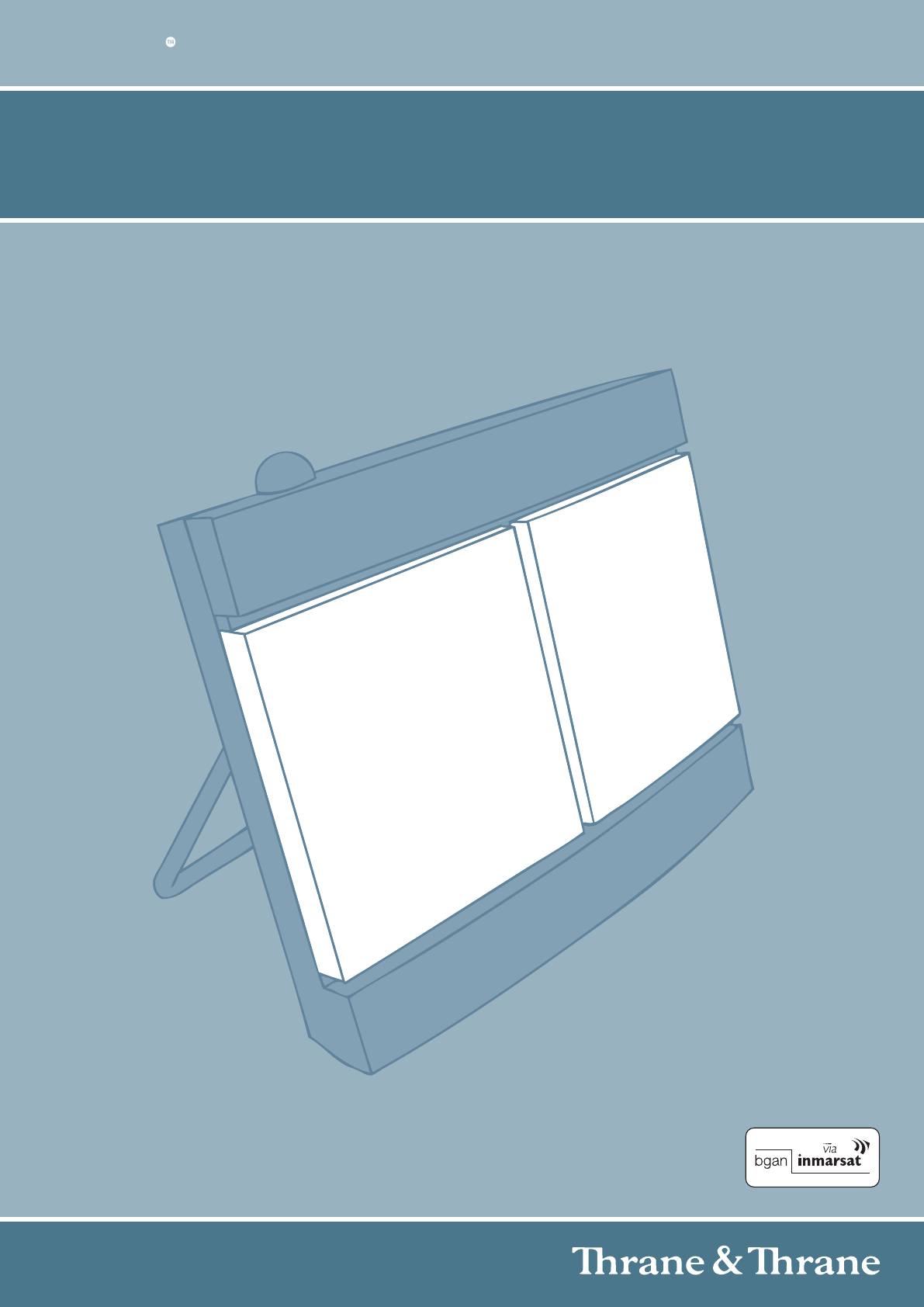
USER MANUAL
EXPLORER 300
Thrane & Thrane A/S • info@thrane.com • www.thrane.com
32573-EXP300-BT-USER-cover-A4 03/05/06 14:44 Side 1

TT 98-123571-DraftA ii
TT-3705A EXPLORER™ 300
Document number: TT 98-123571-DraftA
Release date: 22 May 2006
Information in this document is subject to change without notice and does not represent a commitment on
the part of Thrane & Thrane A/S.
Copyright
© 2006 Thrane & Thrane A/S. All rights reserved.
Trademark acknowledgements
•EXPLORER is a trademark of Thrane & Thrane A/S.
•Bluetooth is a registered trademark of Bluetooth SIG.
•Windows and Outlook are registered trademarks of Microsoft Corporation in the United States and other
countries.
•Inmarsat is a registered trademark of the International Maritime Satellite Organisation (IMSO) and is
licensed by IMSO to Inmarsat Limited and Inmarsat Ventures plc.
• Inmarsat’s product names are either trademarks or registered trademarks of Inmarsat.
• Other product and company names mentioned in this manual may be trademarks or trade names of their
respective owners.
Company Addresses
www.thrane.com
Denmark Denmark
Thrane & Thrane A/S
Lundtoftegårdsvej 93 D
DK-2800 Kgs. Lyngby
Denmark
T: +45 39 55 88 00
F: +45 39 55 88 88
Thrane & Thrane Aalborg A/S
Porsvej 2
DK-9200 Aalborg SV
Denmark
T: +45 39 55 88 00
F: +45 96 34 61 01
USA China
Thrane & Thrane, Inc.
509 Viking Drive, Suites K, L and M
Virginia Beach, VA 23452
USA
T: +1(866) SATCOMS or
+1 (757) 463-9557
F: +1 (757) 463-9581
Thrane & Thrane Shanghai
Representative Office
28J Pufa Tower
588 Pudong Rd(S), Pu Dong
200120 Shanghai
P. R. China
T: +86 21 68 87 87 80
F: +86 21 68 87 71 12

TT 98-123571-DraftA iii
Safety summary 1
The following general safety precautions must be observed during all phases of
operation, service and repair of this equipment.
Failure to comply with these precautions or with specific warnings elsewhere in this
manual violates safety standards of design, manufacture and intended use of the
equipment. Thrane & Thrane A/S assume no liability for the customer's failure to
comply with these requirements.
Do not operate in an explosive atmosphere
Do not operate the equipment in the presence of flammable gases or fumes.
Operation of any electrical equipment in such an environment constitutes a definite
safety hazard.
Keep away from live circuits
Operating personnel must not remove equipment covers. Component replacement
and internal adjustment must be made by qualified maintenance personnel. Do not
replace components with the power cable connected. Under certain conditions,
dangerous voltages may exist even with the power cable removed. To avoid injuries,
always disconnect power and discharge circuits before touching them.
Do not service alone
Do not attempt internal service or adjustments unless another person, capable of
rendering first aid resuscitation, is present.
Do not substitute parts or modify equipment
Because of the danger of introducing additional hazards, do not substitute parts or
perform any unauthorized modification to the equipment.
Keep away from active antenna front
This device emits radio frequency energy when switched on. To
avoid injury, keep a minimum safety distance of 0.6 m from the
antenna front when the EXPLORER™ 300 is on. See also the
below section Antenna safety instructions.
Only use approved batteries from Thrane & Thrane
Use of non approved batteries may result in explosion, fire, electrical shock or injury.
Observe marked areas
Under extreme heat conditions do not touch areas of the
EXPLORER™ 300 that are marked with this symbol, as it may
result in injury.

Antenna safety instructions
TT 98-123571-DraftA iv
Antenna safety instructions 2
Use only manufacturer supplied antennas
Antenna minimum safe distance: 60 cm
Antenna gain
Directional, with maximum gain of 11.1 dB reference to isotropic.
The Federal Communications Commission has adopted a safety standard for human exposure to RF (Radio
Frequency) energy which is below the OSHA (Occupational Safety and Health Act) limits.
Antenna mounting
The antenna supplied by the manufacturer must be located such that during radio transmission, no person or
persons can come closer than the above indicated minimum safe distance to the antenna, i.e. 60 cm.
To comply with current FCC RF Exposure limits, the antenna must be installed at or exceeding the minimum
safe distance shown above, and in accordance with the requirements of the antenna manufacturer or
supplier.
Antenna substitution
Do not substitute any antenna for the models supplied or recommended by the manufacturer. You may be
exposing people to excess radio frequency radiation. You may contact the manufacturer for further
instructions.
Radiation warning
You, as the qualified end-user of this radio device, must control the exposure conditions of bystanders to
ensure the minimum separation distance (above) is maintained between the antenna and nearby persons,
for satisfying RF Exposure compliance. The operation of this transmitter must satisfy the requirements of
Occupational/Controlled Exposure Environment, for work-related use. Only use the terminal when persons
are at least the minimum distance from the front face of the antenna.
WARNING! Maintain a separation distance of at least 60 cm from the front face of the
antenna to a person.

About this manual
TT 98-123571-DraftA v
About this manual 3
Intended readers
This manual is a user manual for the EXPLORER™ 300. The readers of the manual include anyone who is
using or intends to use the EXPLORER™ 300. No specific skills are required to operate the EXPLORER™ 300.
However, it is important that you observe all safety requirements listed in the Safety summary and in the
Antenna safety instructions in the beginning of this manual, and operate the EXPLORER™ 300 according to
the guidelines in this manual.
Manual overview
This manual has the following chapters:
•Introduction contains an overview of the BGAN services and a brief description of the system.
•Getting started explains how to insert SIM card and battery, start up the unit, point the antenna and enter
the PIN. It also contains a short guide to making the first call.
•Using the display and keypad contains an overview of the display menu system and explains how to use
the menus.
•Using the interfaces goes through the basic setup and use of each interface.
•Using the web interface explains how to use the built-in web interface of the EXPLORER™ 300, and
describes the available menus and settings. It also explains advanced setup of interfaces with the web
interface.
•Maintenance and troubleshooting contains a short troubleshooting guide and explains how to update
software. It also describes and lists the alarm messages that may appear in the handset, and gives
information on where to get further help if necessary.
Typography
In this manual, typography is used as indicated below:
Bold is used for the following purposes:
• To emphasize words.
Example: “Do not touch the antenna front during pointing”.
• To indicate what the user should select in the user interface.
Example: “Select Settings > Interfaces > Bluetooth and click Enabled”.
Italic is used to emphasize the paragraph title in cross-references.
Example: “For further information, see Connecting Cables on page...”.
COURIER is used for the following purposes:
• To indicate text appearing in the display.
Example: “the Main screen shows READY”.
• To indicate low level commands such as AT commands.
Example: “In your terminal program, type ATD”.

TT 98-123571-DraftA vi
Contents
Safety summary ....................................................................................................iii
Antenna safety instructions .................................................................................. iv
About this manual ................................................................................................. v
Chapter 1 Introduction
Welcome ................................................................................................................1
In this chapter ........................................................................................................1
The BGAN system ..................................................................................................2
The BGAN services ................................................................................................4
Features and interfaces of the EXPLORER™ 300 ....................................................5
Your EXPLORER™ 300 terminal ............................................................................. 7
Matrix of services and communication interfaces ..................................................10
What’s next? .........................................................................................................10
Chapter 2 Getting started
In this chapter ...................................................................................................... 11
Unpacking and assembling .................................................................................. 11
Connecting cables ................................................................................................15
Powering the EXPLORER™ 300 .............................................................................17
Options for the start-up procedure .......................................................................18
Entering the SIM PIN ........................................................................................... 20
Pointing the antenna ............................................................................................21
Using a fixed EXPLORER™ 300 (semi-fixed installation) ....................................... 25
Making the first call ............................................................................................. 26
Making the first data connection (LAN) ................................................................ 28
What’s next? ........................................................................................................ 29
Chapter 3 Using the display and keypad
In this chapter ..................................................................................................... 30
Menu overview .................................................................................................... 30
Display during start-up ........................................................................................ 32
Display symbols ................................................................................................... 33
Navigating the display and keypad ...................................................................... 34
The menus ........................................................................................................... 35

Contents
TT 98-123571-DraftA vii
Messages menu .................................................................................................. 36
Connect menu ..................................................................................................... 37
Calls menu ..........................................................................................................38
Settings menu ..................................................................................................... 39
Properties menu .................................................................................................. 42
Help desk ............................................................................................................ 44
Dynamic information in the display ..................................................................... 45
What’s next? ........................................................................................................ 46
Chapter 4 Using the interfaces
In this chapter ................................................................................................... 47
General .............................................................................................................. 47
Tools for setup and use ....................................................................................... 47
Services and interfaces ........................................................................................ 48
Enabling or disabling an interface ....................................................................... 49
Bluetooth pairing ..............................................................................................50
What is pairing? ..................................................................................................50
Pairing devices in which you can enter a passkey ................................................50
Using a phone .....................................................................................................51
Connecting an analog phone ................................................................................51
Connecting a Bluetooth handset .......................................................................... 52
Entering the SIM PIN using a phone .................................................................... 53
Making or receiving a phone call with the EXPLORER™ 300 ................................ 54
Making a call to the EXPLORER™ 300 .................................................................. 55
Dialing functions ................................................................................................. 56
Using a computer ........................................................................................... 59
Choosing an interface for data connection ........................................................... 59
Standard or Streaming data .................................................................................60
Using the LAN interface ........................................................................................61
Using a computer with Bluetooth ........................................................................ 63
Creating a dial-up connection ............................................................................. 64
Additional interfaces ......................................................................................... 66
Using the EXPLORER™ Bluetooth Handset charger .............................................. 66
What’s next? ...................................................................................................... 66

Contents
TT 98-123571-DraftA viii
Chapter 5 Using the web interface
In this chapter ................................................................................................... 67
Introduction ....................................................................................................... 67
The web interface ................................................................................................ 67
Accessing and navigating the web interface ........................................................ 69
Entering the SIM PIN in the web interface ............................................................71
The Home window ............................................................................................ 72
Overview .............................................................................................................. 72
Terminal properties ............................................................................................. 72
Managing calls and data sessions ....................................................................... 73
Pointing using web interface ............................................................................... 74
Using the phone book ....................................................................................... 75
General usage ..................................................................................................... 75
Editing phone book entries .................................................................................. 76
Call log ............................................................................................................... 77
Information on total usage .................................................................................. 77
Exporting the call log ........................................................................................... 77
Viewing the lists of calls ...................................................................................... 78
Handling messages ........................................................................................... 79
Sending an SMS message from the EXPLORER™ 300 ........................................... 79
Options for messages in the Outbox .....................................................................80
Options for messages in the Sent folder ...............................................................80
Sending an SMS message to the EXPLORER™ 300 ................................................81
Receiving a message ............................................................................................81
Options for new SMS messages ........................................................................... 82
Options for SMS messages in the Inbox ............................................................... 82
Configuring message settings ..............................................................................83
EXPLORER™ 300 settings .................................................................................85
Accessing the EXPLORER™ 300 settings ..............................................................85
Power up behavior .............................................................................................. 85
Setting the display backlight and contrast ...........................................................86
Turning audio indicators on or off ....................................................................... 87
Enabling activation of stealth mode ..................................................................... 87
Setting up the interfaces ..................................................................................88
Enabling/disabling interfaces ..............................................................................88

Contents
TT 98-123571-DraftA ix
Description of data settings .................................................................................89
Configuring the LAN interface ..............................................................................90
Configuring the Bluetooth interface ..................................................................... 93
Pairing Bluetooth devices from the web interface ................................................95
Configuring the Phone interface ..........................................................................98
Setting a common APN ........................................................................................ 99
Properties, software upload and alarm list ...................................................100
Viewing the properties of the EXPLORER™ 300 ...................................................100
Uploading software ............................................................................................ 101
Viewing the Alarm List ........................................................................................102
Administration .................................................................................................103
Accessing the administration settings .................................................................103
Using Profiles .....................................................................................................106
Using a Traffic Flow Template .............................................................................109
Help desk and diagnostic report ...................................................................... 111
Accessing the Help desk ...................................................................................... 111
Generating a diagnostic report ............................................................................ 111
What’s next? ...................................................................................................... 111
Chapter 6 Maintenance and troubleshooting
In this chapter .....................................................................................................112
Getting support ...................................................................................................112
Uploading software .............................................................................................113
Maintenance .......................................................................................................113
Options and accessories ......................................................................................115
Troubleshooting guide ........................................................................................116
Status signaling .................................................................................................. 122
Alarm messages ................................................................................................. 122
Log files .............................................................................................................. 127
Appendix A Technical specifications
In this appendix ..................................................................................................128
General specifications ........................................................................................128
Battery ...............................................................................................................129
Power input ........................................................................................................130
SIM interface ......................................................................................................130

Contents
TT 98-123571-DraftA x
Phone interface ...................................................................................................131
LAN interface ...................................................................................................... 132
Bluetooth interface ............................................................................................. 133
Built-in antenna ................................................................................................. 134
EXPLORER™ Bluetooth Handset charger interface ..............................................135
Serial number label ............................................................................................136
Conformity .......................................................................................................... 137
Appendix B AT commands
In this appendix ..................................................................................................139
Starting up an AT command session ...................................................................139
List of supported AT commands ..........................................................................140
Glossary ............................................................................................................................146
Index ............................................................................................................................150
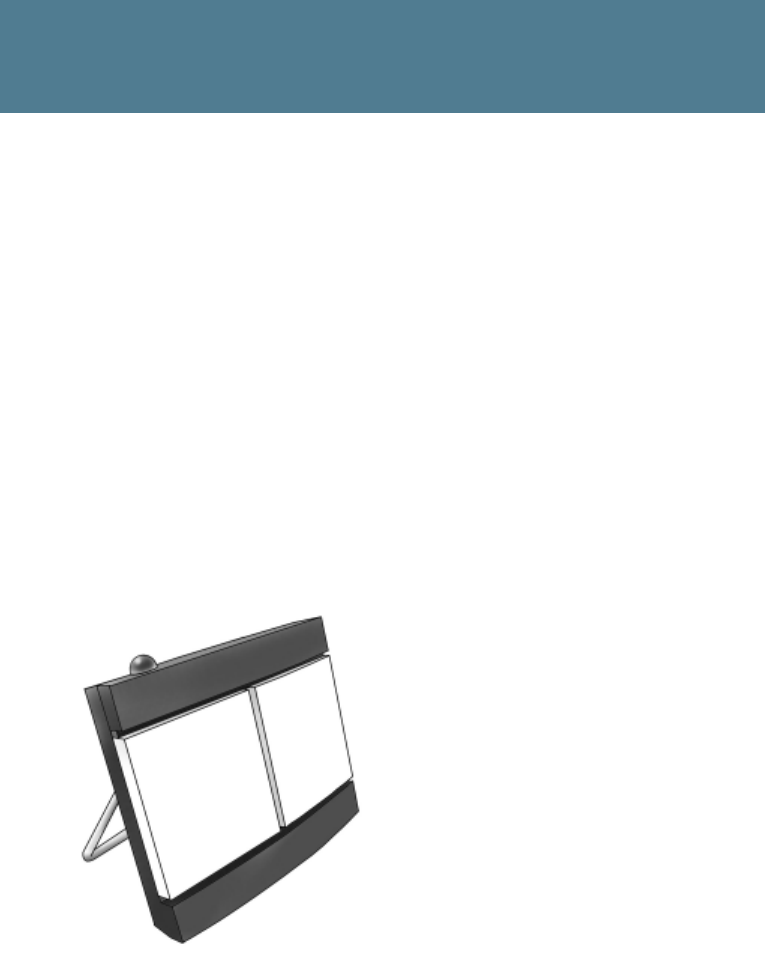
TT 98-123571-DraftA 1
Chapter 1
Introduction 1
Welcome
Congratulations on the purchase of your EXPLORER™ 300!
The EXPLORER™ 300 is the smallest and most compact BGAN terminal in the EXPLORER™ family.
It is a broadband mobile terminal with integrated antenna, providing high-speed data and voice
communication via satellite through the Broadband Global Area Network (BGAN).
Just plug in a phone, laptop or PDA, or use the Bluetooth® interface, point the antenna towards
the BGAN satellite - and you are online.
The flat, light-weight design of the EXPLORER™ 300 makes it easy to carry e.g. in the front pocket
of a laptop bag.
Applications include:
• Internet browsing
•E-mail
• Phone services
• Large file transfers
• Video conferencing and Streaming
• VPN (Virtual Private Network) access to corporate servers
In this chapter
This chapter gives an overview of the BGAN system and services, and introduces the
EXPLORER™ 300.
It also gives an overview of the physical unit and its features and functions.
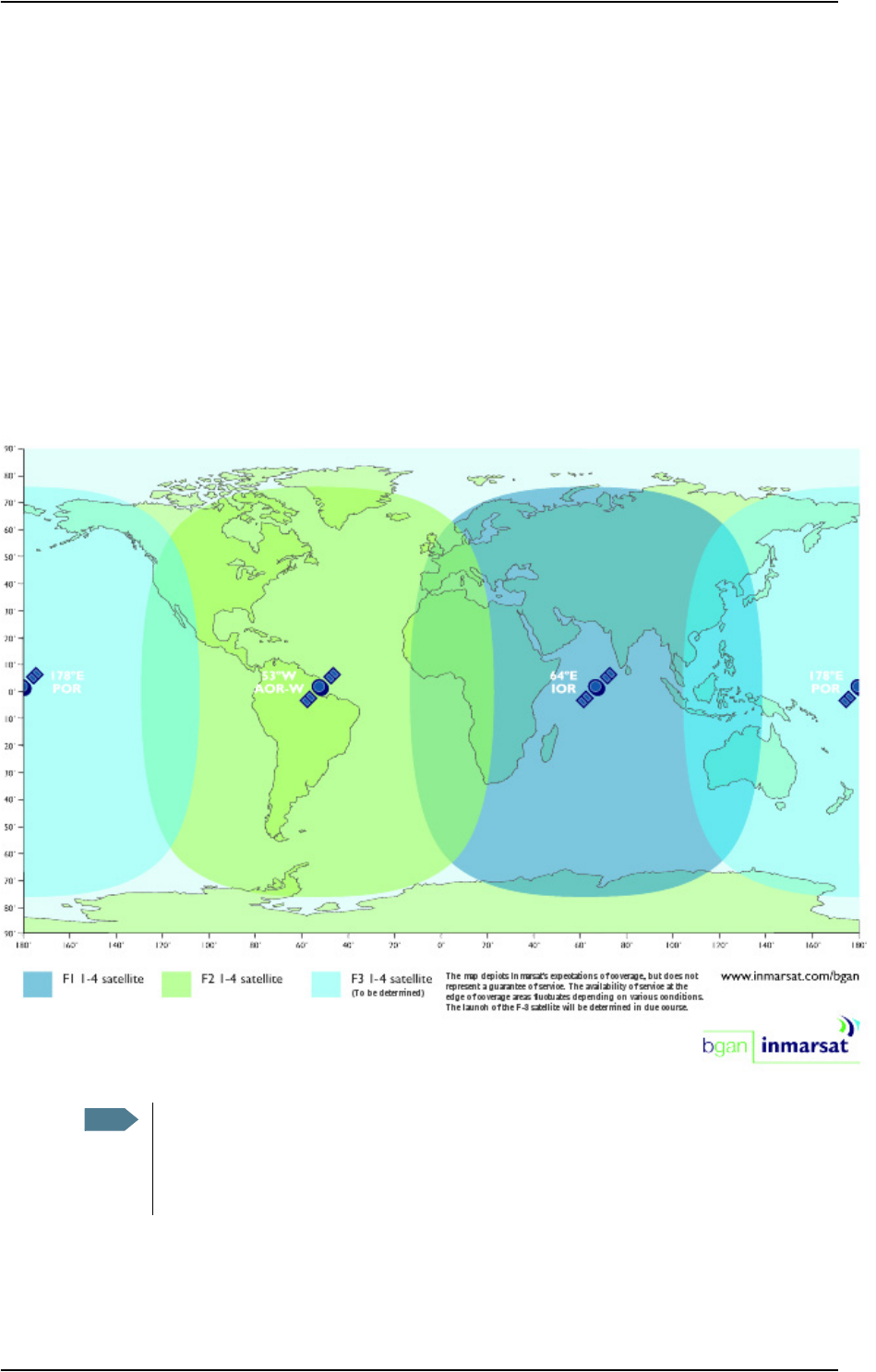
Chapter 1: Introduction
TT 98-123571-DraftA 2
The BGAN system
What is BGAN?
The Broadband Global Area Network (BGAN) is a mobile satellite service that offers high-speed
data up to 492 kbps and voice telephony. BGAN enables users to access e-mail, corporate
networks and the Internet, transfer files and make telephone calls.
Coverage
The Inmarsat® BGAN services are based on geostationary satellites situated above the equator.
Each satellite covers a certain area (footprint). The coverage map below shows the footprints of the
BGAN system.
Note The map depicts Inmarsat's expectations of coverage, but does not represent a
guarantee of service. The availability of service at the edge of coverage areas fluctuates
depending on various conditions.
The launch of the F-3 satellite will be determined in due course.
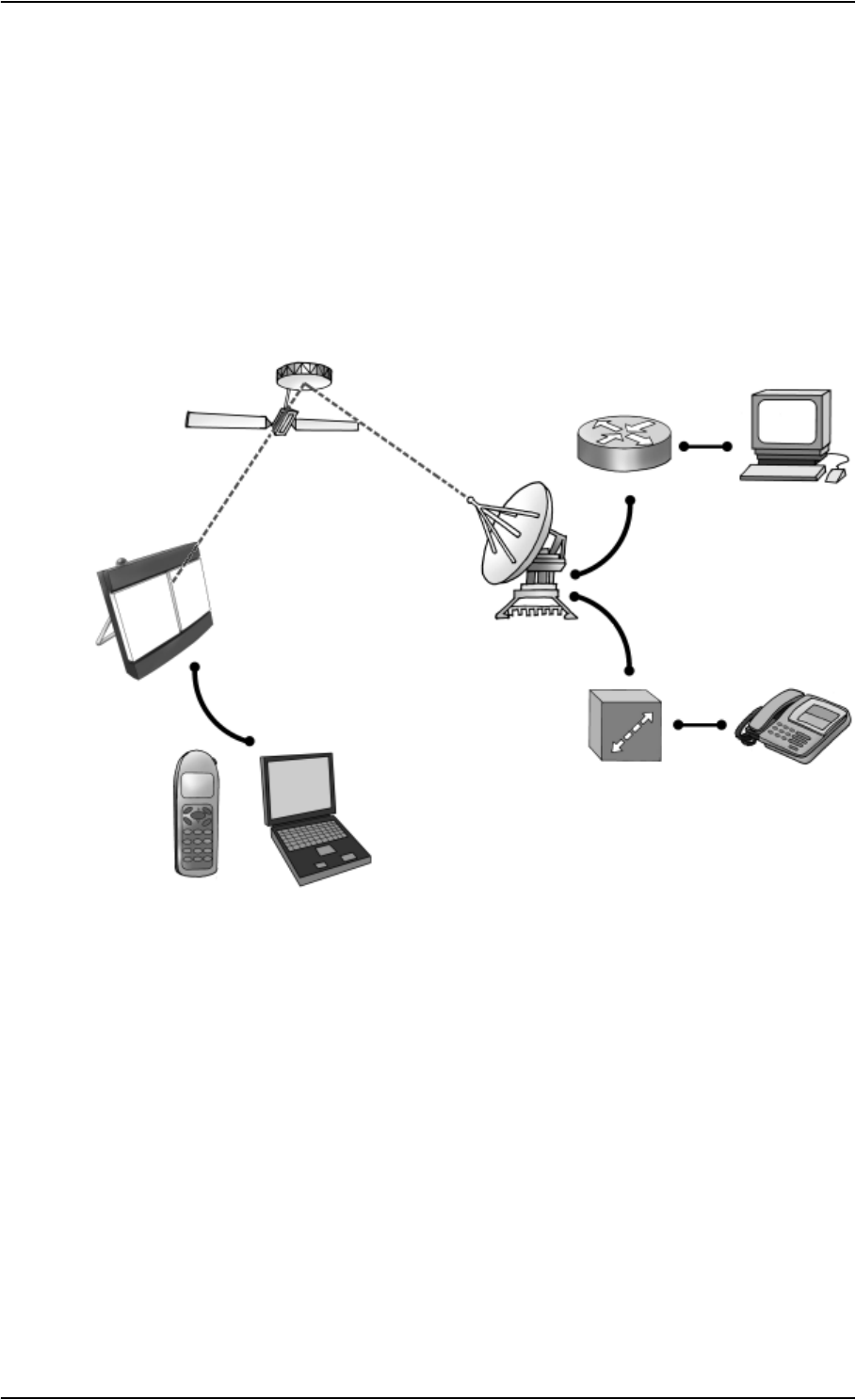
Chapter 1: Introduction
TT 98-123571-DraftA 3
Overview of the BGAN system
A complete BGAN system includes the EXPLORER™ 300 with connected peripherals, the BGAN
satellite, and the Satellite Access Station (SAS). The satellites are the connection between your
EXPLORER™ 300 and the SAS, which is the gateway to the worldwide networks (Internet,
telephone network, cellular network, etc.).
Satellite
IP Router
PC
Satellite Access Station
(SAS)
Switch Voice and ISDN
Laptop
Bluetooth
handset
Circuit Switched Network
Packet Switched Network
EXPLORERTM 300

Chapter 1: Introduction
TT 98-123571-DraftA 4
The BGAN services
Supported services
This section describes the services available with BGAN. Note that not all of these services are
available in the EXPLORER™ 300. See Features and interfaces of the EXPLORER™ 300 on page 5.
The services currently supported by BGAN comprise:
• A Packet Switched connection to the Internet
• A Circuit Switched (Dialed) connection for voice, fax or data
• Short Messaging Service (SMS)
Packet data service
The BGAN network supports different classes of data connection to the Internet.
• Using a Standard data connection, several users can share the data connection
simultaneously. This type of connection is ideal for e-mail, file transfer, and Internet and
intranet access. The user pays for the amount of data sent and received.
• Using a Streaming data connection, you get an exclusive, high-priority connection, ensuring
seamless transfer of data. This type of connection is ideal for time critical applications like live
video over IP. The user pays for the duration of the connection (per minute charge).
Circuit switched (dialed) service
Two types of circuit switched connection are available:
•Standard Voice. A low-tariff connection for voice only. The voice signal is compressed to
4.0 kbps, which reduces the bandwidth use and consequently the tariff.
•3.1 kHz Audio. A high quality connection which can be used for Premium Voice, G3 fax,
analog modem or ISDN.
The signal is uncompressed 3.1 kHz audio, which allows for optimum voice quality.
SMS service
The BGAN system provides a Short Messaging Service (SMS) for sending and receiving SMS
messages.
Supplementary services
The BGAN system also provides the following supplementary services:
• Call hold
• Call waiting
•Call forwarding
•Voice mail
• Call barring (using AT commands)

Chapter 1: Introduction
TT 98-123571-DraftA 5
Features and interfaces of the EXPLORER™ 300
Features
The EXPLORER™ 300 provides the following features:
High speed data up to 384 kbps - shared bandwidth
Support for Streaming classes 32 and 64 kbps
Simultaneous voice and data
Standard LAN, Bluetooth and phone ports
Built-in web interface allowing you to manage your phone book, messages and calls, and
customize the terminal to your specific needs
100-240 V AC power adapter
Lightweight and portable design
Easy setup and use
Robust and durable design
CE, FCC and GMPCS certified
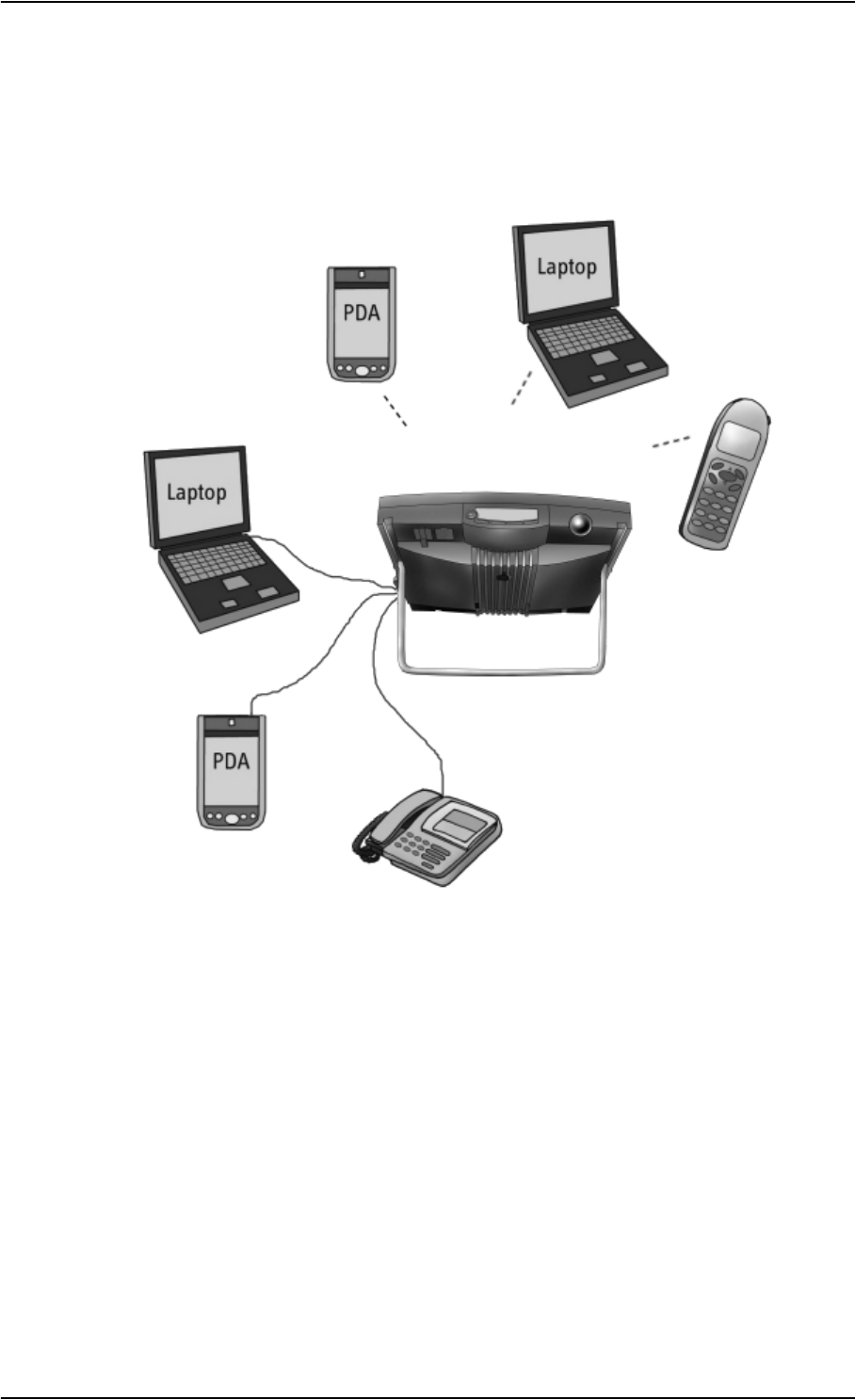
Chapter 1: Introduction
TT 98-123571-DraftA 6
Overview of interfaces
The EXPLORER™ 300 provides interfaces for connection of a phone or a computer.
Using the interfaces on page 47 describes how to use each of the available interfaces.
Minimizing power consumption
The EXPLORER™ 300 is designed for minimum power consumption. This means that functions that
are not currently used will automatically go into a “sleep mode” to minimize the power
consumption.
In addition to this automatic sleep mode function, you can disable each of the interfaces if they are
not currently used. Note, however, that you will not be able to use these interfaces until you
enable them again. For information on how to enable/disable interfaces, see Enabling or disabling
an interface on page 49.
LAN
LAN
Standard Phone
Connection
Bluetooth
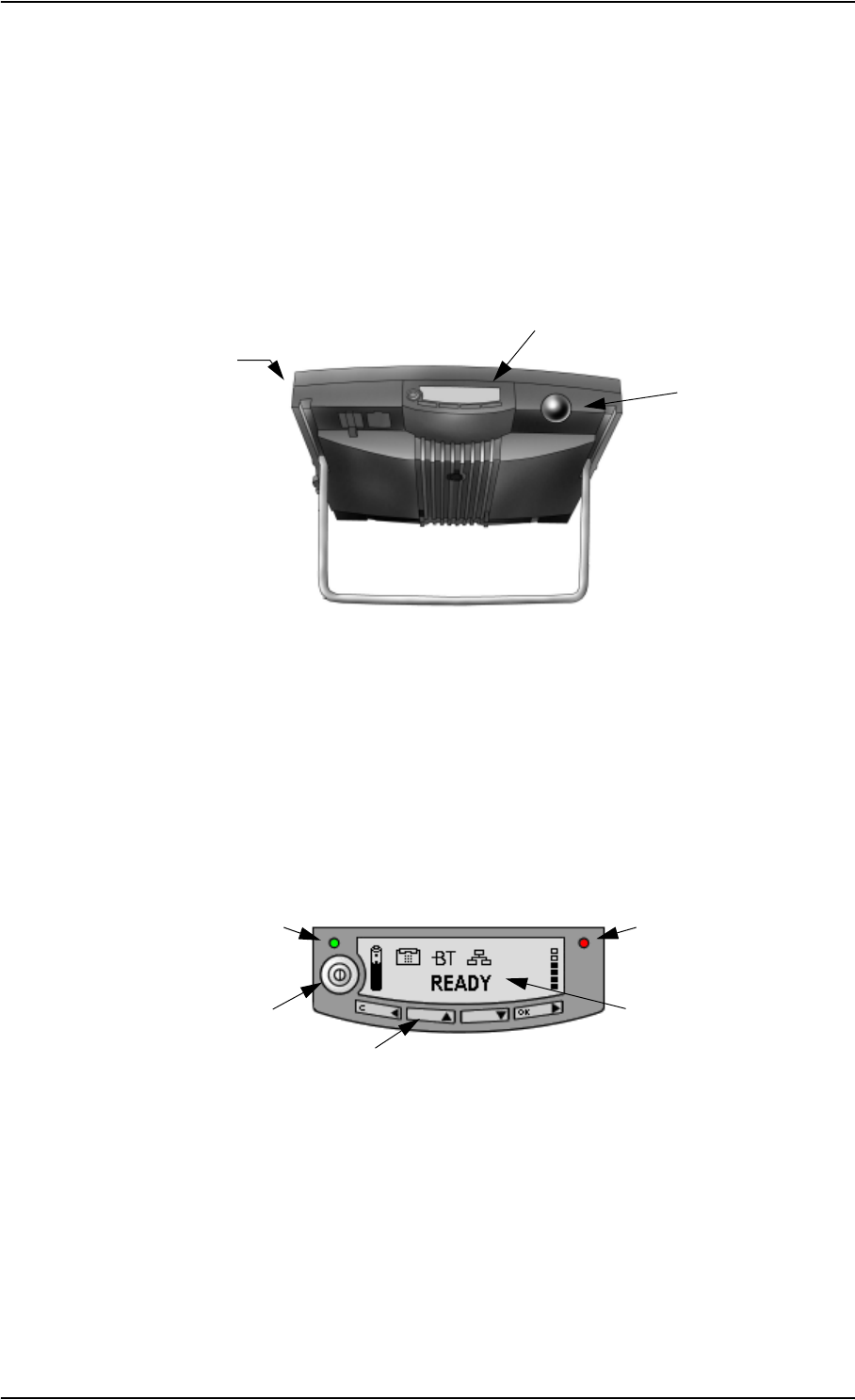
Chapter 1: Introduction
TT 98-123571-DraftA 7
Your EXPLORER™ 300 terminal
Overview
The EXPLORER™ 300 is a compact unit comprising antenna, compass, display and keypad, all in
one unit.
Display and keypad
The EXPLORER™ 300 has a display and a keypad for displaying status and for changing simple
parameters.
For information on how to use the keypad and display, and for an overview of the display menu
system, see Using the display and keypad on page 30.
Display and keypad
Antenna
Compass
Power indicator
Power button
Keypad
Display
Message indicator

Chapter 1: Introduction
TT 98-123571-DraftA 8
Light indicators
The EXPLORER™ 300 has two light indicators next to the display: a green power indicator and a
red message indicator.
Green Power indicator
The function of the green Power indicator to the left of the display is as follows:
Red Message indicator
The function of the red Message indicator is as follows:
Behavior of green indicator Meaning
Short flash every 2 seconds The EXPLORER™ 300 is on.
Steady light The battery is charging.
Flashing rapidly A charging error has occurred.
For further information, refer to the Troubleshooting Guide on
page 116.
Off No power or Stealth mode.
Behavior of red indicator Meaning
Flashing An alarm is active or
An SMS message has arrived.
Press OK on the keypad to view the alarm(s) or SMS
message(s).a
The red light will keep flashing after OK is pressed if
• there are more SMS messages, or
• an alarm is still active.
For information on alarm messages, see Alarm messages
on page 122.
a. If a computer is connected, you can also view alarms and SMS messages in the built-in web interface in the
EXPLORER™ 300. For further information, see Icons in the icon bar on page 70.
Off No messages are present, or the EXPLORER™ 300 is in Stealth
mode.

Chapter 1: Introduction
TT 98-123571-DraftA 9
User interfaces
The keypad and display are used for pointing the antenna, for displaying status and for changing
simple parameters.
To obtain full access to all features and for ease-of-use, you should use a computer
(a PC, Laptop or similar) and one of the following:
•The web interface. A built-in web interface for easy configuration and daily use. The web
interface is accessed from a computer connected to the EXPLORER™ 300, using an Internet
browser. For further information, see Chapter 5, Using the web interface.
•The BGAN LaunchPad from Inmarsat. BGAN LaunchPad is a computer application used to
control terminals in the BGAN system. LaunchPad is provided on the Inmarsat BGAN CD-ROM
supplied with your EXPLORER™ 300. For information on how to use the LaunchPad, refer to
the manual on the Inmarsat CD-ROM.
Additionally, it is possible to control the EXPLORER™ 300 using AT Commands. Refer to
Appendix B, AT commands.
Antenna
The white part of the EXPLORER™ 300 is the antenna module. The antenna module comprises a
GPS (Global Positioning System) antenna, a BGAN antenna and a Bluetooth antenna.
Compass
The EXPLORER™ 300 also provides a compass to help positioning the
antenna. For further information on how to use the compass, see
Pointing the antenna on page 21.
Battery
The EXPLORER™ 300 comes with a rechargeable battery, which is easily inserted. The battery is
automatically recharged when power is applied to the EXPLORER™ 300. Steady green light
indicates that the battery is charging.
SIM card
The SIM (Subscriber Identity Module) card used for the EXPLORER™ 300 is a standard SIM card,
which is acquired from the Airtime Provider.
The EXPLORER™ 300 requires a SIM card to go online and to access the settings of the
EXPLORER™ 300. Without a SIM card you can only see the Main screen of the display system
showing battery status etc. Using the web interface, you can view the properties of the
EXPLORER™ 300 and upload software without inserting a SIM card. Upload of software, however,
requires an Administrator user name and password.

Chapter 1: Introduction
TT 98-123571-DraftA 10
Matrix of services and communication interfaces
The following table shows which services can be accessed from which interfaces, and which types
of equipment can be used.
What’s next?
This chapter has provided an overview of the BGAN system and of the EXPLORER™ 300.
The next chapters will go into more detail about how to set up and use the EXPLORER™ 300. The
following chapter, Getting started, explains how to unpack and start up the EXPLORER™ 300, and
how to point the antenna in order to get the best possible signal.
Service
Interface on the EXPLORER™ 300
Phone Bluetooth LAN Display/
Keypad
Circuit Switched Connection
Standard
Voice
Analog
telephone
Bluetooth
handset
Packet Switched Connection
Data
single-user
Computer Computer
SMS Computer Computer View only
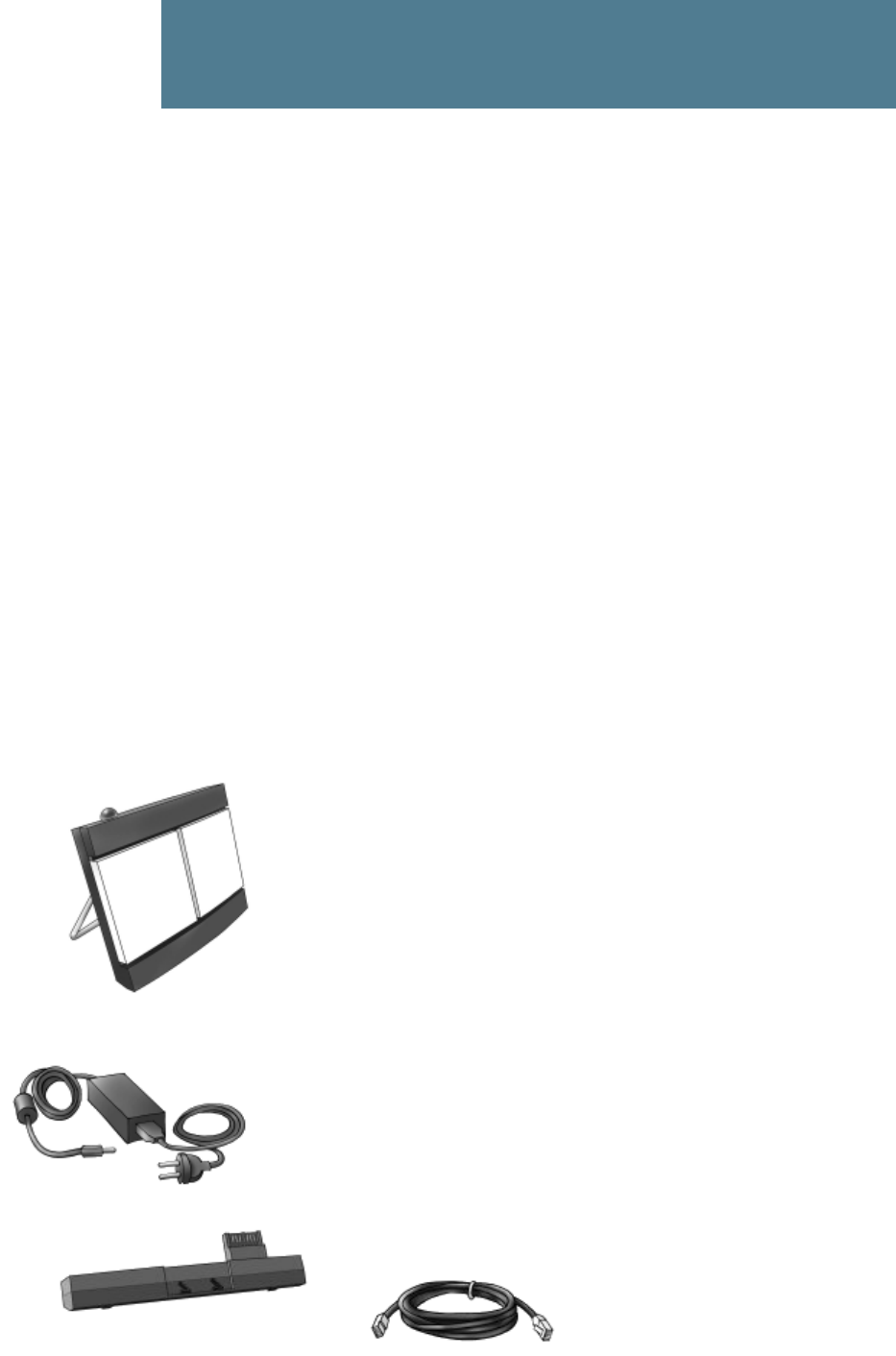
TT 98-123571-DraftA 11
Chapter 2
Getting started 2
In this chapter
This chapter describes:
• what is included in the delivery,
• how to insert and remove the battery and SIM card, and
• how to start up the EXPLORER™ 300 and make the first call or data session.
Unpacking and assembling
Unpacking
Unpack the EXPLORER™ 300 and accessories and check that the following items are present:
EXPLORER™ 300
LAN Cable
AC/DC adapter
EXPLORER™ 300 Battery
Getting Started Kit
- Getting Started leaflet
- Quick Guide
- EXPLORER™ 300 CD-ROM
- BGAN LaunchPad CD-ROM
containing:
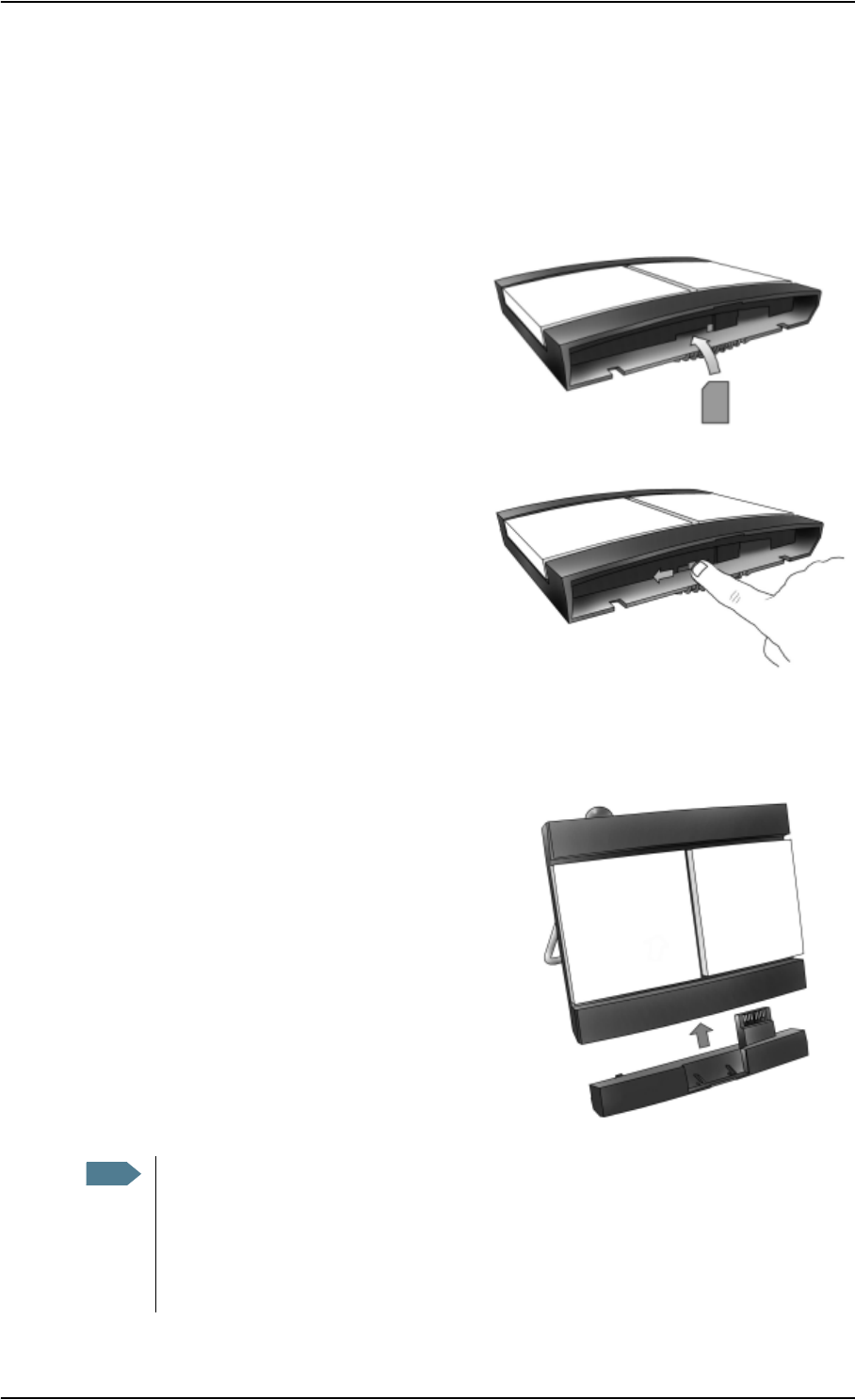
Chapter 2: Getting started
TT 98-123571-DraftA 12
Inserting the SIM card
The EXPLORER™ 300 is delivered with the battery separated from the terminal. If the battery is
already inserted, remove it as described in Removing the battery on page 13.
The SIM card is provided by your Airtime Provider. Insert the SIM card as follows:
1. Insert the SIM card into the SIM slot. Make
sure the SIM card is positioned as shown!
2. Press gently until it clicks.
3. Slide the lock to close the SIM slot.
Inserting the battery
Do as follows:
1. Insert the battery.
Make sure the battery is positioned correctly as
shown.
2. Press gently until it locks.
Note Before using the terminal the first time: To ensure accurate information on the battery
capacity you should fully charge, then fully discharge the battery (until the
EXPLORER™ 300 closes down automatically), and finally recharge the battery. The
EXPLORER™ 300 can be used during the discharging process, but the remaining battery
capacity may not be displayed correctly.
For information on how to recharge the battery, see Recharging the battery on page 113.
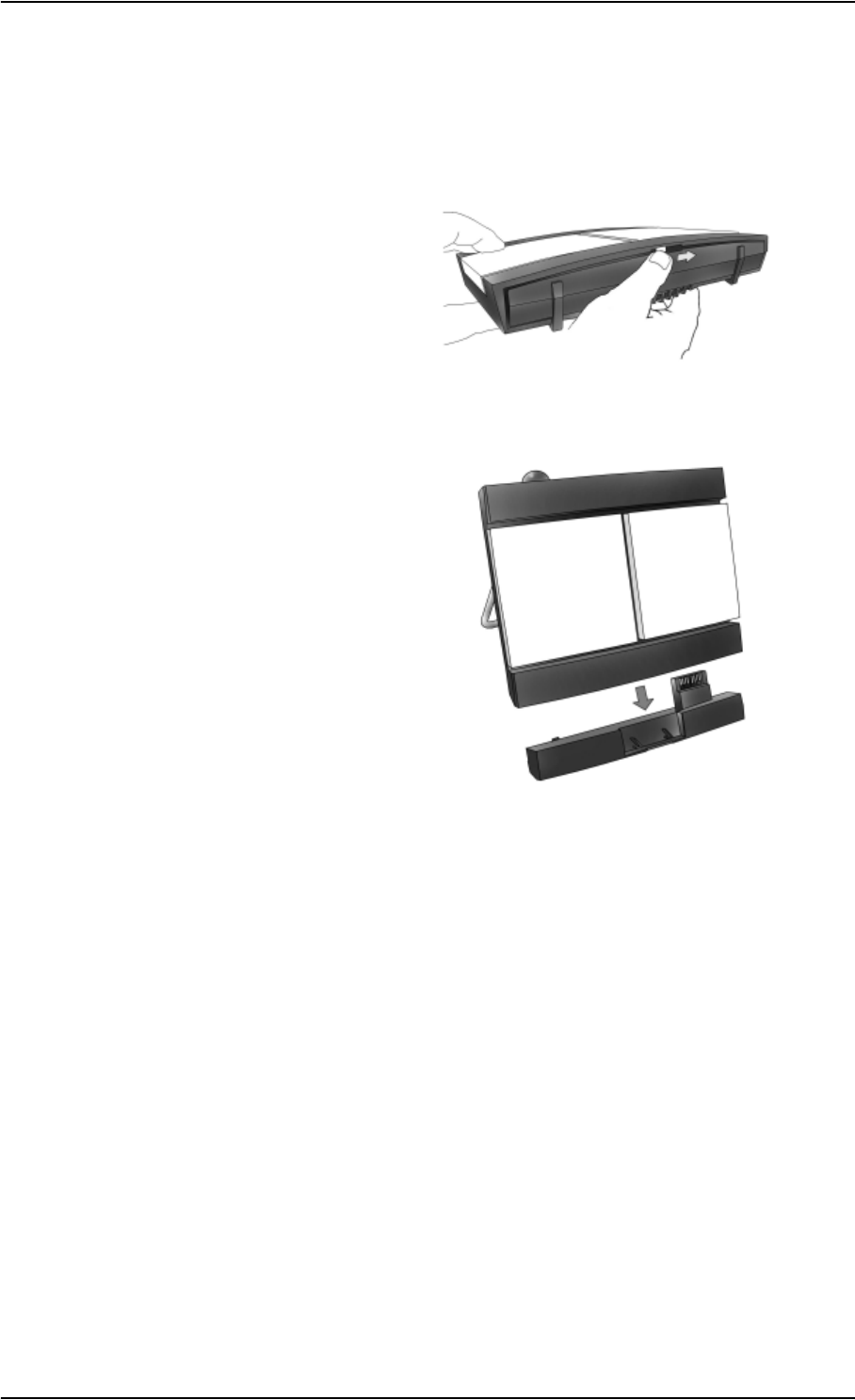
Chapter 2: Getting started
TT 98-123571-DraftA 13
Removing the battery
To remove the battery, do as follows:
1. Locate the slide lock at the bottom of
the unit.
2. Slide the lock aside to release the
battery from the unit.
3. Remove the battery.
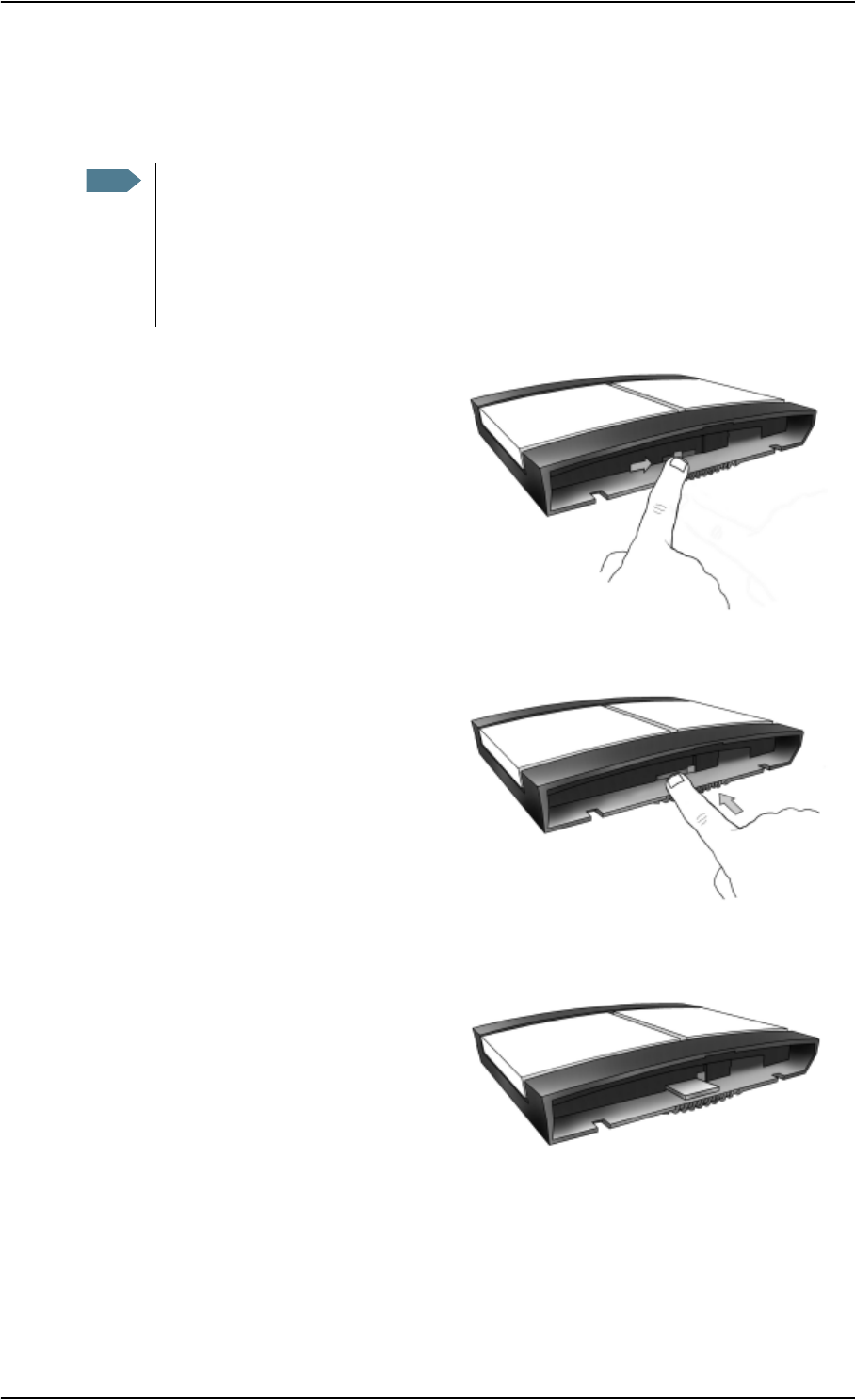
Chapter 2: Getting started
TT 98-123571-DraftA 14
Removing the SIM card
To remove the SIM card, first remove the battery as described in Removing the battery on page 13.
Remove the SIM card as follows:
1. Slide the lock aside to open the SIM
slot as shown.
2. Gently press the SIM card and let it
pop out of the slot.
3. Remove the SIM card.
Note When the SIM card is removed, you cannot use the display menu system nor make calls
or start data sessions.
Only emergency calls are allowed, and only if permitted by the network.
However, if you have an administrator user name and password, you can upload
software using the web interface. For further information, see Uploading software on
page 113.

Chapter 2: Getting started
TT 98-123571-DraftA 15
Connecting cables
After inserting SIM card and battery, connect all relevant cables.
Side connector panel
The connector panel is placed on the side of the EXPLORER™ 300 and has the following
connectors:
• Phone connector for connecting a
standard phone
• LAN connector for data equipment
• DC Power connector (10-16 V DC) for
connection to a 100-240 V AC/DC
adapter, or to a charger cable which
connects to the cigarette lighter
socket/12 V DC in a car.
For information on how to connect to a specific interface, see the corresponding section in
Chapter 4, Using the interfaces. The end of this section describes how to connect to power.
Rear connector
Apart from the connectors in the connector panel,
the EXPLORER™ 300 has a connector placed on the
rear side of the EXPLORER™ 300.This connector is
marked DC OUT and is used for charging the
EXPLORER™ Bluetooth Handset.
For information on how to connect to the Bluetooth
charger interface, see Using the EXPLORER™
Bluetooth Handset charger on page 66.
Before connecting to power
You can connect to external power or use the battery delivered with your EXPLORER™ 300.
Refer to Power input on page 130 for specifications and pin-out for the DC Power input.
If you are connecting to a 100-240 V AC electrical outlet, use the AC/DC adapter included with your
EXPLORER™ 300.
Alternatively, you may connect to 12 V DC in a car.
Important Connect the cables before making the final adjustment of the antenna position.
Otherwise you may accidently move the antenna when you connect the cables.
Phone LAN DC Power
Illustration of DC OUT connector
at the back of the terminal

Chapter 2: Getting started
TT 98-123571-DraftA 16
Connecting to power
You can connect the DC input to power without the battery inserted.
If the battery is inserted when you apply power to the EXPLORER™ 300, the battery is
automatically recharged.
Connecting to a 100-240 V AC electrical outlet: Connect the AC/DC adapter to the DC Power input
on the side of the EXPLORER™ 300. Then connect the power cable between the 100-240 V AC
electrical outlet and the AC/DC adapter.
Connecting to 12 V DC in a car: Connect the charger cable between the DC Power input of the
EXPLORER™ 300 and the cigarette lighter socket in the car. A suitable charger cable is available
from Thrane & Thrane.
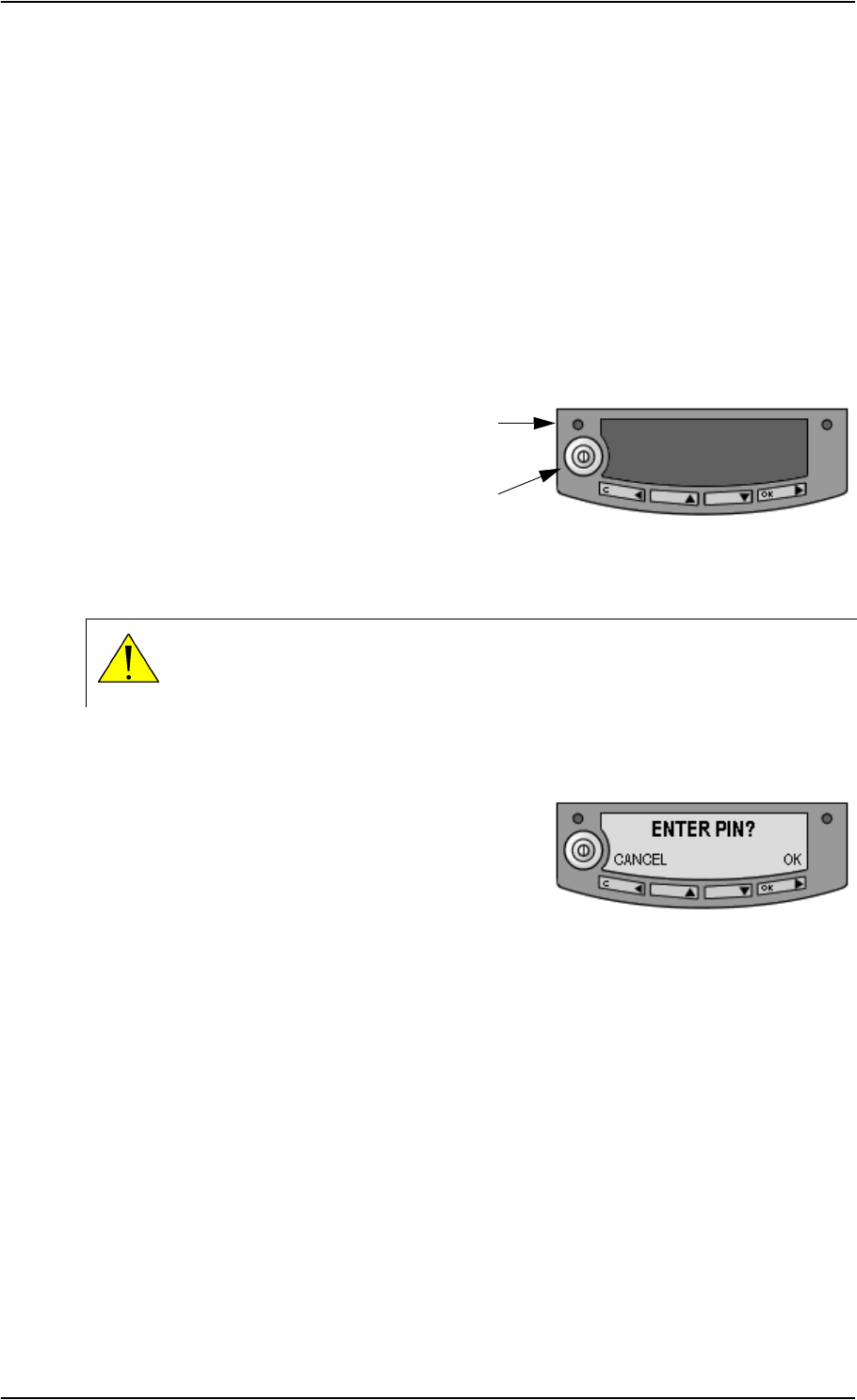
Chapter 2: Getting started
TT 98-123571-DraftA 17
Powering the EXPLORER™ 300
Automatic power up
The default behavior of the EXPLORER™ 300 is to power up automatically when you connect the
power cable. If you wish, you can change this power up mode, so that the EXPLORER™ 300 is only
powered if the Power button is pressed.
For further information on power up mode, see Setting the power up mode on page 41 or Power up
behavior on page 85.
Switching the EXPLORER™ 300 on/off
To switch on the EXPLORER™ 300, push
the Power button next to the display and
hold it down until the green Power
indicator lights up. It normally takes one
or two seconds.
To switch off the EXPLORER™ 300, push the Power button again and hold it until the display
shows SWITCHING OFF....
After switching on the EXPLORER™ 300 you will be
prompted for a PIN (Personal Identification Number),
unless the PIN is disabled (e.g. using the BGAN
LaunchPad).
For information on the options after power on, see the next section.
WARNING! When the EXPLORER™ 300 is powered on, stay clear of the antenna
front! The antenna emits radio frequency energy, not only when the display shows
DATA ACTIVE. Always keep a minimum distance of 0.6 m from the antenna front.
Power
Power
Indicator
Button
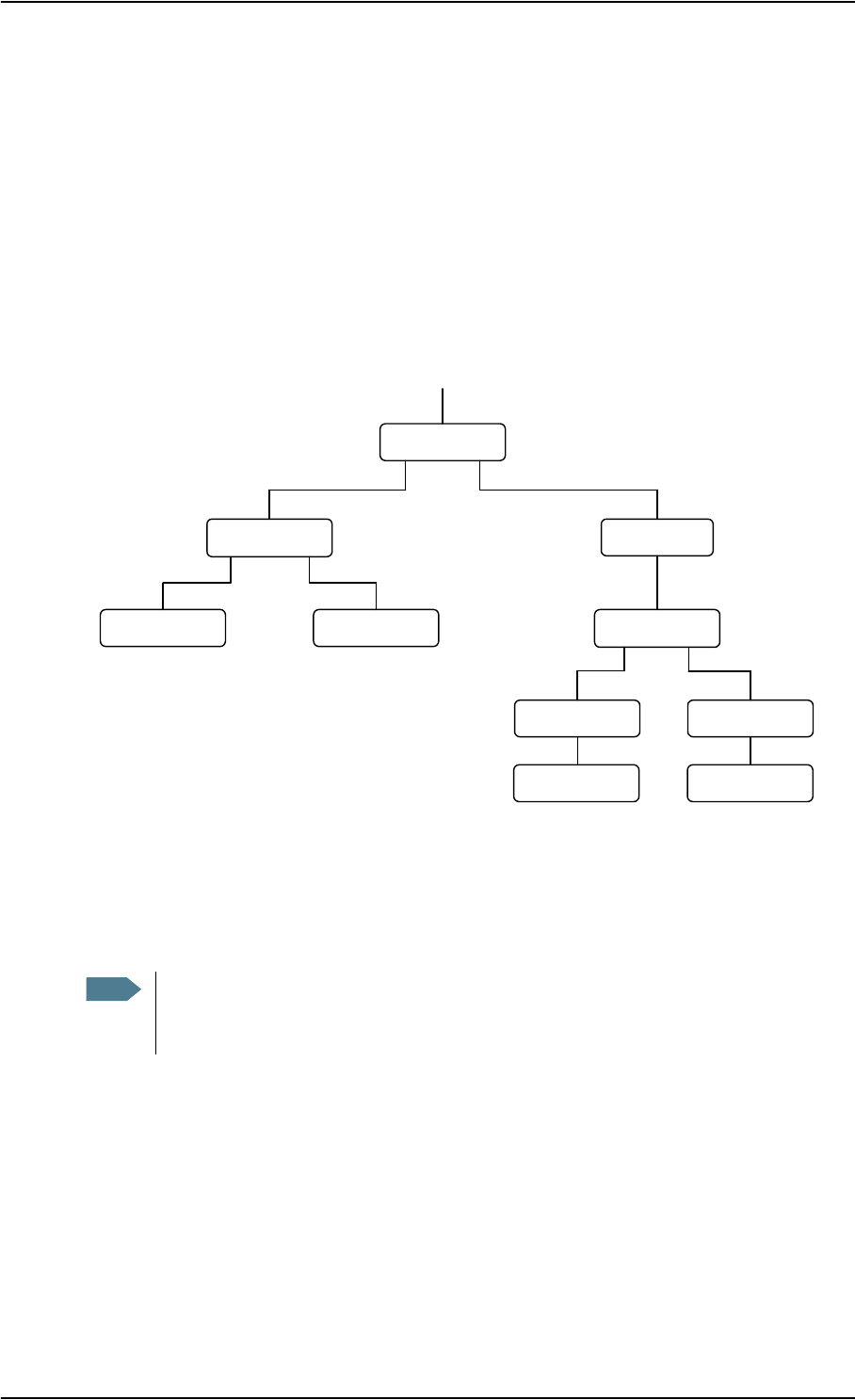
Chapter 2: Getting started
TT 98-123571-DraftA 18
Options for the start-up procedure
Overview of the start-up options
You have different options for the start-up procedure. Each of these options are briefly described
in this section.
For information on how to enter PIN and point the antenna, see the subsequent sections.
The following drawing shows the options available after power on.
The numbers on the drawing refer to the different start-up options described in the following
sections.
Note If the use of PIN is disabled, e.g. from the BGAN LaunchPad, the display sequence is the
same as after successfully entering the PIN. This means that after power on, you will see
the Signal strength screen.
Power on
ENTER PIN?
Cancel OK
ENTER PIN
*-
"Signal Strength"
Cancel OK
"Signal Strength"
Cancel OK
"Main screen" "Main screen"
You can access the
menu system but you
cannot use the BGAN
network.
You can access the
menu system and use
the BGAN network.
"Main screen"
You cannot access the
menu system, and you
cannot use the BGAN
network.
"Main screen"
You cannot access the
menu system, and you
cannot use the BGAN
network, except for
emergency calls, if
allowed by the network.
Menu system Menu system
12
3

Chapter 2: Getting started
TT 98-123571-DraftA 19
“Full” procedure (1)
After power on, enter the PIN and then point the antenna.
In this mode you have full access to the EXPLORER™ 300, that is you can use the menu system and
communicate on the BGAN network.
The display will show READY when the menu system is not activated.
“Off-line” procedure (2)
After power on, enter the PIN, but cancel pointing.
In this mode you can use the menu system, but are not able to communicate on the BGAN
network.
The display will show POINT NOW? when in the Main screen.
Press S or T to enter the menu system.
When you want to point the antenna, press OK from the Main screen.
“Emergency” procedure (3)
After power on, cancel the PIN and then point the antenna.
In this mode you can only place emergency calls, and only if permitted by the network. You are not
able to access the menu system nor to communicate on the BGAN network (apart from emergency
calls), until you enter the PIN.
The display will show ENTER PIN?
If you press OK you can enter the PIN. No other options are available from the keypad.
From the web interface you can view properties and, if you have an administrator password,
upload software.
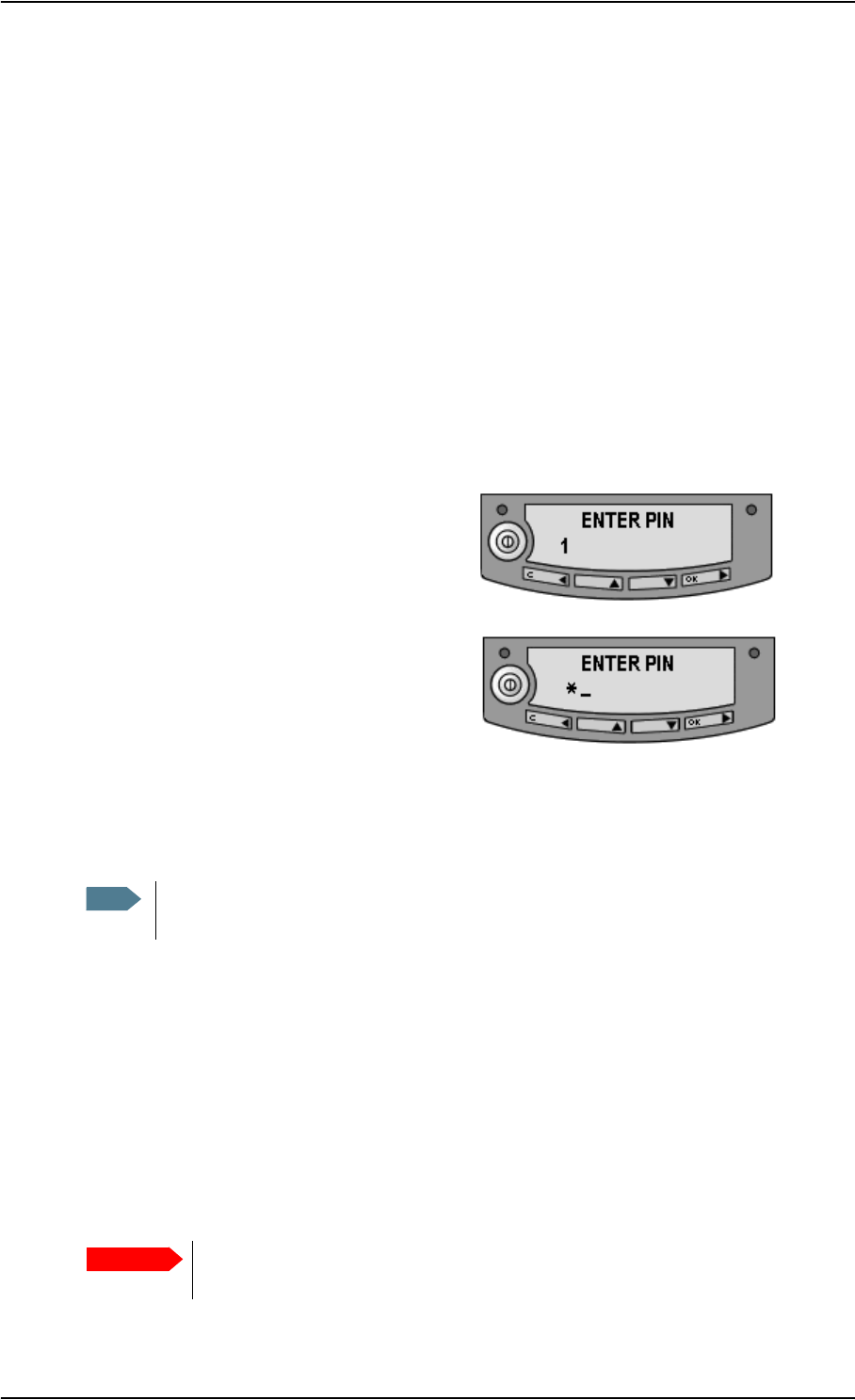
Chapter 2: Getting started
TT 98-123571-DraftA 20
Entering the SIM PIN
Overview
You have to enter a PIN to use the EXPLORER™ 300, unless the use of PINs is disabled e.g. from
the BGAN LaunchPad.
The first time you are asked for a PIN, you can choose to cancel (press C). If you cancel, you are
asked again after pointing is completed. At that point you must enter the PIN to be able to
continue.
Entering the PIN
To enter the PIN using the display and keypad, do as follows:
1. When you are asked for a PIN, press OK.
2. Press S or T a number of times until the
first digit is correct.
3. Press OK to go to the next digit.
When OK is pressed, the previous digit is
indicated by a *.
To correct an entered digit, press C to go back and use the S and T buttons again.
4. After entering the last digit with OK, press OK again to apply the PIN.
For further information, see Using the display and keypad on page 30.
You can enter the PIN using a phone or computer connected to the EXPLORER™ 300. For further
information, see Entering the SIM PIN using a phone on page 53 or Entering the SIM PIN in the
web interface on page 71.
Wrong PIN
You have 3 attempts to enter the PIN, before you are asked to enter the PUK (Pin Unblocking Key).
The PUK is supplied with your SIM card.
Enter the PUK followed by a new PIN of your own choice. The PIN must be from 4 to 8 digits long.
Note At this point the EXPLORER™ 300 may make a sound. This sound is used for pointing the
antenna. To toggle the pointing sound on/off, press S or T.
Important If you enter a wrong PUK 10 times, the SIM card will no longer be functional, and
you have to contact your Airtime Provider for a new SIM card.
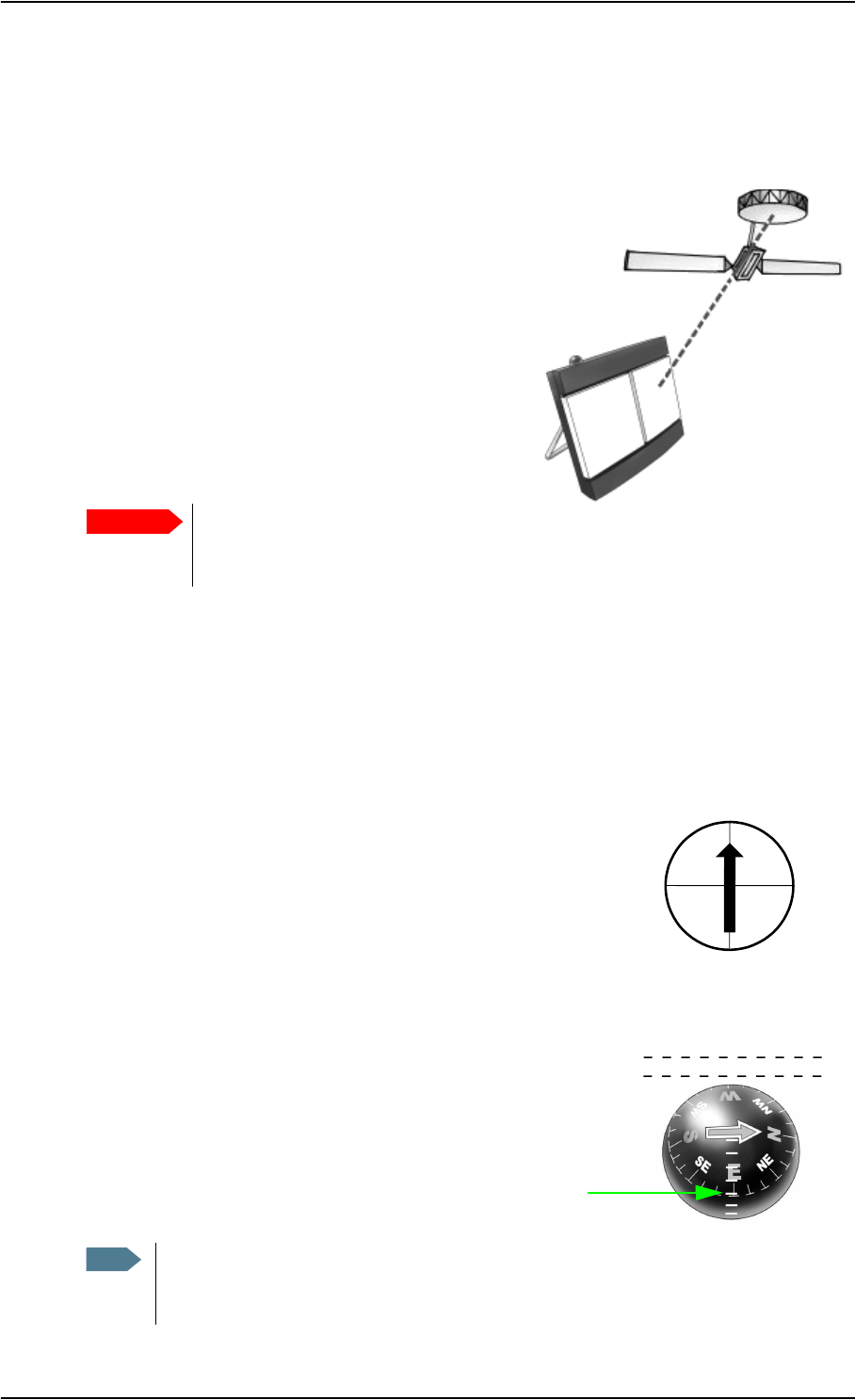
Chapter 2: Getting started
TT 98-123571-DraftA 21
Pointing the antenna
The importance of pointing
In order to obtain the best possible signal at the lowest
possible cost, it is important that the EXPLORER™ 300
antenna is pointed correctly towards the satellite.
The antenna must have a clear line of sight to the
satellite without any obstacles blocking the signal, and
the pointing direction of the antenna should be as
accurate as possible.
The next sections describe how to point the antenna for the best possible signal.
Pointing data
If the position of the satellite in relation to the EXPLORER™ 300 is known, you can use the
compass to roughly point the antenna in the right direction. If you know the Azimuth and the
Elevation, you can use this data to adjust the antenna.
•The Azimuth is the horizontal rotation angle relative to
North (moving clockwise).
•The Elevation is the vertical rotation angle relative to
horizontal. This means that an Elevation of 0°
corresponds to the EXPLORER™ 300 being in an upright
position, pointing towards the horizon.
The compass has 7 lines dividing the Elevation scale into 6
spaces. The space between two lines corresponds to 15°.
The Elevation is measured where the lines meet. This compass
shows an Elevation of 30° (2 spaces up from the first line) and
an Azimuth of 270° (antenna pointing towards West).
Important Incorrect pointing may result in poor quality of the signal, and in some cases
retransmission may be necessary. This could mean you will be paying more than
necessary for your transmission.
Note The above explanation assumes that the compass shows the exact orientation. Please
take into consideration the possible deviation and variation that can occur, e.g. because
of the geographical location or the presence of magnetic objects.
N = 0°
S = 180°
E = 90°W = 270°
Front of antenna
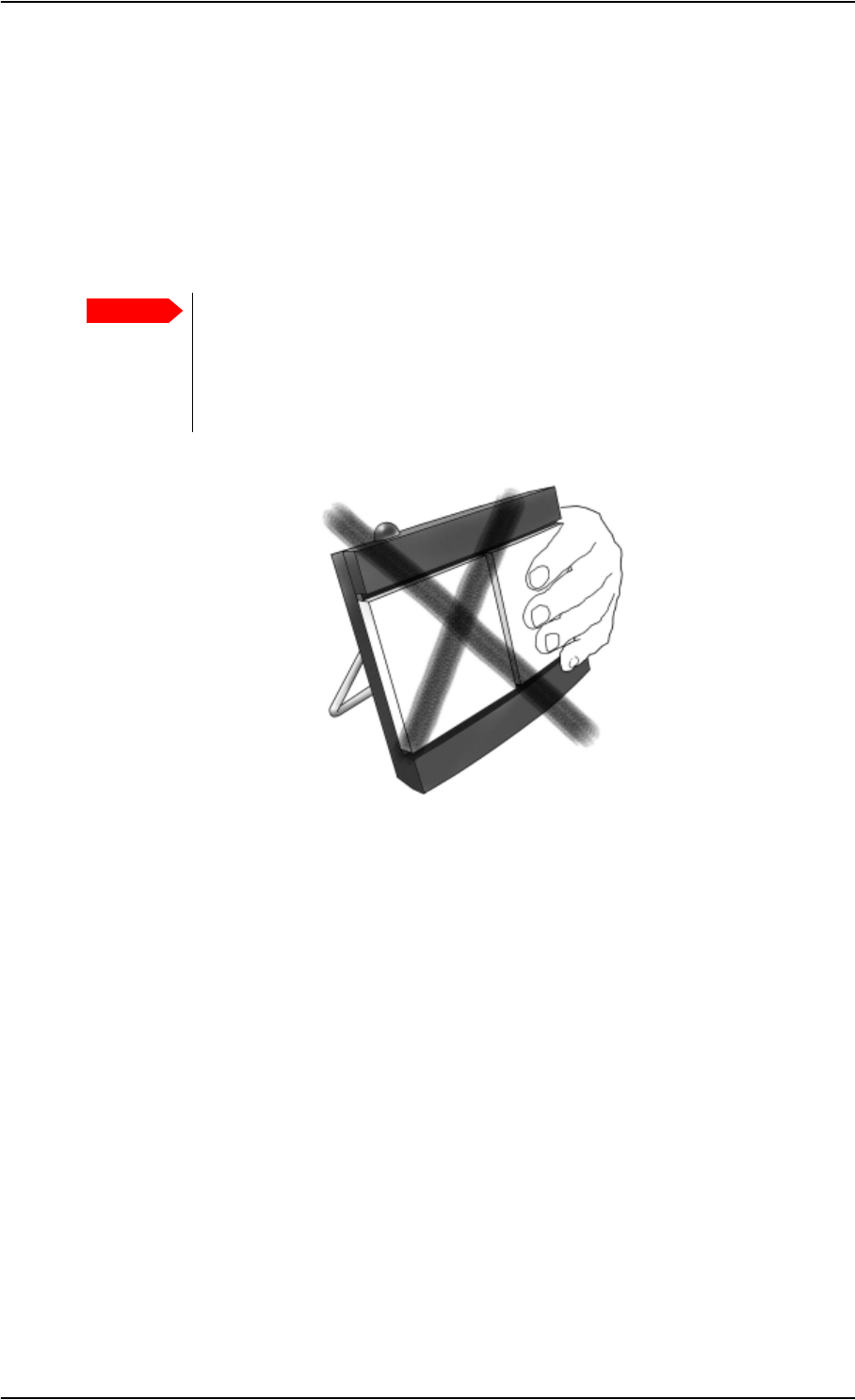
Chapter 2: Getting started
TT 98-123571-DraftA 22
Required signal strength
As a rule of thumb, the signal strength should typically be 41 dBHz or more for the
EXPLORER™ 300 to be able to establish a call or data session. However, the required signal
strength can vary depending on a number of factors, such as weather conditions and location.
Do not block the antenna signal with your hands
Obtaining a GPS fix
The EXPLORER™ 300 must acquire its own location from the GPS satellites before it can register
on the BGAN network. This is called obtaining a GPS fix.
If the antenna is placed in an open location with a wide view to the sky, the EXPLORER™ 300 will
probably obtain the GPS fix automatically while you are pointing towards the BGAN satellite.
However, if part of the view to the sky is blocked, and/or the Elevation is very low, it may
sometimes be difficult for the GPS antenna to “see” a sufficient number of GPS satellites. In such
circumstances, try the following:
1. Place the antenna flat on an even surface, pointing straight upwards with a clear view to as
much of the sky as possible.
2. When the GPS fix is obtained, you can start pointing towards the BGAN satellite.
To see the GPS status, enter the display menu system by pressing S or T and select
PROPERTIES > GPS STATUS. For further information, see Viewing the GPS status on
page 42.
Important When pointing the antenna, do not touch the front of the antenna module. For your
safety, always maintain a distance of minimum 60 cm from the front face of the
antenna. Also, if you place your fingers on the antenna you will be blocking the
signal, and the antenna will not work efficiently.
Hold the support bracket and the battery module below the antenna while pointing.
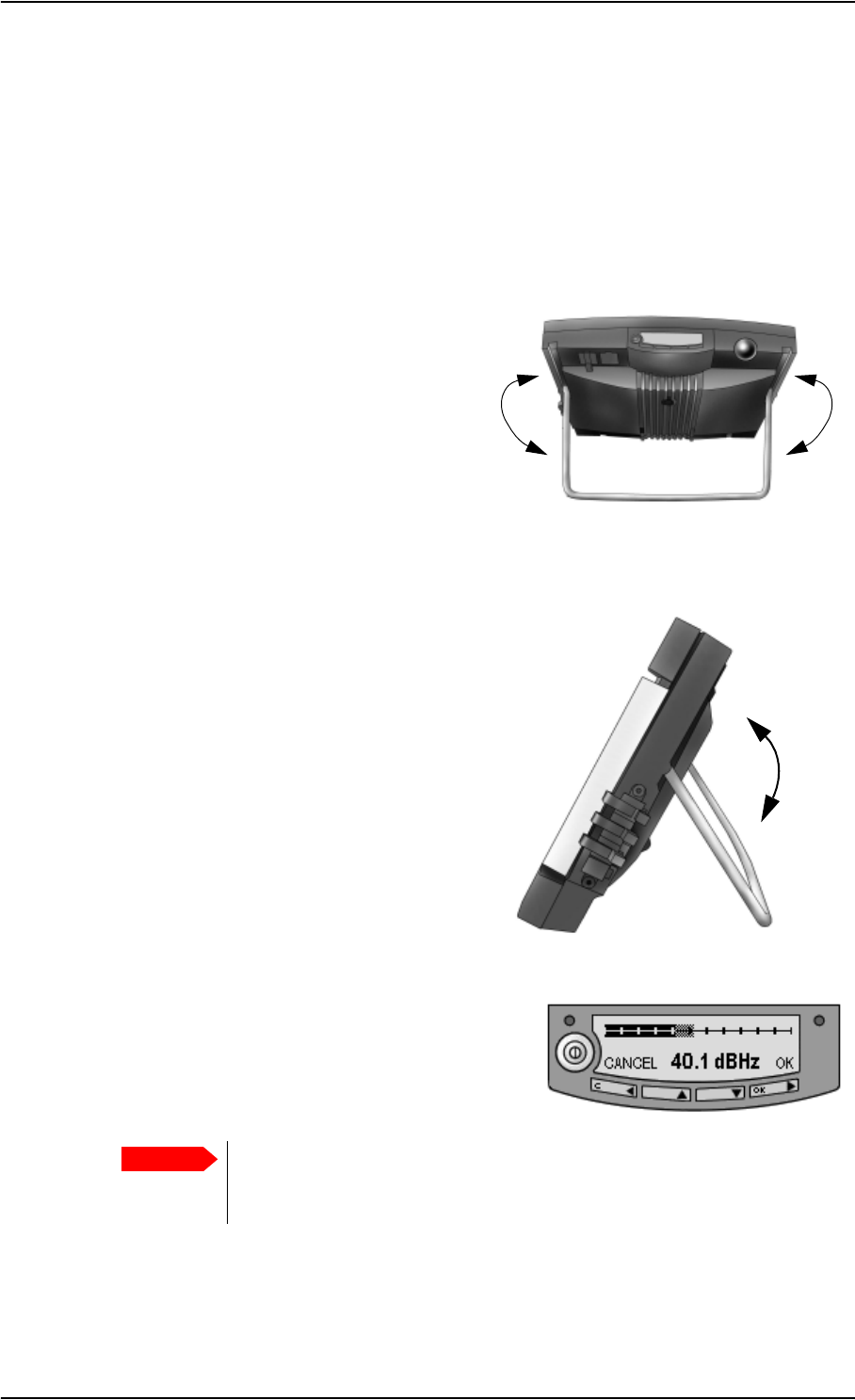
Chapter 2: Getting started
TT 98-123571-DraftA 23
Pointing the antenna towards the satellite
To help you obtain the best possible signal strength, the EXPLORER™ 300 uses a pointing sound
to indicate the signal strength during pointing. The frequency of the tone increases with the signal
strength.
You can toggle the pointing sound on/off by pressing S or Ton the keypad.
Do as follows to point the antenna:
1. While observing the built-in compass of the
EXPLORER™ 300, rotate the
EXPLORER™ 300 left or right until it points in
the correct horizontal direction, known as
the Azimuth. Refer to Pointing data on
page 21.
Hold the battery module and the support
bracket while moving the antenna. Do not
place your hands on the antenna.
2. Tilt the EXPLORER™ 300 slowly up or down
until it points in the correct vertical direction,
known as the Elevation.
Hold the battery module and the support
bracket while moving the antenna. Do not
place your hands on the antenna.
3. After passing the PIN screen, the display
shows the current satellite signal strength. Use
this information to fine-adjust the antenna
position as shown in step 1 and 2.
Remember not to touch the antenna part!
If the right most part of the signal strength bar is grey, it indicates that the level has previously
been higher than the current level.
Important When fine-adjusting the antenna, the display may take a while to update the
signal strength. Wait a second or two after each move to make sure the display
is updated.
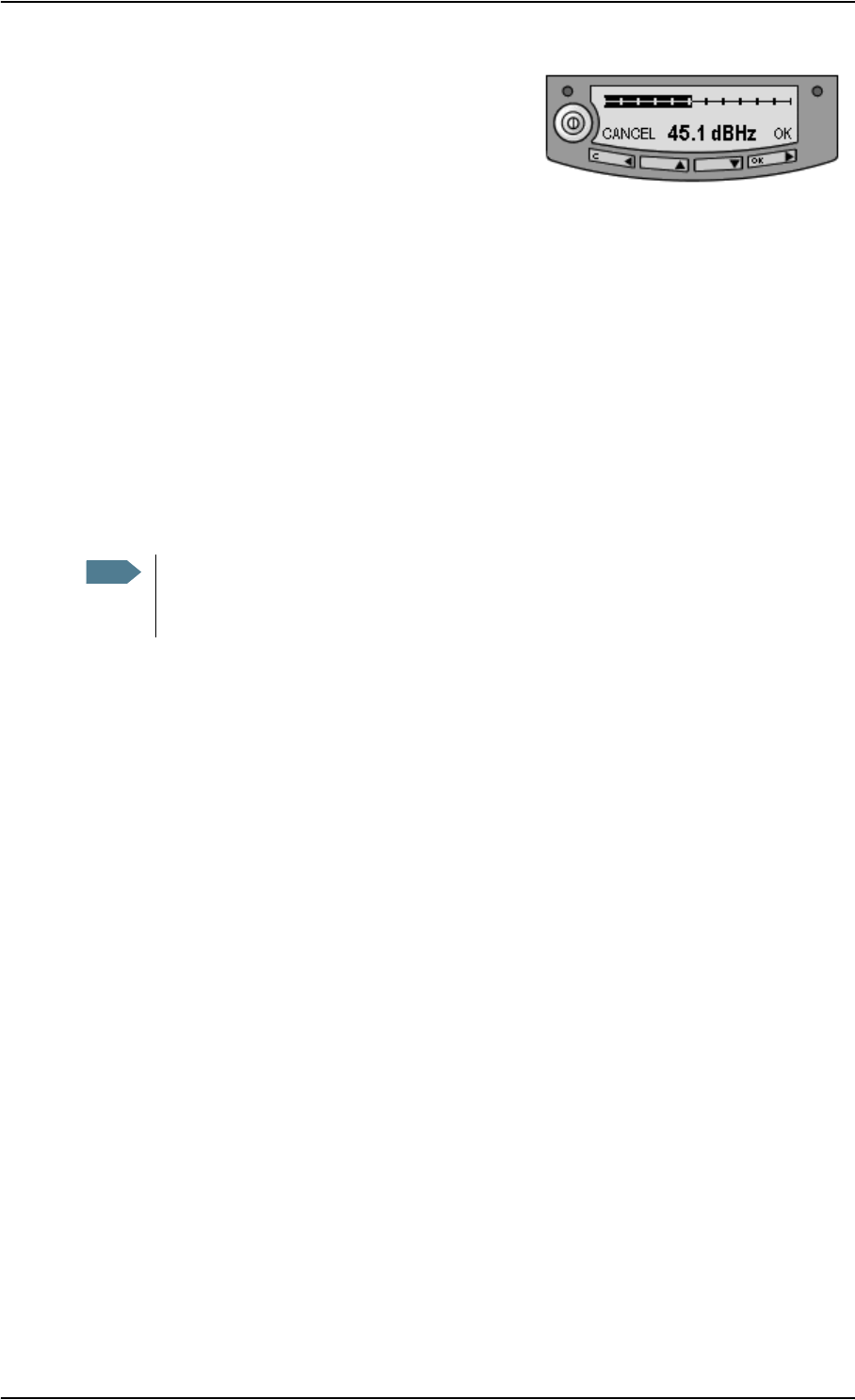
Chapter 2: Getting started
TT 98-123571-DraftA 24
4. When you have the highest signal strength you
can obtain, press OK on the keypad.
The EXPLORER™ 300 now tries to establish a connection to the BGAN network.
The display shows the progress as follows:
•SEARCHING:
The EXPLORER™ 300 searches for the network operator. Note that the search procedure
can be very short, so you may not see this text.
•REGISTERING:
The EXPLORER™ 300 is registering itself on the network.
If the GPS position has not yet been acquired at this point, the display will show
NO GPS. For further information, see the Troubleshooting Guide on page 117.
•READY or DATA ACTIVE:
READY means the EXPLORER™ 300 is registered on the network and is ready to go online.
If you have already connected a computer, the display shows DATA ACTIVE instead of
READY.
CANCEL: If you press C instead of OK, you exit the pointing menu and the display shows the Main
screen with the message POINT NOW?.
If the PIN has been accepted, you now have access to the menu system, but you will not be able to
connect to the BGAN network, because the signal strength has not yet been accepted.
Note The display may show a different text than READY or DATA ACTIVE if there is more
important information to show. For example, the display will show ENTER PIN? if you
pressed C at the first request for a PIN. See also the Troubleshooting Guide on page 117.

Chapter 2: Getting started
TT 98-123571-DraftA 25
Using a fixed EXPLORER™ 300 (semi-fixed installation)
You can keep the EXPLORER™ 300 in a fixed position, using the Pole mount kit for
EXPLORER™ 300. See Options and accessories on page 115 for information on type number.
Do as follows:
1. Mount the EXPLORER™ 300 on a pole or a wall, for example using the Pole mount kit.
A size M6 thread fits into the mounting bush in the back of the EXPLORER™ 300.
2. Start up the EXPLORER™ 300 and point the antenna as described in Pointing the antenna on
page 21.
3. Accept the signal strength by pressing OK on the EXPLORER™ 300 keypad.
4. Fasten the EXPLORER™ 300 in the pointed position.
You only have to point the antenna once, when you mount it. Using a computer connected to the
EXPLORER™ 300, you can set up the EXPLORER™ 300 to skip pointing at power up. Refer to
Pointing at power up on page 85.
Note The EXPLORER™ 300 is not suited for permanent outdoor installation.

Chapter 2: Getting started
TT 98-123571-DraftA 26
Making the first call
Introduction
After connecting cables, entering the PIN and pointing the antenna, you are ready to make or
receive the first call.
The following sections provide a short guide to making calls. For more detailed information, see
Making or receiving a phone call with the EXPLORER™ 300 on page 54.
Making a call from the EXPLORER™ 300
Your phone must be connected to the relevant interface. For further information, see
•Standard phone: Before connecting to the Phone interface on page 51
• Bluetooth handset: Pairing devices in which you can enter a passkey on page 50.
To make a call from a phone connected to the EXPLORER™ 300, dial
00 <country code> <phone number> followed by # or off-hook key (# on analog phones, off-hook
key on Bluetooth handsets).
Example: To call Thrane & Thrane in Denmark (+45 39558800) from an analog phone,
dial 00 45 39558800 #
Making a call to the EXPLORER™ 300
To make a call to a phone connected to the EXPLORER™ 300, dial
+870 <Mobile subscriber number>
•+ is the prefix used in front of the country code for international calls. This is 00 when calling
from most countries in Europe and from many other countries.
•Mobile subscriber number: The mobile subscriber number of the EXPLORER™ 300 you are
calling.
If the mobile subscriber number of the EXPLORER™ 300 is available on the SIM card, it is
listed in the display menu system of the EXPLORER™ 300 under PROPERTIES > MOBILE
NUMBERS. If it is not available, refer to your airtime subscription.
Example: If you are calling from Denmark to the EXPLORER™ 300 and the mobile subscriber
number is 772112345 on your EXPLORER™ 300, dial 00 870 772112345.

Chapter 2: Getting started
TT 98-123571-DraftA 27
Making a call from one EXPLORER™ 300 to another EXPLORER™ 300
To make a call from one EXPLORER™ 300 to another EXPLORER™ 300,
dial 00 870 <Mobile subscriber number>.
Receiving a call
To be able to receive a call, the phone must be connected to the correct interface of the
EXPLORER™ 300 (Phone or Bluetooth).
To be able to receive a call with a Bluetooth handset, the handset must be paired with the
EXPLORER™ 300. For information on how to pair Bluetooth devices, see Bluetooth pairing on
page 50.
You can see unanswered calls in the CALLS menu of the display and the web interface.
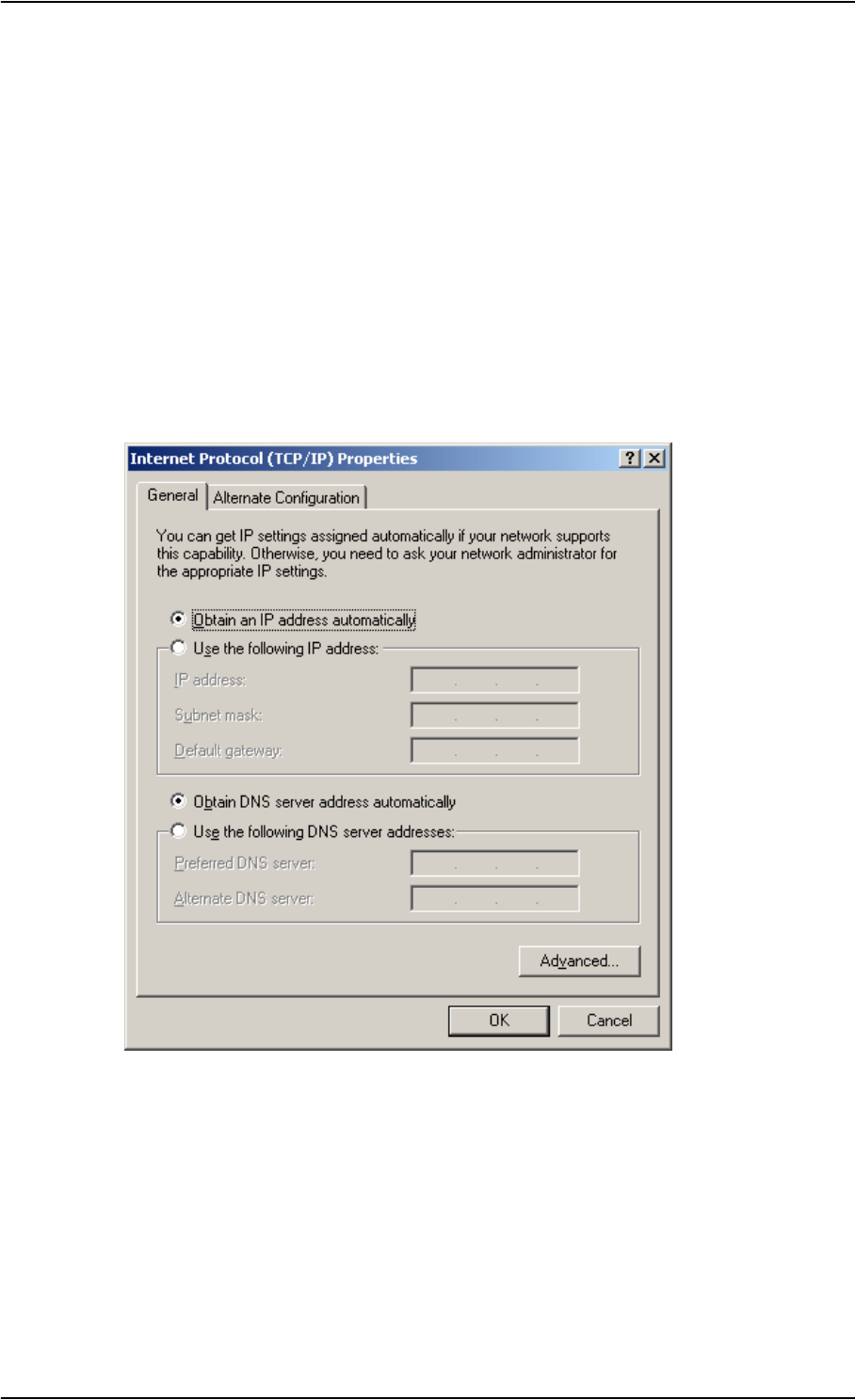
Chapter 2: Getting started
TT 98-123571-DraftA 28
Making the first data connection (LAN)
Before connecting to the LAN interface
For the LAN (Local Area Network) interface to work without any further setup, the computer must
be set up to obtain an IP address and a DNS server address automatically.
To check these settings on your computer, do as follows (For Windows® XP):
1. From the Start menu, select Connect To > Show All Connections.
2. Double-click Local Area Connection and click Properties.
3. Select Internet Protocol (TCP/IP) from the list and click Properties.
Make sure both fields are set to obtain an address automatically.

Chapter 2: Getting started
TT 98-123571-DraftA 29
Connecting to the LAN interface
Do as follows:
1. Connect the LAN cable to the network interface of your computer.
A suitable cable is provided with your EXPLORER™ 300.
2. Connect the other end of the cable to the LAN connector on the EXPLORER™ 300.
3. Start up and point the EXPLORER™ 300 as described earlier in this chapter.
4. Power on the computer.
5. When power up and pointing is completed, check the connection e.g. by starting your Internet
Browser.
You may have to disable the Proxy server settings in your browser. For further information,
see Browser settings on page 68.
What’s next?
After reading this chapter you should be able to start up the EXPLORER™ 300 and make a simple
data or voice connection.
The next chapters provide more information on the user interfaces and the setup of the
EXPLORER™ 300. The following chapter, Using the display and keypad, explains the display menu
system, which is the basic tool for setting up the EXPLORER™ 300.

TT 98-123571-DraftA 30
Chapter 3
Using the display and keypad 3
In this chapter
This chapter describes how to use the built-in display menu system of the EXPLORER™ 300.
It contains an overview of the entire menu system followed by a description of each menu.
It also explains the symbols and messages that may appear in the display, and describes how to
navigate using the keypad.
Menu overview
Main menu
The items of the main menu are:
•MESSAGES
shows all incoming SMS messages and allows you to open or delete each message or delete
all messages.
•CONNECT
shows a list of the Streaming Profiles that are defined and selected for the LAN interface using
the web interface. The CONNECT menu allows you to start and stop data sessions with the
listed Streaming Profiles.
•CALLS
shows missed, received and outgoing calls (Voice only).
•SETTINGS allows you to
• restart the pointing procedure,
• set display backlight and contrast,
• set audio indications on or off,
• enable or disable each interface,
• enable or disable stealth mode (a terminal mode where lights and sound are off),
• set the power up mode, and
•restore settings.
•PROPERTIES shows:
• known and accepted Bluetooth devices,
•GPS status,
• IP address, hardware and software numbers,
• IMEI number, mobile subscriber numbers and voice mail numbers, and
• a list of active alarms.
•HELP DESK
shows the phone number to the Airtime Provider, if available.
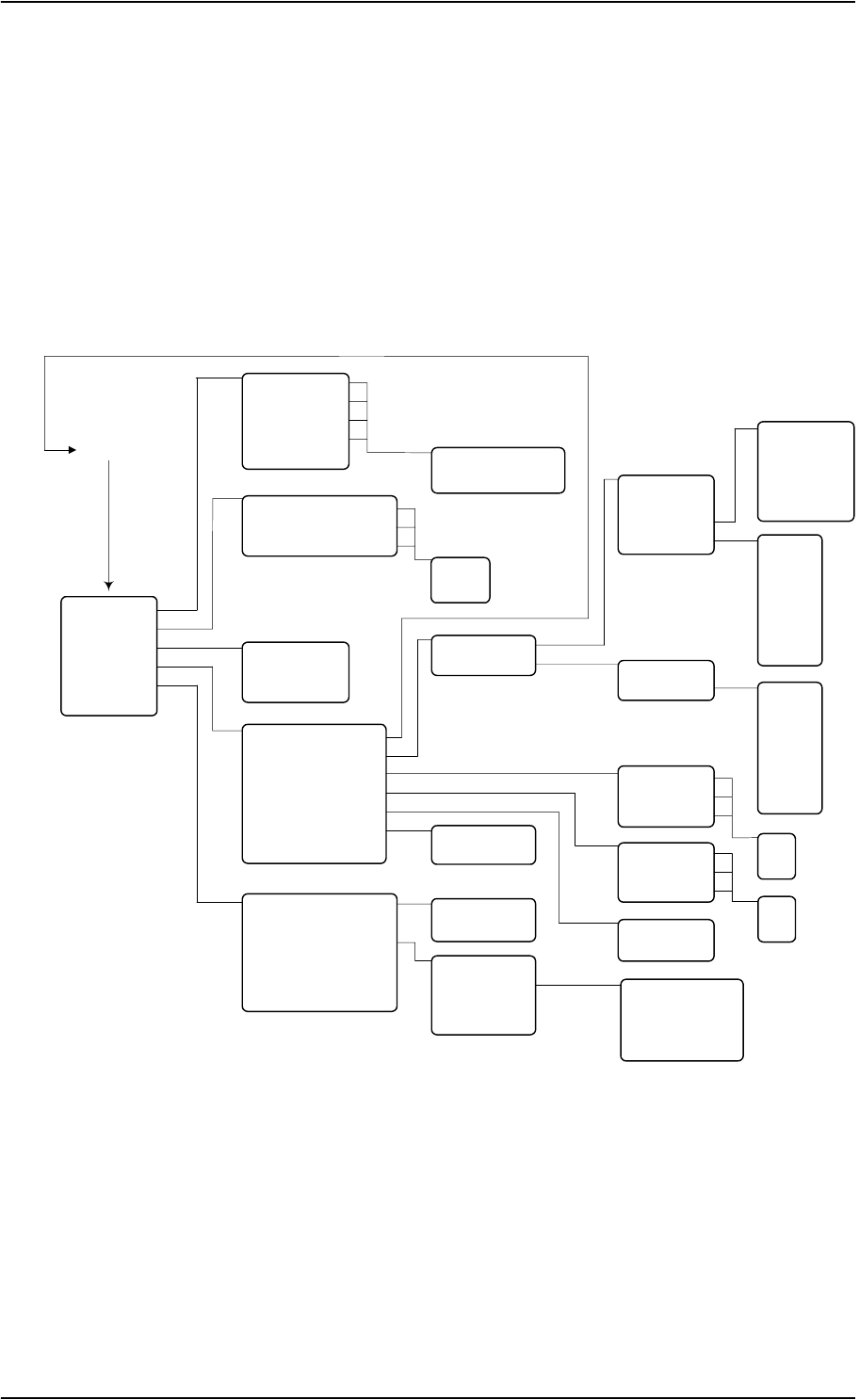
Chapter 3: Using the display and keypad
TT 98-123571-DraftA 31
For information on how to navigate in the menu system, see Navigating the display and keypad on
page 34.
Menu drawing
The below drawing shows an overview of the menus in the display menu system of the
EXPLORER™ 300.
The next section shows an overview of the start-up sequence before entering the menu system.
The menus are further described in the following sections of this chapter.
BLUETOOTH DEVICES
GPS STATUS
TERMINAL
MOBILE NUMBERS
VOICE MAIL NUMBER
ALARM LIST
<message 1>
<message 2>
<message 3>
<message 4>
DELETE ALL
MESSAGES
CONNECT
CALLS
SETTINGS
PROPERTIES
HELP DESK
MISSED
RECEIVED
OUTGOING
POINT NOW
DISPLAY
AUDIO INDICATOR
INTERFACES
STEALTH MODE
POWER UP MODE
RESTORE SETTINGS
2 SECONDS
5 SECONDS
10 SECONDS
30 SECONDS
60 SECONDS
LEVEL 1
LEVEL 2
LEVEL 3
LEVEL 4
LEVEL 5
LEVEL 6
LEVEL 7
1 <device>
2 <device>
IP ADDRESS
HARDWARE
SOFTWARE
IMEI
ON
OFF
TIMED
SET LEVEL
OPEN
DELETE MESSAGE
AUTOMATIC
SET LEVEL
LEVEL 1
LEVEL 2
LEVEL 3
LEVEL 4
LEVEL 5
LEVEL 6
LEVEL 7
POINTING
MESSAGES
ALARM
ON
OFF
PHONE
BLUETOOTH
LAN
ENABLED
DISABLED
AUTOMATIC
MANUAL
PIN Code
Start up
BACKLIGHT
CONTRAST
ON
OFF
UNIT SER. NO.
MAIN PCB NO.
PSM PCB NO.
MAC
(Pointing)
<streaming profile 1>
<streaming profile 2>
<streaming profile 3>
START
STOP
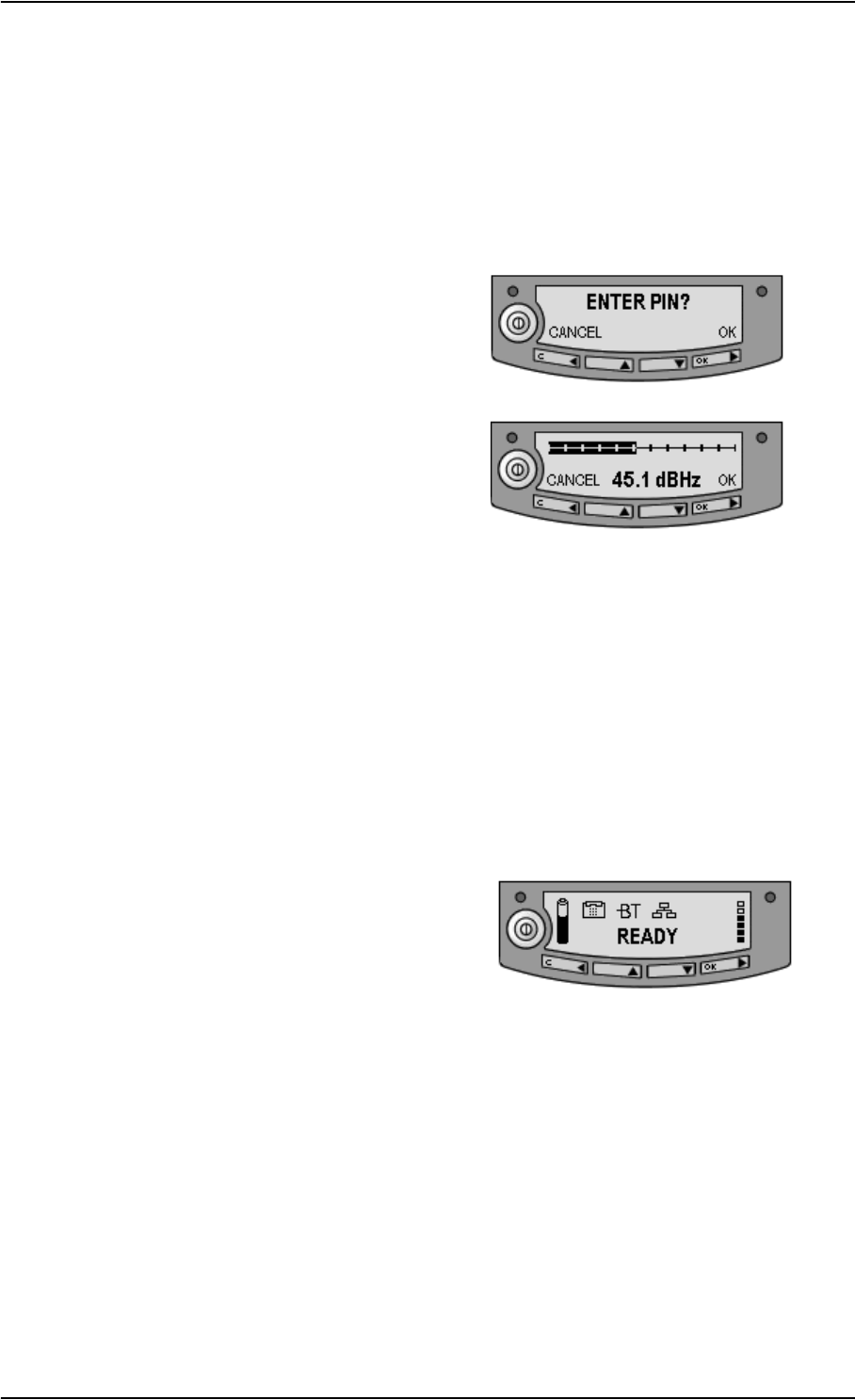
Chapter 3: Using the display and keypad
TT 98-123571-DraftA 32
Display during start-up
Start-up sequence
There are different options for the start-up procedure. The complete startup procedure is
described in Chapter 2, Getting started.
This section only describes the behavior of the display during normal startup.
After power on you are asked for a PIN.
When you press OK and enter PIN, the signal
strength screen appears.
When you have pointed the antenna and pressed OK to accept the signal strength, the display
shows the progress in the Main screen as follows:
•SEARCHING: The EXPLORER™ 300 is searching for the network operator.
•REGISTERING: The EXPLORER™ 300 is registering itself on the BGAN network.
If the GPS position has not yet been acquired at this point, the display will show
NO GPS. For further information, see the Troubleshooting Guide on page 117.
•READY: The EXPLORER™ 300 is registered on the network and is ready to go online.
If a computer is already connected, the display will show DATA ACTIVE instead of READY.
Main screen
The Main screen is shown after passing the PIN
and pointing screens, and anytime you leave the
menu system.
The Main screen shows the most important status
of the EXPLORER™ 300 such as battery status,
signal strength, and general status.
The Main screen also shows icons for any interfaces that are turned on.
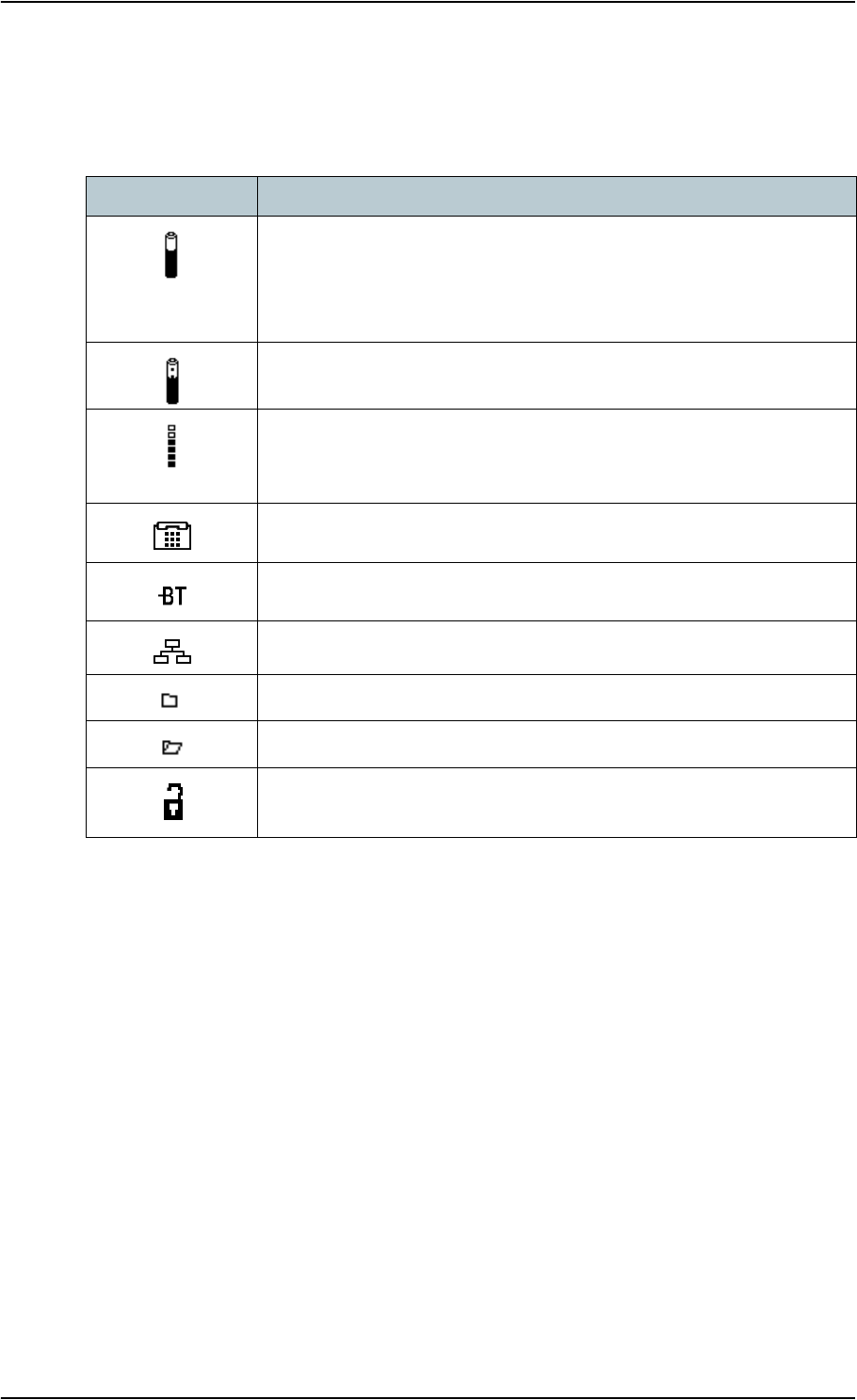
Chapter 3: Using the display and keypad
TT 98-123571-DraftA 33
Display symbols
Apart from the menu text, the display can show various symbols. Below is a list of the possible
symbols with an explanation to each symbol.
Symbol Explanation
The battery charge level.
When the level is too low (below 10%) the icon flashes. Recharge the
battery as soon as possible.
If no battery is inserted, the symbol is not shown in the display.
The battery is charging.
The signal strength.
Minimum two bars are normally required to be able to make a Standard
Voice call.
Phone interface is on.
Bluetooth interface is on.
LAN interface is on.
Unread message (shown next to the message in the message list)
Read messages (shown next to the message in the message list)
The current connection on the BGAN network is not ciphered. Do not
transmit data that requires ciphering.

Chapter 3: Using the display and keypad
TT 98-123571-DraftA 34
Navigating the display and keypad
Navigating with the keypad
The PIN must be entered before you can access the menu system.
•To access the menu system from the Main screen, press S or T.
•To move up and down in the current menu, press S or T.
•To select the current menu item or setting, press OK.
•To escape the current menu/setting and return to the previous level, press C.
•To see the hidden part of long text strings, press X.
•To move backwards in the menu system, or in long text strings, press W.
•To adjust settings, press S and T.
Short-cuts
The following short-cuts are available in the menu system:
•To exit the menu system, press and hold C for one second. The display returns to the Main
screen.
•To activate/deactivate Stealth mode, Press C+OK.When stealth mode is activated, the display
shows STEALTH ACTIVATED for a moment; then all lights and sounds are turned off.
•To turn Pointing sound on/off, Press S or T from the pointing screen.
This action only applies to the current pointing session. To turn the sound on or off for all pointing
sessions, select
SETTINGS > AUDIO INDICATORS > POINTING and select ON or OFF.
Note In low temperatures the display may respond slowly when a key is pressed. At
temperatures close to -25°C/-13°F the display may even turn black for a moment, e.g.
when you are scrolling through a menu. After 1-2 seconds with no keypad activity the
display will be readable again.
Note For Stealth mode to be available, it must be enabled in the EXPLORER™ 300. Refer
to Enabling or disabling stealth mode on page 40.
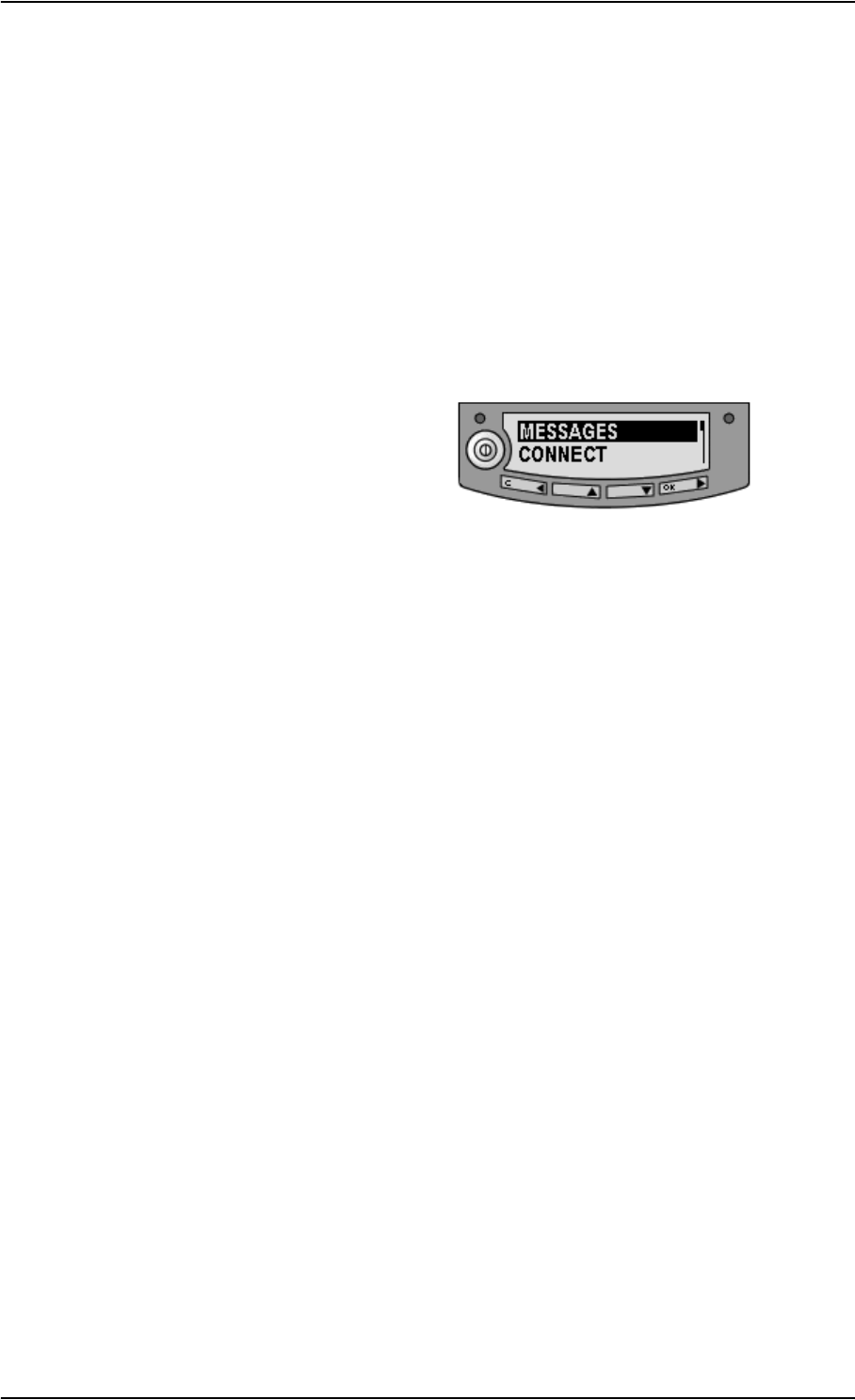
Chapter 3: Using the display and keypad
TT 98-123571-DraftA 35
Display text
When you have not entered the menu system, the Main screen shows the currently most important
information. Refer to Dynamic information in the display on page 45.
CANCEL in the left side of the display means: Press C to cancel the current operation.
OK in the right side of the display means: Press OK to accept the current operation.
The menus
The following sections describe each of the menus in the menu system.
All available settings and status items are explained.
To access the menu system from the main
screen, press S or T.

Chapter 3: Using the display and keypad
TT 98-123571-DraftA 36
Messages menu
Viewing the list of messages
To see the list of SMS messages, enter the menu system and select MESSAGES.
Each message is listed with the name (if known) or the number of the sender.
An unopened folder indicates an unread message and an opened folder indicates a read
message.
Use S and T to scroll through the list.
For information on how new messages are presented, see Received messages on page 45.
Opening or deleting received SMS messages
To delete all messages, go to the bottom of the list of messages and select DELETE ALL.
To open or delete one message, do as follows:
1. In the MESSAGES list, select the message you want to open or delete and press OK.
2. Then select one of the following:
•OPEN: to open the selected message.
The display shows the time and the message contents. Use S and T to scroll through the
message and details.
•DELETE: to delete the selected message.

Chapter 3: Using the display and keypad
TT 98-123571-DraftA 37
Connect menu
Streaming Profiles
Using the web interface you can define a number of Profiles for data transmission. The Streaming
Profiles defined and selected for the LAN interface appear in the CONNECT menu, and can be
started and stopped using the keypad.
Streaming Profiles are Profiles where the Traffic Class is set to Streaming in the Profiles window of
the web interface.
For information on Profiles, see Using Profiles on page 106.
For information on Streaming, see Standard or Streaming data on page 60.
Starting or stopping a Streaming session
To start or stop a Streaming session on the LAN interface, do as follows:
1. Select CONNECT.
2. Select the Streaming Profile you want to start or stop.
The list only shows Profiles that have been selected for the LAN interface.
For information on how to set up the LAN interface, see Configuring the LAN interface on
page 90.
3. Select START or STOP and confirm.
You can also start/stop Streaming sessions using the web interface. For further information, see
Setting up and activating a Streaming connection on page 60.
Important When running a Streaming session you are charged for the time you are
connected. An active Streaming session will stay active until you stop it.

Chapter 3: Using the display and keypad
TT 98-123571-DraftA 38
Calls menu
To see a list of calls or data sessions, do as follows:
1. Select CALLS.
2. Select one of the following:
•MISSED: to see a list of incoming calls that were not answered.
•RECEIVED: to see a list of incoming calls that were answered.
•OUTGOING: to see a list of outgoing calls or data sessions.
3. Select a call from the list to see details such as time, date and phone number.
If there was an error, the call log shows the cause of the error when possible.
When there are more than 100 calls in the list, the oldest calls are automatically deleted to make
room for new calls.
If you need to preserve the call log, you can export it to a file using the built-in web interface. For
further information, see Exporting the call log on page 77.
Note Local calls are not registered.

Chapter 3: Using the display and keypad
TT 98-123571-DraftA 39
Settings menu
Point now
If you need to repoint the antenna, select SETTINGS > POINT NOW.
This will bring you to the Pointing screen, described in Pointing the antenna towards the satellite
on page 23.
Setting the display backlight
To adjust the backlight of the display, do as follows:
1. Select SETTINGS > DISPLAY > BACKLIGHT.
From this menu you can set the backlight of the display.
2. Select one of the following:
•ON: to turn the light on.
•OFF: to turn the light off.
•TIMED: to set how long the light should be on after the last key was pressed (2, 5, 10, 30 or
60 seconds).
•SET LEVEL: to set the level of backlight.
Setting the display contrast
To adjust the contrast of the display, do as follows:
1. Select SETTINGS > DISPLAY > CONTRAST.
From this menu you can set the contrast of the display.
2. Select one of the following:
•SET LEVEL: to set the contrast manually.
•AUTOMATIC: to let the EXPLORER™ 300 automatically adjust the contrast according to
the temperature.
The contrast of the display is affected by the temperature. The EXPLORER™ 300 can
automatically adjust the contrast so that the display looks the same, regardless of changes
in the temperature.
Important This function will interrupt any ongoing calls or sessions!

Chapter 3: Using the display and keypad
TT 98-123571-DraftA 40
Turning audio indicators on or off
The EXPLORER™ 300 has audio indicators to indicate an event. You can turn each of these audio
indicators on or off.
1. Select SETTINGS > AUDIO INDICATOR.
2. Select one of the following:
•POINTING: a sound to indicate the signal level during pointing.
•MESSAGES: a sound to indicate that a message has arrived.
•ALARM: a sound to indicate that an alarm is present.
3. Select ON or OFF.
Enabling or disabling interfaces
Each interface can be disabled to minimize the power consumption. Specially if the
EXPLORER™ 300 is battery powered, it is a good idea to disable unused interfaces. Do as follows:
1. Select SETTINGS > INTERFACES.
2. Select one of the following interfaces:
•PHONE
•BLUETOOTH
•LAN
3. Select ON or OFF.
Enabling or disabling stealth mode
When the EXPLORER™ 300 is in stealth mode, all lights and sounds are turned off. You can still
use the EXPLORER™ 300, and the display text is readable.
To enable or disable the use of stealth mode, do as follows:
1. Select SETTINGS > STEALTH MODE.
2. Select one of the following:
•ENABLED
•DISABLED
• To activate Stealth mode (after enabling Stealth mode), press C+OK on the keypad.
• To deactivate Stealth mode, press C+OK again.
Note Enabling stealth mode will not put the EXPLORER™ 300 into stealth mode, it only
enables the use of stealth mode.

Chapter 3: Using the display and keypad
TT 98-123571-DraftA 41
Setting the power up mode
By default, the EXPLORER™ 300 starts up automatically when you apply external power. You can
change this mode, so that you always have to press the Power button to switch on the
EXPLORER™ 300.
To set the power up mode, do as follows:
1. Select SETTINGS > POWER UP MODE.
2. Select one of the following:
•AUTOMATIC: to have the EXPLORER™ 300 power up automatically when external power
is applied.
•MANUAL: to have the EXPLORER™ 300 power up only when the Power button is pressed.
Restoring settings
You can restore default values for the settings in the SETTINGS menu, except the contrast
setting. The following settings are restored:
•Backlight
• Audio indicators
• Stealth mode
• Interfaces enabled
•Power up mode
Note that all other settings are left unchanged.
To restore settings, do as follows:
1. Select SETTINGS > RESTORE SETTINGS.
2. Press OK.
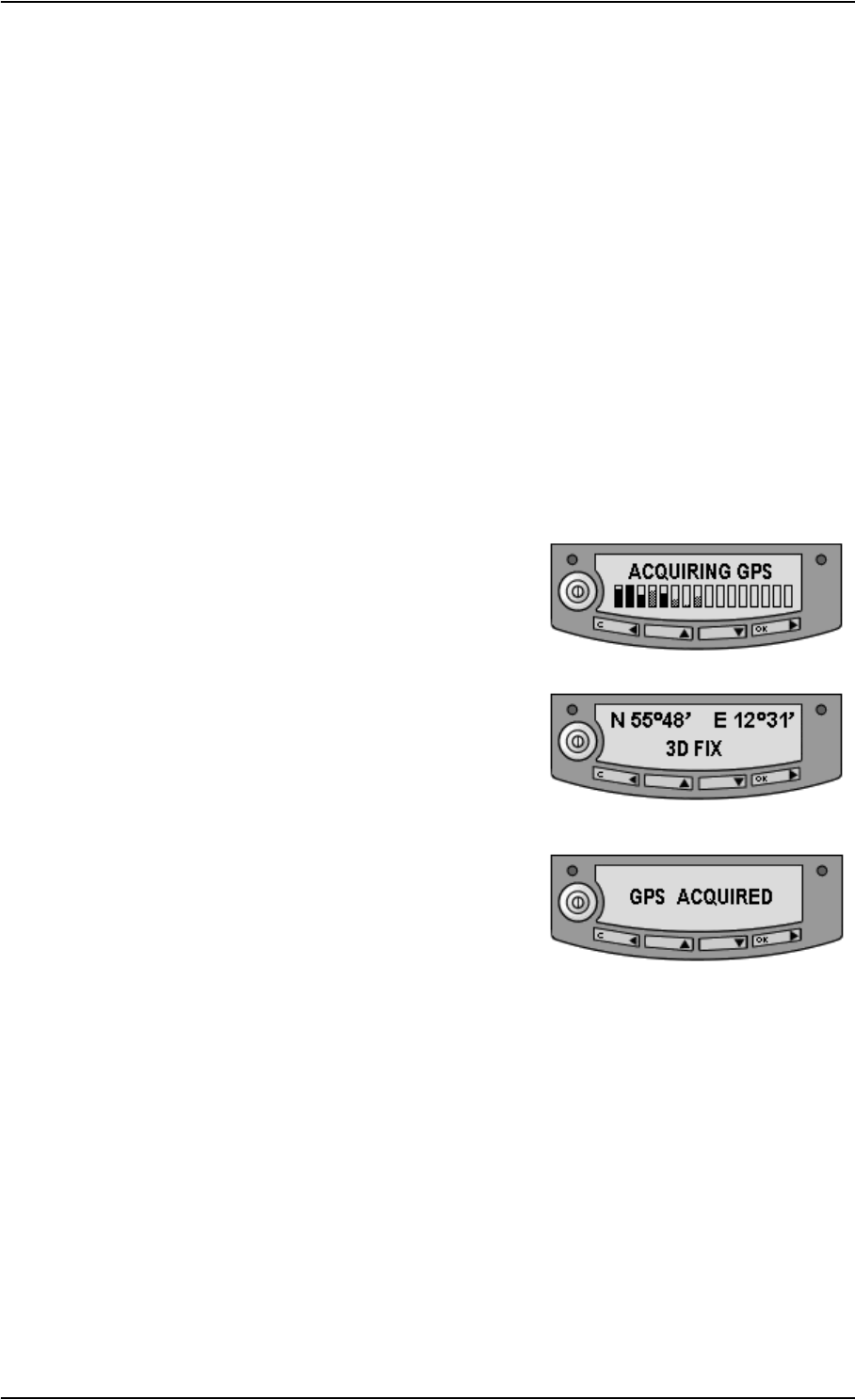
Chapter 3: Using the display and keypad
TT 98-123571-DraftA 42
Properties menu
Viewing known Bluetooth devices
You can view a list of the Bluetooth devices that are paired with the EXPLORER™ 300. The devices
are listed with their Bluetooth names.
The devices in this list can communicate with the EXPLORER™ 300 without any further setup.
To view the list of known Bluetooth devices, select
PROPERTIES > BLUETOOTH DEVICES.
To see details on a specific Bluetooth device, select the device in the list and press OK.
Viewing the GPS status
The display can show the current GPS status.
To view the GPS status, select PROPERTIES > GPS STATUS.
The GPS status screen can vary, depending on the situation.
• If the GPS position has not yet been obtained, the
display shows the status of each of the 16 GPS
satellites as follows:
• If the GPS position is known, the display shows
the GPS position, and whether it is a 2-
dimensional or 3-dimensional position (2D fix or
3D fix).
• In some cases, the BGAN network does not allow
the position to be displayed to the user. If this is
the case, the display may just show GPS
ACQUIRED. This means that the GPS position is
received, but the user is not allowed to see it.
This also applies if the EXPLORER™ 300 is not yet
registered on the BGAN network, but the GPS
position is received.

Chapter 3: Using the display and keypad
TT 98-123571-DraftA 43
Viewing terminal properties
You can view properties of the EXPLORER™ 300 such as IP address, hardware numbers, software
version and IMEI number. When contacting Support, please include these numbers.
To view the properties, do as follows:
1. Select PROPERTIES > TERMINAL.
2. Select one of the following options:
•IP ADDRESS to see the IP address of the EXPLORER™ 300. This IP address is used to
access the web interface of the EXPLORER™ 300. The web interface is a built-in web server
used to configure and set up the EXPLORER™ 300. For further information on the web
interface, see Using the web interface on page 67.
•HARDWARE to see the serial number, PCB numbers and MAC address of your
EXPLORER™ 300.
•SOFTWARE to see the software version of the EXPLORER™ 300.
•IMEI to see the IMEI number (International Mobile Equipment Identity) of the
EXPLORER™ 300. This is the unique mobile equipment number that identifies your
EXPLORER™ 300. The IMEI number is also printed on the serial number label at the back of
the terminal.
Viewing mobile subscriber numbers
If available on the SIM card, the MOBILE NUMBERS menu lists the mobile subscriber number to
use when calling the EXPLORER™ 300.
To view the mobile subscriber number, select PROPERTIES > MOBILE NUMBERS.
If the mobile number is not available, the display reads
NO INFORMATION AVAILABLE.
Viewing the voice mail number
The EXPLORER™ 300 informs you of any incoming voice mail through the display and through the
web interface.
The voice mail number is the number you call to hear your incoming voice mail.
If available on the SIM card, the PROPERTIES menu shows the voice mail number.
To view the voice mail number, select
PROPERTIES > VOICE MAIL NUMBER.
If the voice mail number is not available, the display reads
NO INFORMATION AVAILABLE.

Chapter 3: Using the display and keypad
TT 98-123571-DraftA 44
Alarm list
If an error is present in the system, an alarm will be issued. For information on how new alarms
are presented, see Display of alarm messages on page 122.
To view the list of currently active alarms, enter the menu system and select
PROPERTIES > ALARM LIST.
The alarms are listed with their ID numbers.
To see the name and time stamp of the alarm, press OK.
Use S and T to scroll through the name, ID and time stamp. If the text is too long, press OK (X)
to scroll through the rest of the text.
Help desk
If you need support regarding airtime, you may call the Airtime Provider help desk.
To see the help desk number, select HELP DESK in the menu system.
The display will show the name and phone number of your Airtime Provider, if it is available on
the SIM card.
If the information is not available on the SIM card, you can use the built-in web interface of the
EXPLORER™ 300 to store the help desk name and number. For further information, see Accessing
the Help desk on page 111.
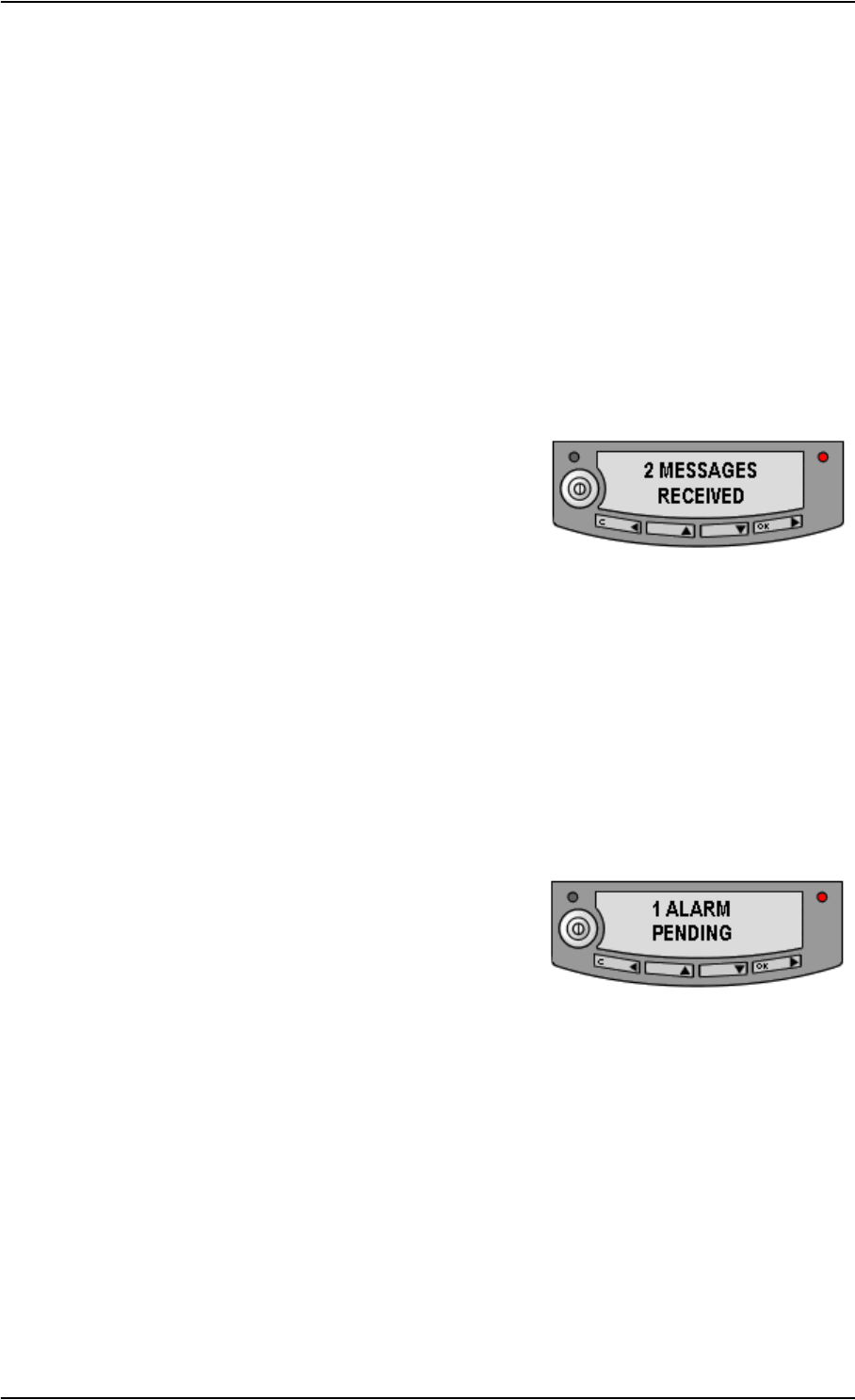
Chapter 3: Using the display and keypad
TT 98-123571-DraftA 45
Dynamic information in the display
Types of display information
Text in the display can be:
• Information of received messages.
• Alarms.
•Status information.
•Request for action.
Received messages
When messages arrive in your EXPLORER™ 300, the
display indicates the number of new messages that have
arrived, and the red message indicator is flashing.
The messages can be SMS messages or notification of
voice mail.
•If the message is an SMS message, press OK to view the message.
•If the message is information of voice mail, press OK or C to go back to the Main screen.
The red message indicator will keep flashing until you have collected your voice mail.
• To hear your voice mail, call the voice mail service number provided by your Airtime Provider.
• To see the voice mail service number, select
PROPERTIES > VOICE MAIL NUMBER
Alarms
When alarms are issued in your EXPLORER™ 300, the
display indicates the number of new alarms, and the red
message indicator is flashing.
To view currently active alarms, press OK. To ignore and continue, press C.
See also:
•Display of alarm messages on page 122.
•Alarm log on page 127.
•List of alarms on page 123.

Chapter 3: Using the display and keypad
TT 98-123571-DraftA 46
Status information
Status information in the display is normally shown in the lower line of the Main screen.
Examples of status information are: READY, REGISTERING and DATA ACTIVE.
Displaying ongoing transmission
When a call or data session is in progress, the display shows DATA ACTIVE in the Main screen.
Request for action
A request for action, if it is not an alarm, is shown in the lower line of the display. This could be
e.g. POINT NOW? or INSERT SIM.
When the text is a question, press OK to accept.
What’s next?
This chapter has explained how to navigate in the display menu system and how to use it for basic
setup of the EXPLORER™ 300.
The following chapter, Using the interfaces, explains in detail how to set up and use each interface
of the EXPLORER™ 300.
WARNING! When the EXPLORER™ 300 is powered on, stay clear of the antenna
front! The antenna emits radio frequency energy, not only when the display shows
DATA ACTIVE. Always keep a minimum distance of 0.6 m from the antenna front.

TT 98-123571-DraftA In this chapter 47
Chapter 4
Using the interfaces 4
In this chapter
This chapter describes how to use the interfaces of the EXPLORER™ 300. For each connection type
it describes how to connect cables and the necessary setup to establish a connection.
It does not describe advanced configuration of interfaces. For this type of information, refer to the
“Configuring...” sections for the data interfaces in Chapter 5, Using the web interface.
General
Tools for setup and use
Overview
The display and keypad can be used for simple setup, but for enhanced use and for configuration
of interfaces, you need to connect a computer (PC, laptop or similar).
With a computer and a browser, you can use the following to set up the EXPLORER™ 300:
• The built-in web interface of the EXPLORER™ 300
•The BGAN LaunchPad
The web interface of the EXPLORER™ 300
The web interface is a built-in web server for setting up and controlling the EXPLORER™ 300,
using a connected computer with a browser. For information on how to use the web interface, see
Using the web interface on page 67.
The BGAN LaunchPad
BGAN LaunchPad from Inmarsat is a computer application for setting up terminals in the BGAN
system. A CD-ROM with the LaunchPad is included in the delivery. For information on how to use
the LaunchPad, refer to the user guide provided with the LaunchPad.

Chapter 4: Using the interfaces
TT 98-123571-DraftA General 48
Services and interfaces
A variety of services can be accessed from different interfaces on the EXPLORER™ 300.
The following table shows the possible combinations of services and interfaces, and which types of
equipment can be used.
Service
Interface on the EXPLORER™ 300
Phone Bluetooth LAN Display/
Keypad
Circuit Switched Connection
Standard
Voice
Analog
telephone
Bluetooth
handset
Packet Switched Connection
Data
single-user
Computer Computer
SMS Computer Computer View only

Chapter 4: Using the interfaces
TT 98-123571-DraftA General 49
Enabling or disabling an interface
Overview
By default, all interfaces are enabled. However, you can disable the LAN interface, the Bluetooth
interface and/or the Phone interface in order to minimize the power consumption.
Using display and keypad
To enable or disable an interface using the display and keypad, do as follows:
1. Enter the menu system.
From the Main screen, press S or T.
2. Select SETTINGS > INTERFACES.
3. Select the interface you want to enable or disable.
4. Select ON to enable or OFF to disable.
Using web interface
To enable or disable an interface using the web interface, do as follows:
1. Connect a computer. Refer to the relevant section in this chapter, e.g. Connecting to the LAN
interface on page 62.
2. Access the web interface.
For further information, see The web interface on page 67.
3. From the left navigation pane in the web interface, select
SETTINGS > Interfaces.
4. Select Enabled or Disabled next to the relevant interface.

Chapter 4: Using the interfaces
TT 98-123571-DraftA Bluetooth pairing 50
Bluetooth pairing
What is pairing?
Bluetooth Pairing happens when two Bluetooth enabled devices agree to communicate with one
another. When this happens, the two devices exchange passkeys and join a pair. The pairing
process only takes place the first time the two devices are connected. Once the two devices have
established a pair, they automatically accept communication when one device recognizes the
other device.
Pairing devices in which you can enter a passkey
This section describes how to pair devices in which you can enter a passkey.
For information on pairing devices with a fixed passkey from your EXPLORER™ 300, see Pairing
Bluetooth devices from the web interface on page 95.
The following procedure presupposes that the EXPLORER™ 300 is configured to be visible to other
Bluetooth devices, and that the Bluetooth interface is turned on. For information on configuration,
see Configuring the Bluetooth interface on page 93.
Do as follows to pair the devices:
1. Start up the EXPLORER™ 300.
For further information, see Getting started on page 11.
2. Turn on Bluetooth on your Bluetooth device and place it close to the EXPLORER™ 300.
3. On your Bluetooth device, search for new devices and select the EXPLORER™ 300 when it is
found.
The default Bluetooth name of the EXPLORER™ 300 is EXPLORER 300.
If there is more than one EXPLORER™ 300 in the list, you can use the MAC address to locate
the correct one. To see the MAC address of your EXPLORER™ 300, enter the display menu
system and select PROPERTIES > TERMINAL > HARDWARE > MAC.
4. On your Bluetooth device, enter the passkey of your EXPLORER™ 300.
The default passkey is the serial number of your EXPLORER™ 300. To see the serial number,
look at the label on the back of your EXPLORER™ 300, or enter the menu system and select
PROPERTIES > TERMINAL > HARDWARE > UNIT SER. NO.
The new device is now paired and ready to communicate with the EXPLORER™ 300.
Note The method for pairing devices may vary depending on your Bluetooth device. Consult
your Bluetooth device documentation for information.
Note Maximum 2 devices can be paired with the EXPLORER™ 300. If you have already paired
2 devices you have to unpair a device before you can pair a new one. For information on
how to unpair devices, see Unpairing devices on page 97.

Chapter 4: Using the interfaces
TT 98-123571-DraftA Using a phone 51
Using a phone
Connecting an analog phone
Before connecting to the Phone interface
To connect a phone to the Phone connector, you need an analog telephone cable with an RJ-11
connector. For specifications and pin-out, refer to Phone interface on page 131.
Connecting to the Phone interface
Do as follows:
1. Connect the cable to your phone.
2. Connect the other end of the cable to the Phone
connector on the EXPLORER™ 300.
3. Power up the EXPLORER™ 300 and point the antenna as described in Pointing the antenna on
page 21.
4. Check the connection by making a phone call.
See Making or receiving a phone call with the EXPLORER™ 300 on page 54.
If connection fails, check that the interface is enabled in the EXPLORER™ 300.
If the analog phone icon is not present in the display Main screen and in the Home window of the
web interface, the interface is disabled.
See Enabling or disabling an interface on page 49.
If the interface is enabled, but connection fails, refer to the Troubleshooting Guide on page 119.

Chapter 4: Using the interfaces
TT 98-123571-DraftA Using a phone 52
Connecting a Bluetooth handset
Before connecting a Bluetooth handset
To use a Bluetooth handset with the EXPLORER™ 300, you first have to pair the two devices.
For information on pairing devices, see Bluetooth pairing on page 50.
The Bluetooth handset must be placed within a maximum distance of 25 m from the
EXPLORER™ 300. Note that this is the maximum distance in open air; the actual maximum
distance may be shorter, depending on the environment. In an office environment, you should be
able to establish a connection to the adjoining room.
Connecting a paired Bluetooth handset
This section does not describe configuration of the Bluetooth interface. For information on
configuration, see Configuring the Bluetooth interface on page 93.
If the devices are already paired, do as follows to connect:
1. Power up the handset and the EXPLORER™ 300.
2. Place the handset close to the EXPLORER™ 300.
3. Turn on Bluetooth on your device.
The Bluetooth connection should now be established, and you are ready to make a call.
If connection fails, check that the interface is enabled in the EXPLORER™ 300.
If the Bluetooth icon is not present in the display Main screen and in the Home window of the web
interface, the interface is disabled.
See Enabling or disabling an interface on page 49.
If the interface is enabled, but connection fails, refer to the Troubleshooting Guide on page 120.
For information on how to make and receive calls, see Making or receiving a phone call with the
EXPLORER™ 300 on page 54.
Note Maximum 2 devices, 1 voice and 1 data device, can be connected at the same time.

Chapter 4: Using the interfaces
TT 98-123571-DraftA Using a phone 53
Entering the SIM PIN using a phone
Entering the PIN
If you have a phone connected to the EXPLORER™ 300, you can use it to enter the PIN at start up,
as an alternative to the keypad.
When the EXPLORER™ 300 is waiting for a PIN, you will hear 2 beeps - pause - 2 beeps - etc. in
your phone.
You simply dial the PIN the same way you would dial a phone number:
•For an analog phone, take the phone off hook and dial <PIN> followed by #. When you hear a
“busy” tone or a dialing tone, the PIN has been accepted and you can put the phone back on
hook.
•For a Bluetooth handset, dial <PIN> and press off hook key. When you hear a “busy” tone or a
dialing tone, the PIN has been accepted and you can press the on hook key or dial a number.
Wrong PIN
If, instead of the busy tone or dialing tone, you continue to hear 2 beeps - pause - 2 beeps - etc., it
means the PIN was wrong. Check that you have the correct PIN and try again.
If a wrong PIN has been entered three times, you will hear 3 beeps - pause - 3 beeps - etc. This
means you have to enter the PUK (PIN Unblocking Key) provided with your SIM card.
After entering the PUK, you must enter a new PIN of your own choice (4 to 8 digits long).
Dial the following:
<PUK> * <New PIN> * <New PIN> followed by # or off-hook key.
Example: If the PUK is 87654321 and the new PIN is 1234, dial
87654321 * 1234 * 1234 followed by # or off-hook key.
If you enter 10 wrong PUKs, the SIM card will no longer be functional. Contact your Airtime
Provider for a new SIM card.

Chapter 4: Using the interfaces
TT 98-123571-DraftA Using a phone 54
Making or receiving a phone call with the EXPLORER™ 300
Analog phone or Bluetooth handset
First connect your phone to the relevant interface. For further information, see Before connecting
to the Phone interface on page 51, or, for the Bluetooth handset, Pairing devices in which you can
enter a passkey on page 50.
Making a call
You have two methods for making a call:
•Short Dial. If the number is in the phone book of the EXPLORER™ 300, you can use the Short
Dial number, which is found in the first column of the phone book in the web interface. See
Short dial on page 76.
Simply dial 0 <Short Dial> followed by # or off-hook key.
Example: To call entry number 4 in the phone book,
dial 04 followed by # or off-hook key.
•Manual Dial. To make a call, dial
00 <country code> <phone number> followed by # or off-hook key.
Example: To call Thrane & Thrane in Denmark (+45 39558800) from an analog phone, dial
00 45 39558800 #
If there was an error establishing the connection, the web interface and the display of the
EXPLORER™ 300 show an error message. Refer to the Troubleshooting Guide on page 119.
Receiving a call
To be able to receive a call, the phone must be connected to the relevant interface on the
EXPLORER™ 300.
By default, all devices connected to the Phone interface or the Bluetooth interface will ring when
one of the mobile subscriber numbers is called.
Information of missed calls is stored in the call log of the EXPLORER™ 300. You can view the call
log with the display menu system or the web interface. See Calls menu on page 38 or Viewing the
lists of calls on page 78.
Note There are different methods for activating a call, depending on the type of phone:
•Analog phone: Dial # after the number.
•Bluetooth handset: Press the off-hook key after the number.

Chapter 4: Using the interfaces
TT 98-123571-DraftA Using a phone 55
Making a call to the EXPLORER™ 300
To make a call to a phone connected to the EXPLORER™ 300, dial
+870 <Mobile subscriber number>
•+ is the prefix used in front of the country code for international calls. This is 00 when calling
from countries in Europe and from many other countries.
•Mobile subscriber number. If the mobile subscriber numbers are available on the SIM card,
you can look them up using the display menu system or the web interface.
•Display menu system:
Enter the menu system and select PROPERTIES > MOBILE NUMBERS.
•web interface:
If a computer is connected, access the web interface, select PROPERTIES and locate the
Mobile subscriber numbers section. For further information on the web interface, see The
web interface on page 67.
If the mobile subscriber numbers are not available in the display menu system nor the web
interface, refer to your airtime subscription.

Chapter 4: Using the interfaces
TT 98-123571-DraftA Using a phone 56
Dialing functions
Overview
There are a number of dialing functions available in the EXPLORER™ 300.
The following list shows the allocated special-purpose numbers for the EXPLORER™ 300.
Apart from the numbers above, the EXPLORER™ 300 uses the following dialing prefixes:
•#31# before the phone number will hide the callers phone number to the recipient.
•*31# before the phone number will show the callers phone number to the recipient where it
would otherwise be hidden, e.g. because the number is an ex-directory number.
•R is used during a call to indicate that the following key-presses should activate a
supplementary services function. The supplementary services functions supported by the
EXPLORER™ 300 are described in the subsequent sections.
Number Function
0 * followed by # or off-hook key Redial last called number on this interface.
00 * followed by # or off-hook key Redial last answered call on this interface.
Note: If the last answered number is an unlisted
number, you will not be allowed to dial back.
0 followed by one of the numbers 1-199
and # or off-hook key
Short dial phone numbers in phone book.
0201 or 0202 followed by # or off-hook key Local call to Bluetooth handset.
0301 followed by # or off-hook key Local call to analog phone.
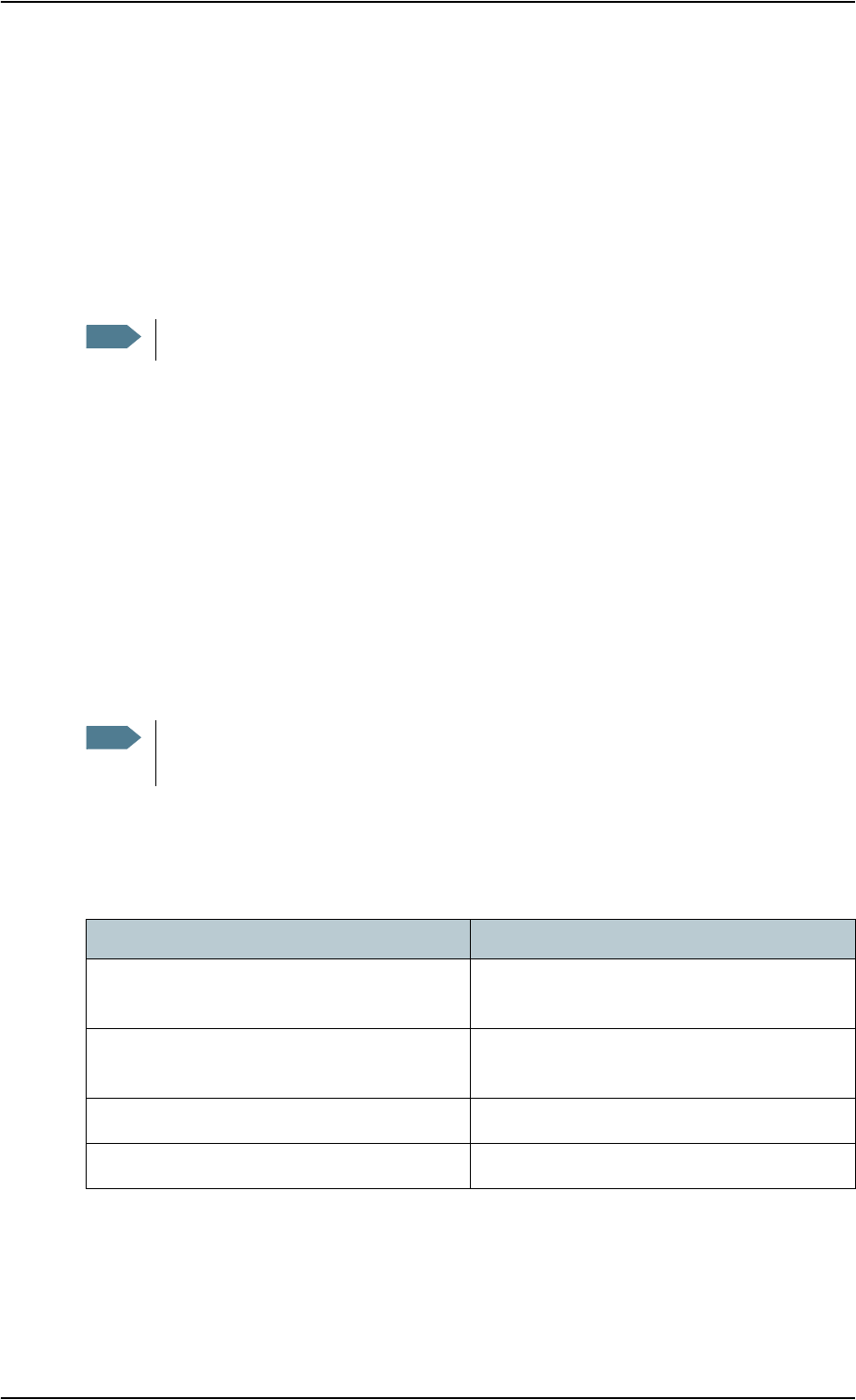
Chapter 4: Using the interfaces
TT 98-123571-DraftA Using a phone 57
Making local phone calls
You can make local calls between an analog phone and a Bluetooth handset connected to the
EXPLORER™ 300.
Local phone numbers always start with 0.
For an overview of the numbers, see Overview on page 56.
To make a local call, dial
<local number> followed by # or off-hook key.
You can look up the local Bluetooth phone numbers in the display or in the web interface as
follows:
•Display
Enter the menu system and select PROPERTIES > BLUETOOTH DEVICES. The list
shows accepted Bluetooth devices with local number and Bluetooth name.
•web interface
Access the web interface and select
SETTINGS > Interfaces > Bluetooth > Paired Devices.
The paired voice devices are listed with their local phone numbers.
Handling waiting calls
During a call, if a second party attempts to make contact with you, you will hear a Call Waiting
indication. The Call Waiting indication is two beeps and a pause of 3 seconds, then two beeps
again etc. If no action is taken, the waiting call is released after a time out period.
When you receive a Call Waiting indication, you have the following options:
Note You can only have one Bluetooth handset connected at a time.
Note The phone must have an R key to be able to use these functions.
The EXPLORER™ Bluetooth Handset uses a softkey in stead of the R key.
If you want to: Do as follows:
Clear the current call,
and accept the waiting call.
Press R 1 #, within the time out period.
Hold the current call,
and accept the waiting call.
Press R 2 #, within the time out period.
Ignore the waiting call. Take no action.
Reject the waiting call. Press R 0 #, within the time out period.
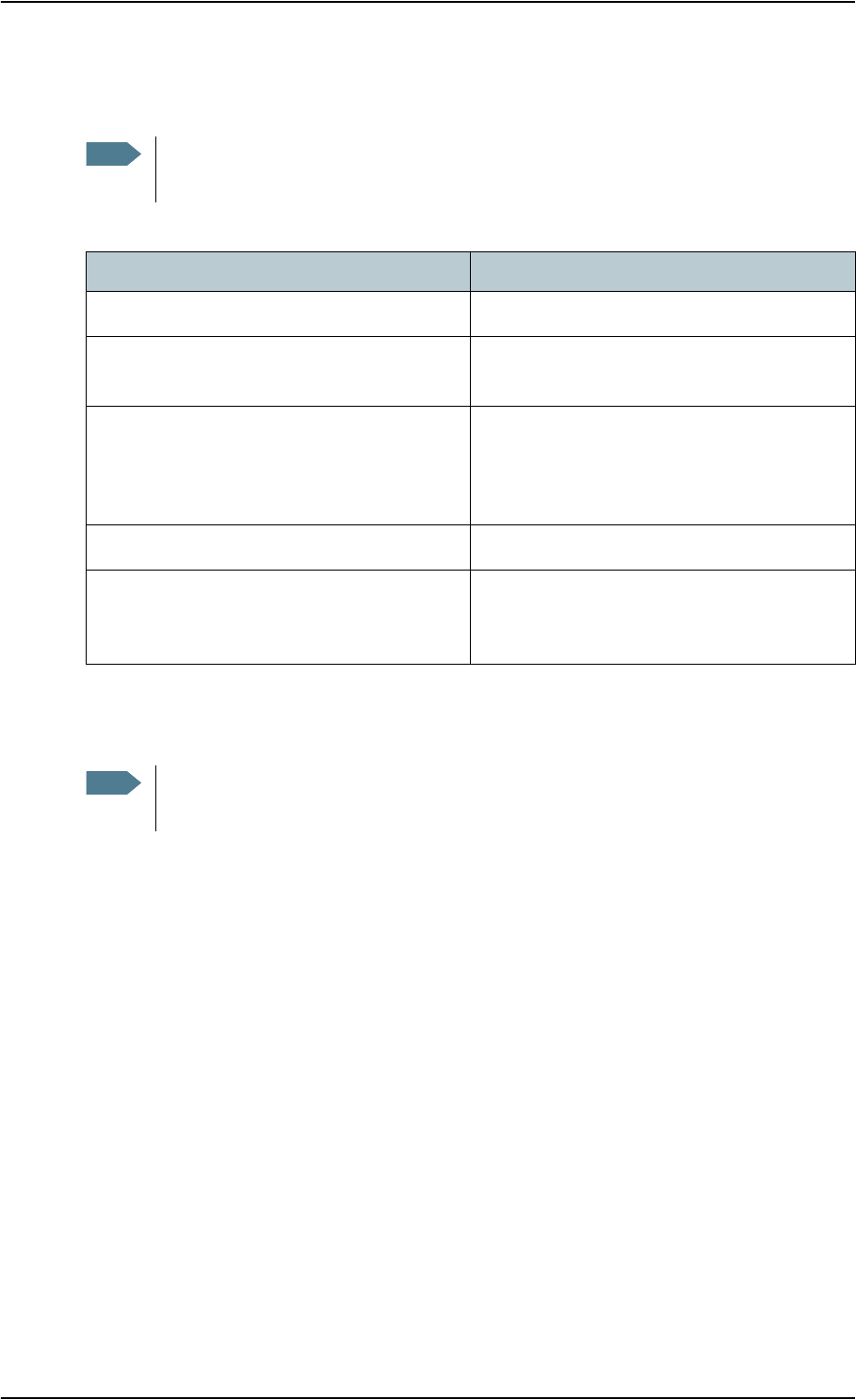
Chapter 4: Using the interfaces
TT 98-123571-DraftA Using a phone 58
Holding a call
During a call, you may place the initial call on hold while another call is made.
Transferring a call
When you receive a call, you can transfer this call to another phone or headset connected to the
EXPLORER™ 300.
To transfer the incoming call to another phone or headset, do as follows:
1. Press R 4 * <local number> #.
The phone or headset with the local number you dialed starts to ring.
If your phone and the recipient’s phone or headset are both Bluetooth devices, your phone is
now disconnected. When the call is answered, a connection is established between the initial
caller and the new recipient.
2. If only one or none of the devices are Bluetooth devices, you have two options.
• Hang up. The phone or headset you transferred the call to continues to ring. When the call
is answered, a connection is established between the initial caller and the new recipient.
• Do not hang up. When the new recipient answers, you can have a conversation before
hanging up. When you hang up, the call is handed over to the initial caller.
Note The phone must have an R key to be able to use these functions.
The EXPLORER™ Bluetooth Handset uses a softkey in stead of the R key.
If you want to: Do as follows:
Place a call on hold. Press R 2 #.
Place the existing call on hold and establish a
new call.
Press R and dial the second phone number
followed by #.
Shuttle between the two calls. Press R 2 #
(irrespective of whether the second call was
acquired using Call Hold or acceptance of Call
Waiting.)
Clear the held call, if no waiting call exists. Press R 0 #.
Clear an active call and return to the held call. Press R 1 #.
Note that this is only possible if no waiting
call exists.
Note The phone must have an R key to be able to use these functions.
The EXPLORER™ Bluetooth Handset uses a softkey in stead of the R key.

Chapter 4: Using the interfaces
TT 98-123571-DraftA Using a computer 59
Using a computer
Choosing an interface for data connection
The EXPLORER™ 300 has two types of interface for data connection: LAN and Bluetooth.
The following table shows some characteristics of each interface, to help you choose the right
interface for your application.
Interface Power
Consumption Amount of Setup Range
LAN High None
(or very little)
Up to 100 m of cable
Bluetooth Medium Can be complicated,
depending on
operating system.
Wireless connection.
Up to 25 m depending on the
transmitter in the computer and on
the transmission conditions.

Chapter 4: Using the interfaces
TT 98-123571-DraftA Using a computer 60
Standard or Streaming data
Definition
The BGAN network supports different classes of data connection to the Internet. The main classes
are Standard data and Streaming data.
• Using a Standard data connection, several users can share the data connection
simultaneously. This type of connection is ideal for TCP/IP traffic such as e-mail, file transfer,
and Internet and intranet access.
The user pays for the amount of data sent and received.
• Using a Streaming data connection, you get an exclusive, high-priority connection, ensuring
seamless transfer of data. This type of connection is ideal for time critical applications like live
video over IP.
The user pays for the duration of the connection (per minute charge).
You can set up various types of connection using the Profiles and a Traffic Flow Template. For
further information, see Using Profiles on page 106 and Using a Traffic Flow Template on page 109.
Setting up and activating a Streaming connection
By default, any data connection on the EXPLORER™ 300 is a Standard data connection.
If you want to set up a Streaming connection, select a Streaming Profile when setting up your data
interface. See the “Configuring...” section for your interface in Chapter 5, Using the web interface.
Before starting a Streaming session on the LAN interface, make sure you have set up the
Streaming Profile for the LAN interface.
To start or stop a Streaming session on the LAN interface, do as follows:
1. Access the web interface.
2. Go to the Home window and locate the field STREAMING PROFILES ON LAN.
3. Click the Start or Stop link of the relevant Streaming Profile.
Note For optimum performance it is important that you select the right traffic class when
defining Profiles for your connection.
Note When running a Streaming session you are charged for the time you are connected.
A started Streaming session will stay active until you stop it.
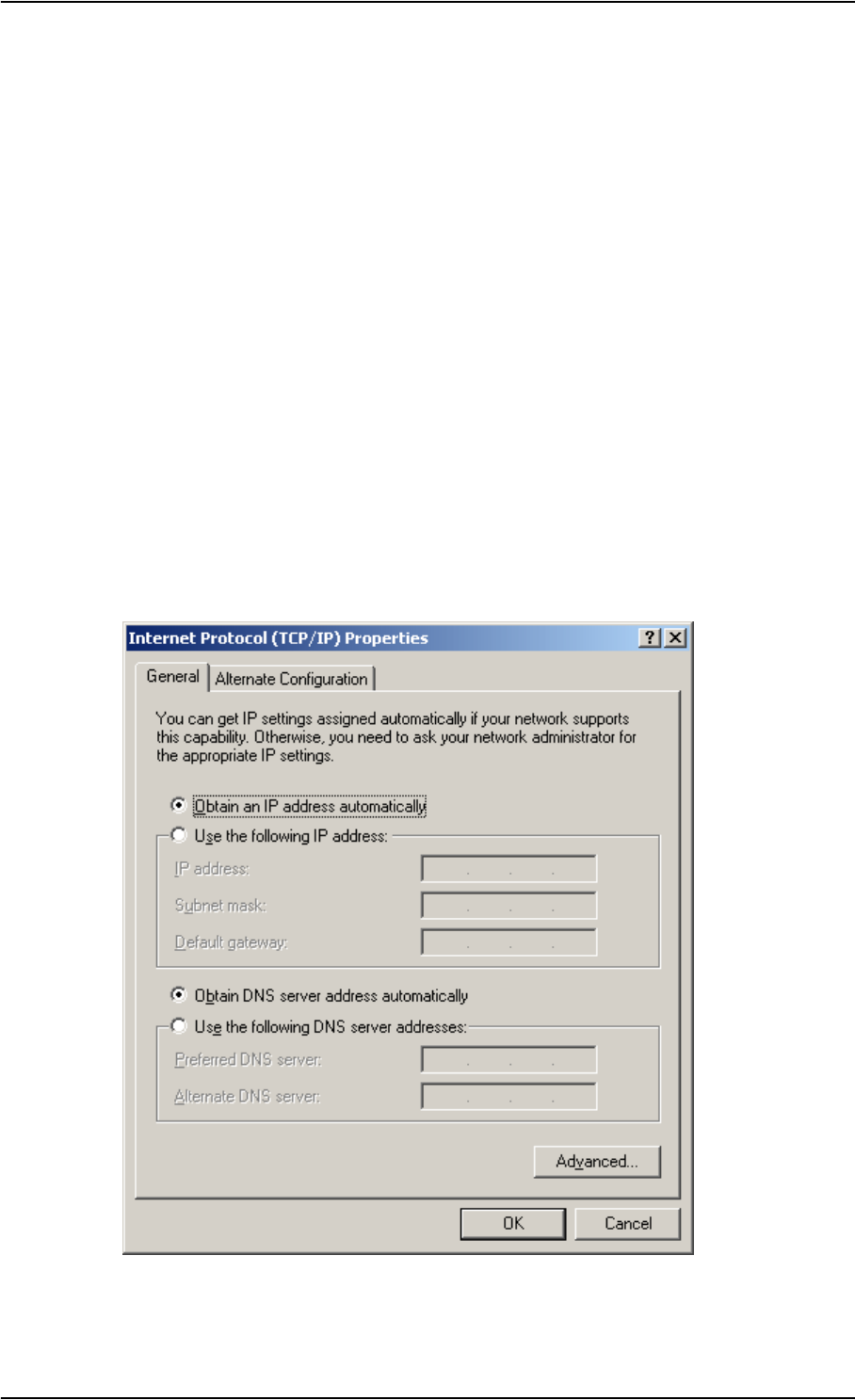
Chapter 4: Using the interfaces
TT 98-123571-DraftA Using a computer 61
Using the LAN interface
Before connecting to the LAN interface
To connect to the LAN (Local Area Network) interface, use a shielded cable mounted with an RJ-45
connector.
The LAN interface is configured as MDI-X. This means that you should use a straight cable.
For specifications, refer to LAN interface on page 132.
For the LAN interface to work without any further setup, the computer must be set up to obtain an
IP address and a DNS server address automatically.
To check these settings on your computer, do as follows (For Windows XP):
1. Select Connect To > Show All Connections from the Start menu.
2. Double-click Local Area Connection.
3. Click Properties
4. Select Internet Protocol (TCP/IP) from the list and click Properties.
Make sure both fields are set to obtain an address automatically.

Chapter 4: Using the interfaces
TT 98-123571-DraftA Using a computer 62
Connecting to the LAN interface
This section does not describe configuration of the LAN interface. For information on
configuration, see Configuring the LAN interface on page 90.
To connect to the LAN interface, do as follows:
1. Connect the LAN cable to the network interface of your computer.
A suitable cable is provided with your EXPLORER™ 300.
2. Connect the other end of the cable to the LAN
connector on the EXPLORER™ 300.
3. Power up the EXPLORER™ 300 and point the antenna as described in Pointing the antenna on
page 21.
After pointing, the connection is automatically established. By default, the connection is a
Standard data connection.
4. Check the connection, e.g. by starting your Internet Browser.
If connection fails, check that the interface is enabled in the EXPLORER™ 300. If the LAN icon is
not present in the display Main screen and in the Home window of the web interface, the interface
is disabled. See Enabling or disabling an interface on page 49.
If connection still fails, refer to the Troubleshooting Guide on page 120.

Chapter 4: Using the interfaces
TT 98-123571-DraftA Using a computer 63
Using a computer with Bluetooth
Before connecting a computer to the Bluetooth interface
The EXPLORER™ 300 supports various Bluetooth profiles. Remember to activate/install the
profile(s) you are going to use on your computer.
For a list of supported Bluetooth profiles, see Bluetooth interface on page 133.
The computer should be placed within a maximum distance of 25 m from the EXPLORER™ 300.
Note that this is the maximum distance in open air; the actual maximum distance may be shorter,
depending on the environment. In an office environment, you should be able to establish a
connection to the adjoining room.
If the two devices have not been connected before, you need to pair the devices. For further
information, see the section Bluetooth pairing on page 50.
Connecting a computer to the Bluetooth interface
This section does not describe configuration of the Bluetooth interface. For information on
configuration, see Configuring the Bluetooth interface on page 93.
If the devices are already paired, do as follows to connect:
1. Place the computer close to the EXPLORER™ 300.
2. Power up the EXPLORER™ 300 and point the antenna.
3. Power up your computer.
4. Turn on Bluetooth on your computer.
If the devices are paired, the Bluetooth connection should now be established.
Note that if your Bluetooth connection is defined as a dial-up connection, you have to open
the dial-up connection before you can access the Internet or the web interface. See Creating a
dial-up connection on page 64.
If connection fails, check that the interface is enabled in the EXPLORER™ 300.
If the Bluetooth icon is not present in the display Main screen and in the Home window of the web
interface, the interface is disabled. See Enabling or disabling an interface on page 49. If the
interface is enabled but connection fails, refer to the Troubleshooting Guide on page 121.
Note The procedure may vary depending on the Bluetooth interface in your computer. Consult
your Bluetooth manual for details.
Note Max. 2 devices, 1 voice and 1 data device, can be connected simultaneously.
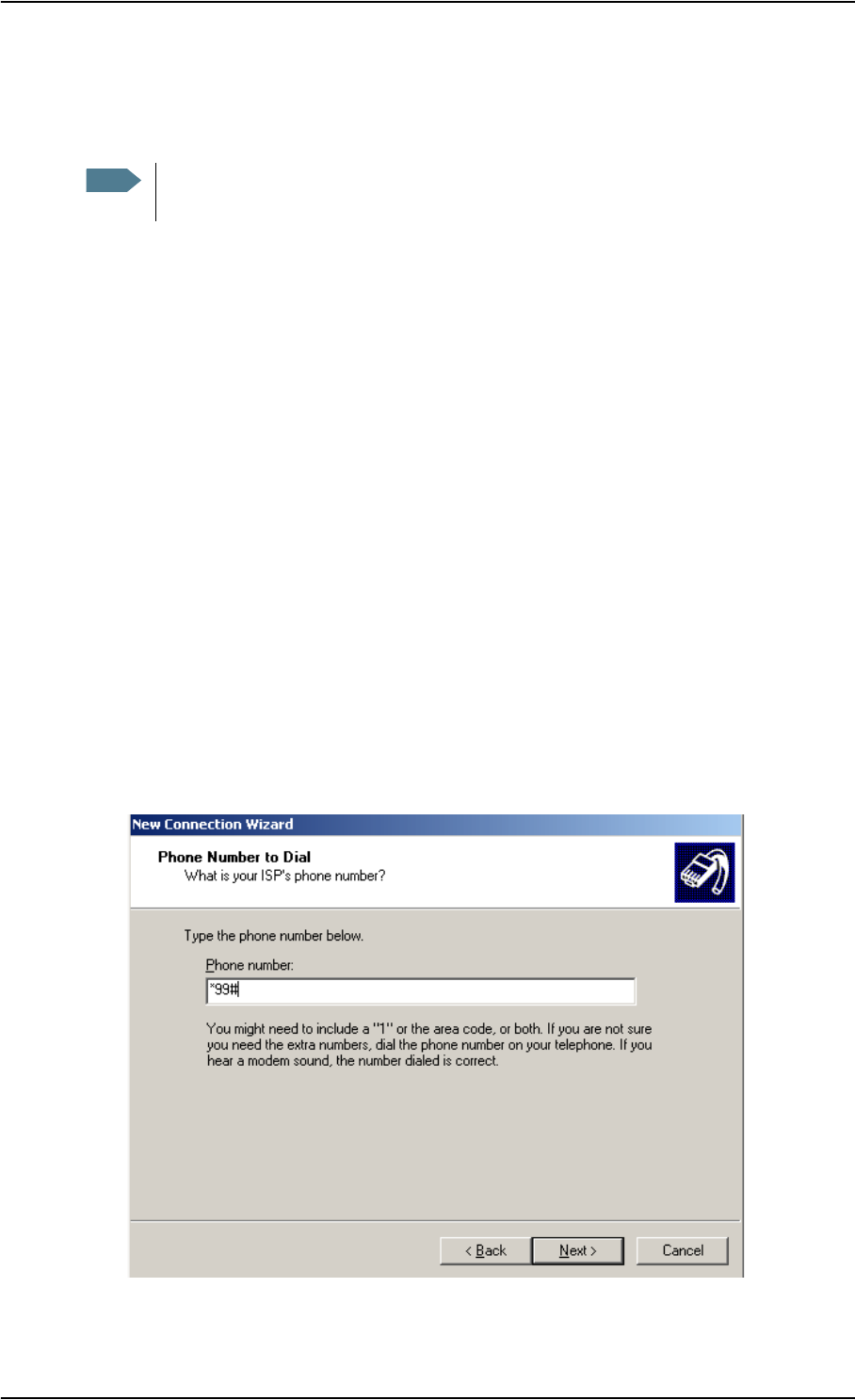
Chapter 4: Using the interfaces
TT 98-123571-DraftA Using a computer 64
Creating a dial-up connection
Do as follows:
1. Start up your computer and the EXPLORER™ 300.
2. Place your paired Bluetooth computer close to the EXPLORER™ 300. For information on
Bluetooth, see Using a computer with Bluetooth on page 63.
3. On your computer, select Connect To from the Start menu.
4. Select Show All Connections.
5. Open the New Connection Wizard and click Next.
6. Select Connect to the Internet and click Next.
7. S el ect Set up my connection manually and click Next.
8. Select Connect using a dial-up modem and click Next.
If other modems are installed, you must select the Bluetooth driver from a list of modems.
9. In the ISP Name field, type a name for your connection and click Next.
10. When you are asked for a phone number, type:
*98# if you want a Standard data connection to the Internet and/or the web interface, or *99#
if you are going to connect only to the web interface of the EXPLORER™ 300.
Note The following description is for Windows XP. If you are using a different operating
system, the procedure may be different.

Chapter 4: Using the interfaces
TT 98-123571-DraftA Using a computer 65
To dial up using a specific Profile, type *98*<CID>#.
To find the <CID> number, access the web interface, select SETTINGS > Interfaces > Bluetooth
and locate the Profile CIDs section at the bottom of the window.
For further information, see Configuring the Bluetooth interface on page 93.
11. Click Next twice.
12. Click Finish.
When you connect to the Bluetooth interface using dial-up, you must open this dial-up connection
to access the Internet or the web interface.
To open the dial-up connection (in Windows XP), select Connect To from the Start menu, select
your dial-up connection and click Dial. When the connection is established, you can access the
Internet as usual.

Chapter 4: Using the interfaces
TT 98-123571-DraftA Additional interfaces 66
Additional interfaces
Using the EXPLORER™ Bluetooth Handset charger
Before connecting to the EXPLORER™ Bluetooth Handset charger interface
If you are using an EXPLORER™ Bluetooth Handset, you can recharge the handset using the DC
charger interface of the EXPLORER™ 300.
Use the charger cable supplied with the EXPLORER™ Bluetooth Handset.
For specifications on the charger interface, see EXPLORER™ Bluetooth Handset charger interface
on page 135.
Connecting to the EXPLORER™ Bluetooth Handset charger interface
Do as follows:
1. Connect the EXPLORER™ 300 to power, either using the AC/DC adapter connected to a 100-
240 V AC electrical outlet, or the Car charger cable connected to the cigarette lighter
socket/12 V DC in a car.
2. Connect the Bluetooth charger cable to the charging
connector on the EXPLORER™ 300.
The charging connector is located at the back of the
EXPLORER™ 300, and is marked DC OUT. Make sure
the connector is oriented correctly in relation to the
coding of the plastic insert.
3. Connect the other end of the cable to your EXPLORER™ Bluetooth Handset.
If the EXPLORER™ 300 is connected to power, the battery of the Bluetooth Handset is now
recharged.
What’s next?
This chapter has described the basics of how to set up and use each interface.
The following chapter, Using the web interface, describes how to use the built-in web interface for
setting up and using the EXPLORER™ 300.
Note The Bluetooth handset charger cannot recharge the Bluetooth handset from the
EXPLORER™ 300 battery. The EXPLORER™ 300 must be connected to external
power.
Illustration showing
DC OUT connector

TT 98-123571-DraftA In this chapter 67
Chapter 5
Using the web interface 5
In this chapter
This chapter describes how to use the web interface to operate, set up and configure the
EXPLORER™ 300.
Initial configuration of interfaces is described in the chapter Using the interfaces on page 47.
Introduction
The web interface
What is the web interface?
The web interface is a built-in web server in the EXPLORER™ 300, used for operating, setting up
and configuring the EXPLORER™ 300.
You can access the web interface from a standard Internet browser.
Internet Explorer 6.0, Mozilla Firefox 1.0 and Apple Safari 2.0 have been tested successfully with
the web interface.
You may be able to use other browser versions as well.
Connecting
Connect your computer to the EXPLORER™ 300.
Make sure your computer is set up for the interface you are planning to use for connecting to the
EXPLORER™ 300. You can use LAN or Bluetooth. See Using the interfaces on page 47 for details.
To access the web interface, an Internet browser must be installed on the computer.
Important If you are going to use Bluetooth with Dial-up Networking to access only the web
interface and not the Internet, you must use a dial-up connection with the phone
number set to *99#. For further information, see Creating a dial-up connection on
page 64.
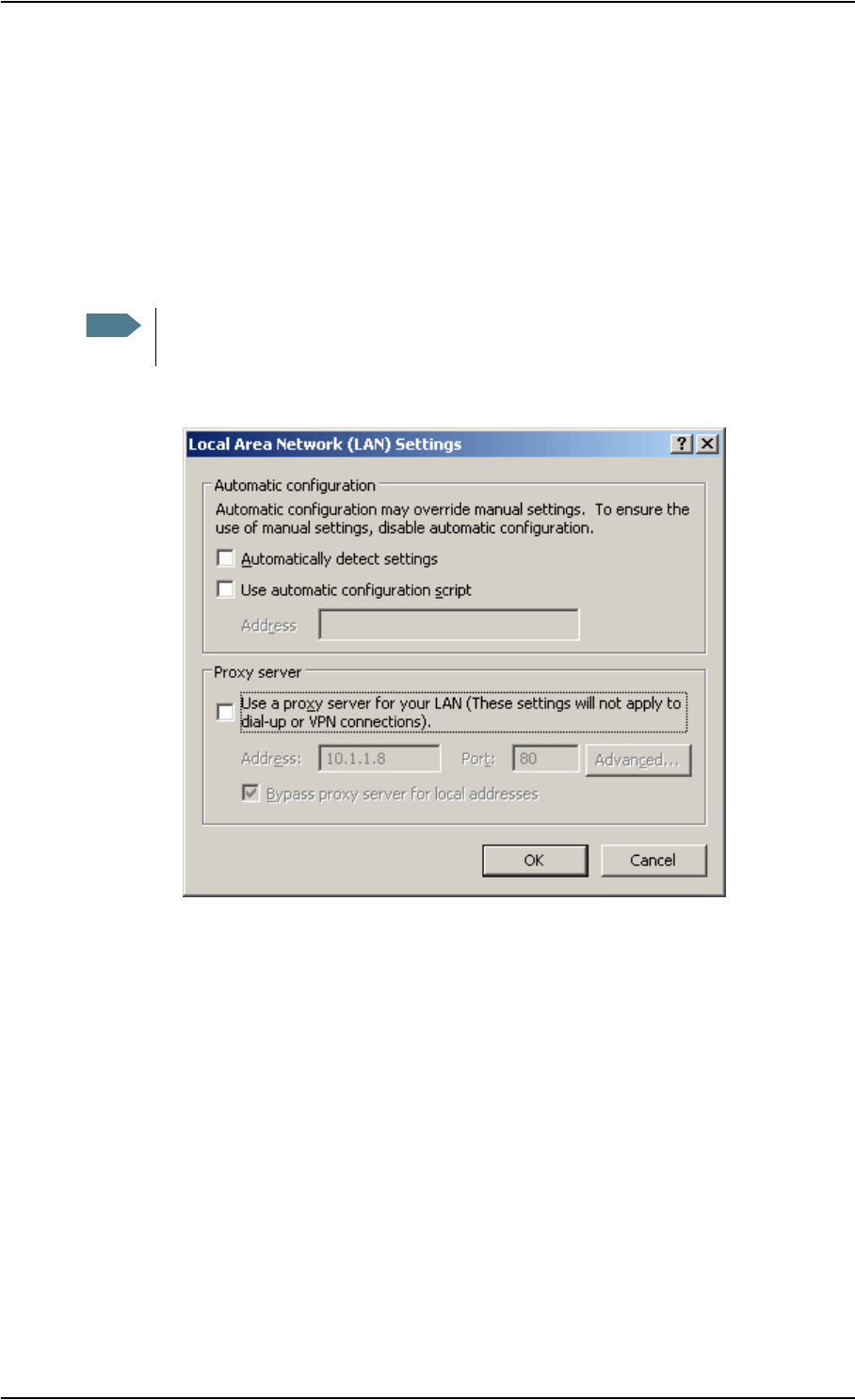
Chapter 5: Using the web interface
TT 98-123571-DraftA Introduction 68
Browser settings
If you are connecting your computer using the LAN interface, the Proxy server settings in your
browser must be disabled before accessing the web interface.
Most browsers support disabling of the Proxy server settings for one specific IP address, so you
can disable Proxy server settings for the web interface only, if you wish. Consult your browser help
for information.
To disable the use of a Proxy server completely, do as follows:
1. In Microsoft Internet Explorer, select Tools > Internet Options > Connections > LAN Settings.
2. Uncheck the box labeled Use a proxy server for your LAN.
3. Click OK.
When the proxy server settings are disabled, close your browser.
You may need to change this setting back on return to your Internet connection.
Note The following description is for Microsoft Internet Explorer. If you are using a different
browser, the procedure may be different.
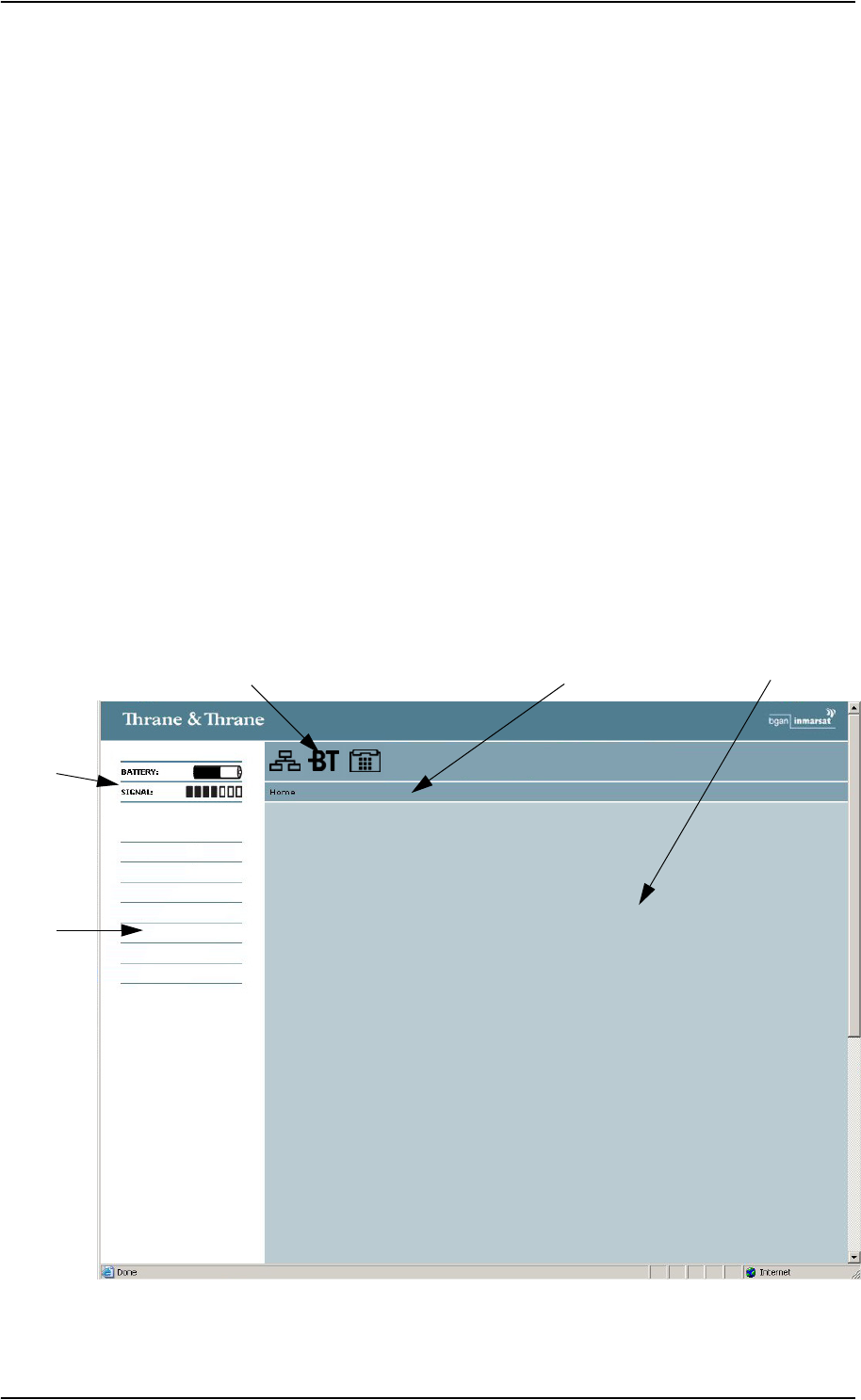
Chapter 5: Using the web interface
TT 98-123571-DraftA Introduction 69
Accessing and navigating the web interface
Accessing the web interface
To access the web interface from a connected computer, do as follows:
1. Connect your computer to the EXPLORER™ 300.
For further information, see Using a computer on page 59.
2. Start up the EXPLORER™ 300.
For further information, see Getting started on page 11.
3. Open your browser and enter the IP address of the EXPLORER™ 300.
The standard IP address is 192.168.0.1.
If your EXPLORER™ 300 uses a different IP address, you can look it up by entering the display
menu system of the EXPLORER™ 300 and selecting
PROPERTIES > IP ADDRESS.
Overview of the web interface
The web interface consists of the following sections.
Navigation
Status
Icon Bar Contents Section
Pane
Menu Path
Field
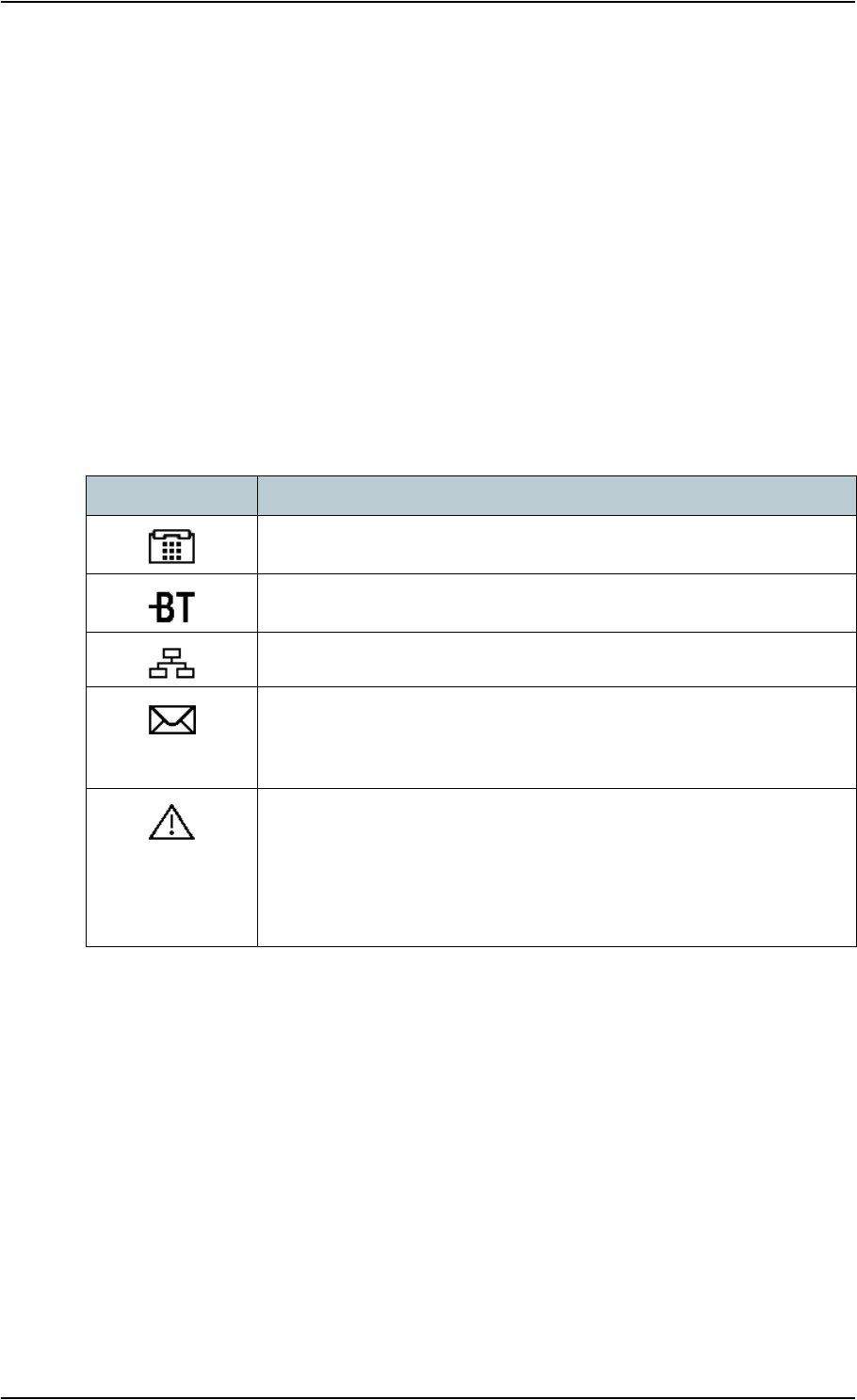
Chapter 5: Using the web interface
TT 98-123571-DraftA Introduction 70
•The navigation pane holds the main menu. Clicking an item in the menu opens a submenu in
the navigation pane or a new page in the contents section.
•The status field shows battery status and signal strength.
•The icon bar shows an icon for each interface that is enabled. It also shows icons for new SMS
messages and for active alarms, when relevant. For explanations of the icons, see the next
section, Icons in the icon bar.
•The menu path shows the path through the menu system to the current page shown in the
contents section.
•The contents section shows the page selected in the navigation pane. This section is used for
viewing or changing settings, or for performing actions.
Icons in the icon bar
The following icons may appear in the icon bar in the web interface:
Navigating the web interface
•To expand a menu, click the menu in the navigation pane.
•To access status and settings, click the relevant subject in the navigation pane, or an icon in
the icon bar. The status or settings are displayed in the contents section.
•To see the site map, click SITE MAP in the navigation pane. Click on items in the site map to
go directly to the relevant location.
•To return to the Home window from anywhere in the system, click Home, either from the
navigation pane or from the menu path below the icon bar.
Icon Explanation
Phone interface is on.
Bluetooth interface is on.
LAN interface is on.
A new SMS message, or information of Voice mail, has arrived.
Click the icon to see new messages or information of Voice mail. For
further information, see Receiving a message on page 81.
An alarm is pending.
Click the icon to see a list of active alarms. For explanations of the alarm
messages, see List of alarms on page 123.
Note that the alarm icon will remain in the icon bar as long as the cause
of the alarm is still present.
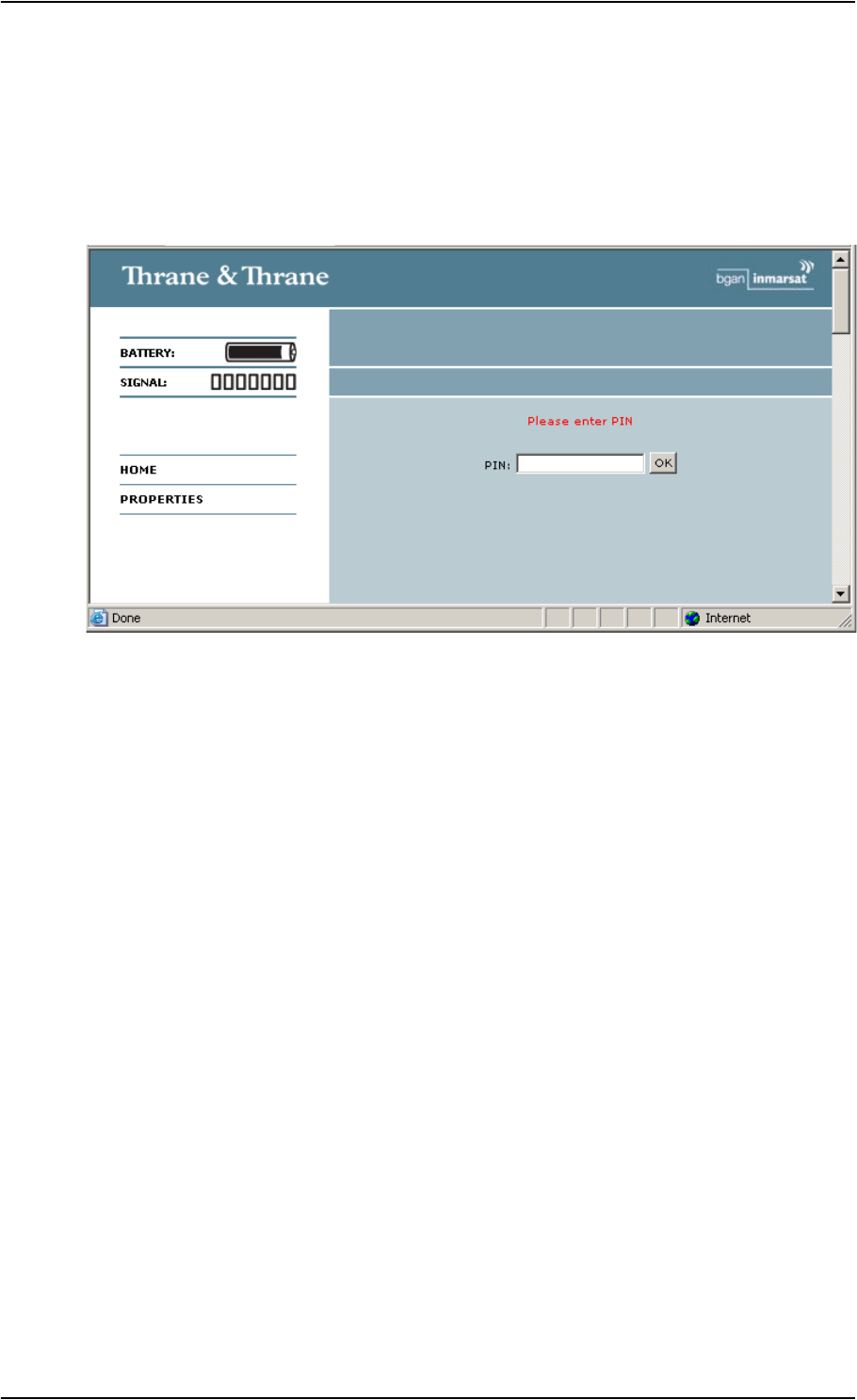
Chapter 5: Using the web interface
TT 98-123571-DraftA Introduction 71
Entering the SIM PIN in the web interface
If a computer is connected when you start up the EXPLORER™ 300, and the web interface is
accessed, you can enter the SIM PIN from the web interface.
Until you enter the PIN in the Home window, you can only access the PROPERTIES window and
upload software. Access to all other parts of the web interface requires a PIN.
Type in the PIN and press OK.
If you enter a wrong PIN 3 times you are asked for a PUK (PIN Unblocking Key). For further
information, see Wrong PIN on page 20.
If the PIN has already been accepted in the EXPLORER™ 300, or the PIN is disabled e.g. from the
BGAN LaunchPad, the web interface goes directly to the Home window at start-up.
When the PIN is accepted, the web interface opens the Home window and is ready for use.
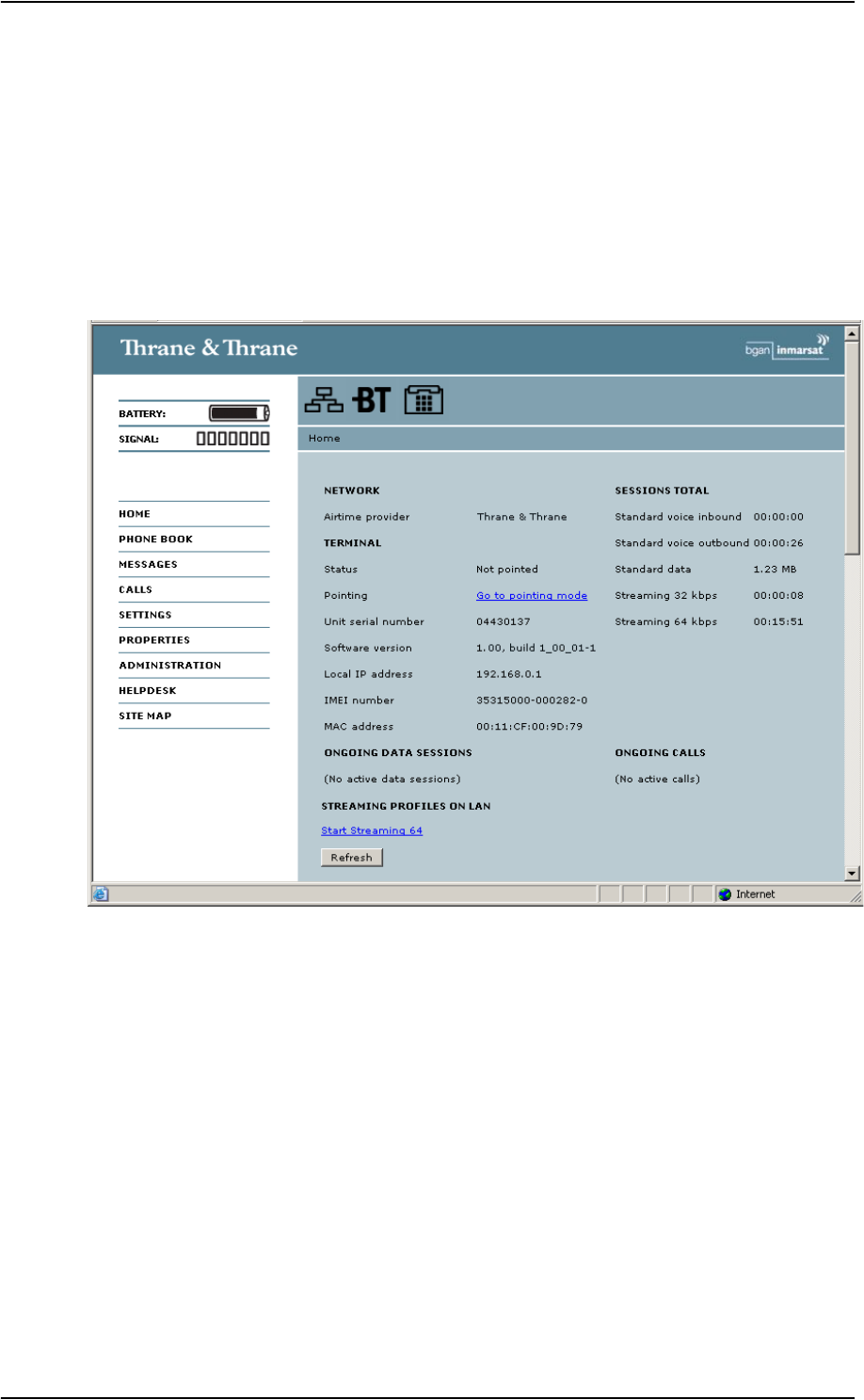
Chapter 5: Using the web interface
TT 98-123571-DraftA The Home window 72
The Home window
Overview
The Home window of the web interface contains a “dashboard” for control and inspection of
ongoing communication and for viewing properties of the EXPLORER™ 300.
The NETWORK section shows the name of the Airtime Provider, if this information is available on
the SIM card.
Terminal properties
The TERMINAL section of the Home window shows the following:
•Status. The status of the EXPLORER™ 300. This field corresponds largely, but not completely,
to the status information in the display.
Examples of status information are: Ready, Registering and Data active.
•Pointing. If you want to point the antenna, click the link Go to pointing mode. For further
information, see Pointing using web interface on page 74.
•Unit serial number. The serial number of the total unit.
•Software version. The version of the software embedded in the EXPLORER™ 300.
•Local IP address. The local IP address of the EXPLORER™ 300.

Chapter 5: Using the web interface
TT 98-123571-DraftA The Home window 73
•IMEI number. The IMEI number (International Mobile Equipment Identity) of the
EXPLORER™ 300. This is a unique number that identifies your EXPLORER™ 300. The IMEI
number is also printed on the serial number label at the back of the terminal.
•MAC address of the EXPLORER™ 300.
Managing calls and data sessions
Start/stop a Streaming session on the LAN interface
To start or stop a Streaming session, click the relevant link under STREAMING PROFILES ON LAN.
For information on setup of the LAN interface, see Configuring the LAN interface on page 90.
For information on how to set up a Profile, see Using Profiles on page 106.
Viewing information on calls and data sessions
The following sections in the Home window show information on calls and data sessions.
•ONGOING CALLS is a list of calls that are currently active. The list shows the Voice quality and
the time connected for each call.
•ONGOING DATA SESSIONS is a list of data Profiles that are currently active, including the IP
address that is assigned to each PDP context.
•SESSIONS TOTAL lists the totals for each connection. The list shows the time connected for
voice and Streaming data, and MB transferred for Standard data.
Note Before starting a Streaming session, make sure you have set up a Streaming Profile and
activated it in the SETTINGS > Interfaces > LAN window.

Chapter 5: Using the web interface
TT 98-123571-DraftA The Home window 74
Pointing using web interface
Instead of using the display for observing the signal strength you can view and accept the signal
strength in the web interface.
Do as follows:
1. From the TERMINAL section of the Home window in the web interface, click the link Go to
pointing mode. The Pointing window opens, and the EXPLORER™ 300 enters pointing mode.
2. Point the antenna as described in Pointing the antenna on page 21, while observing the signal
strength in the web interface.
3. When you have obtained the highest signal strength you can get, click Accept.
The web interface now returns to the Home window, and the EXPLORER™ 300 tries to establish a
connection and register on the BGAN network.
Note At this point the EXPLORER™ 300 may make a sound. This sound is used for
pointing the antenna. The frequency of the sound increases with the signal strength.
To toggle the pointing sound on/off, press S or Ton the keypad of the
EXPLORER™ 300.
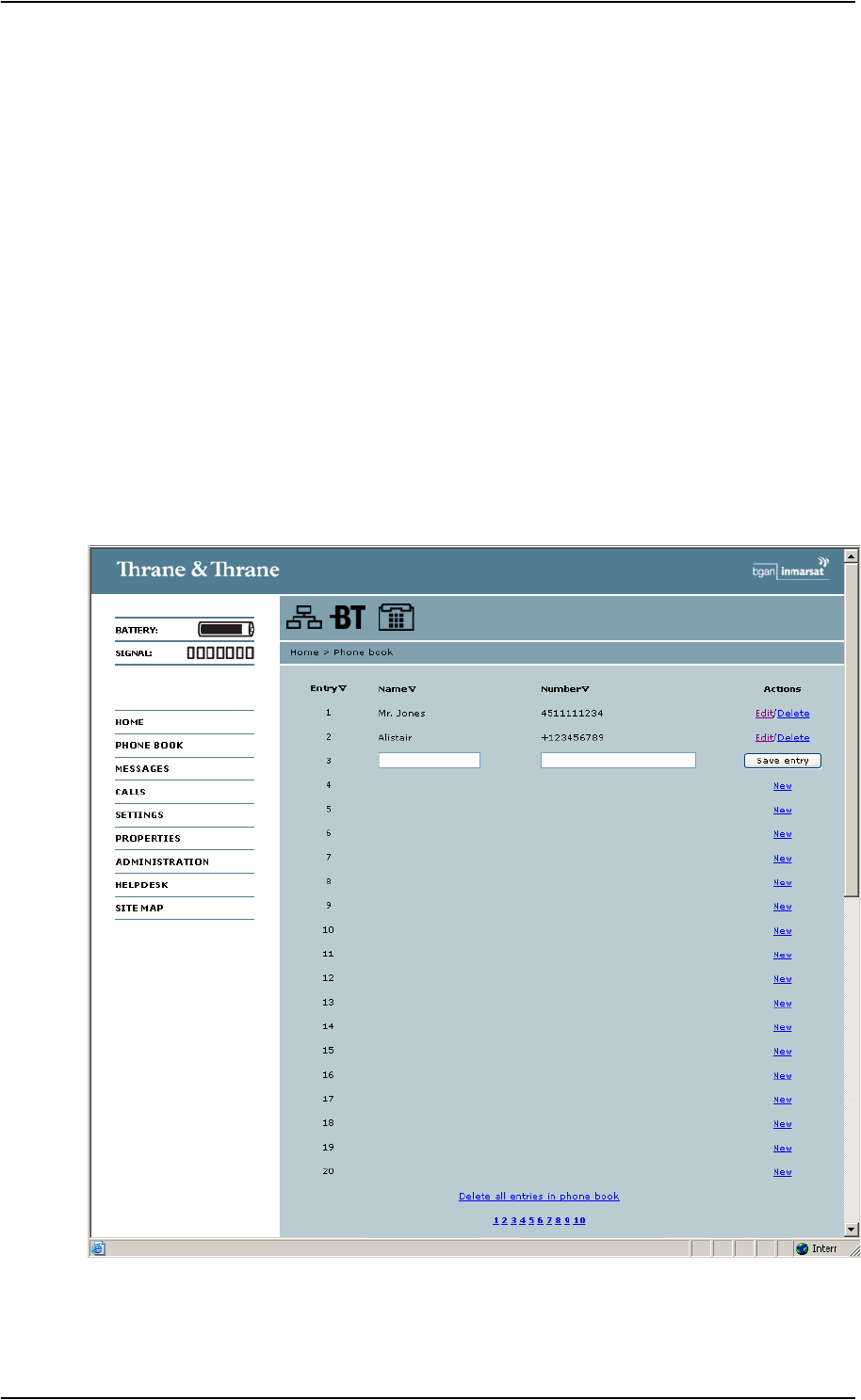
Chapter 5: Using the web interface
TT 98-123571-DraftA Using the phone book 75
Using the phone book
General usage
Overview
In the phone book you can:
• Look up phone numbers.
• Look up short dial numbers for easy dialing from an analog or Bluetooth handset.
• Modify or delete existing names and phone numbers, or enter new names and phone
numbers.
Accessing the phone book
To access the phone book, select PHONE BOOK from the left navigation pane.
The phone book shows all entries with entry number, name and phone number. Empty place
holders are also included.

Chapter 5: Using the web interface
TT 98-123571-DraftA Using the phone book 76
To sort the phone book, click the title of the column you wish to sort by. For example, to sort by the
names in the phone book alphabetically, click on Name in the top row of the phone book.
The phone book is divided into subpages. To select the subpages you want, click the relevant link
at the bottom of the page.
Short dial
The entry number in the phone book is the Short dial number. When making a call from the
EXPLORER™ 300 you can use this number instead of dialing the entire phone number.
Simply dial 0 <short dial> followed by # or off-hook key.
Example: To call the third entry in the phone book from an analog phone, take the phone off hook
and dial 03 #.
Editing phone book entries
Adding a new entry
To add a new entry, do as follows:
1. In the phone book, locate the empty entry number where you want to add the new phone
number and click New.
2. Type in the name and phone number of the new entry and click Save entry.
The new name and number are now listed at the specified entry number in the phone book.
Modifying an entry in the phone book
To modify an entry, do as follows:
1. In the phone book, click Edit next to the entry you want to modify.
2. Modify the name or number as wanted and click Save entry.
The name and/or number in the selected entry is now replaced with the new information.
Deleting an entry in the phone book
To delete an entry, click Delete next to the entry you want to delete.
Deleting all entries in the phone book
To delete all the entries in the phone book, click Delete all entries in phone book at the bottom of
the PHONE BOOK window.
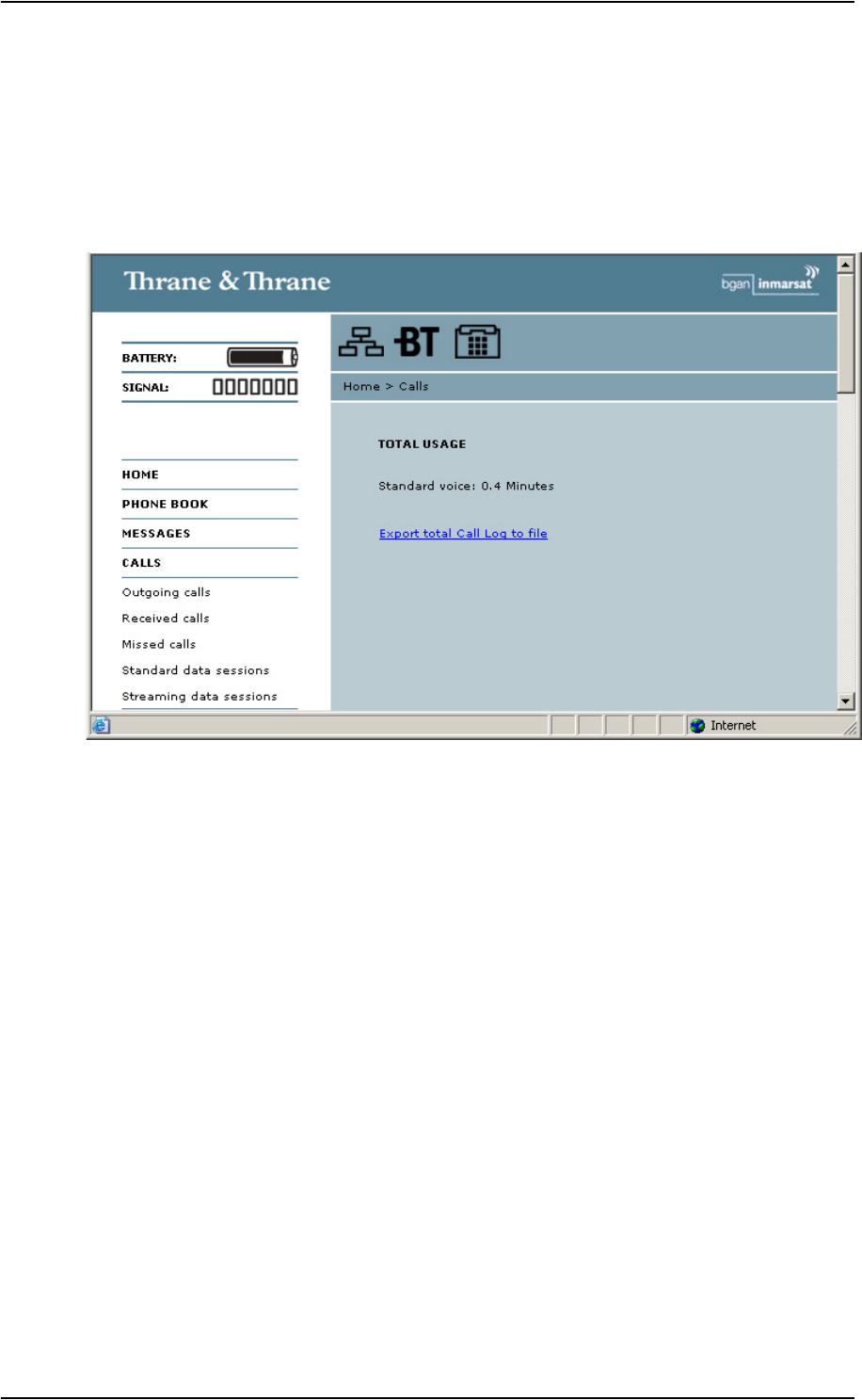
Chapter 5: Using the web interface
TT 98-123571-DraftA Call log 77
Call log
Information on total usage
To enter the CALLS window select CALLS from the left navigation pane. The CALLS window
contains information on time connected for circuit switched connections.
Exporting the call log
The EXPLORER™ 300 logs all calls and data sessions. For information on how to view the lists of
calls and data sessions, see the next section.
To export the entire call log to a file, do as follows:
1. In the CALLS window, click the link Export total Call Log to file.
2. Browse to the location where you want to save the log.
3. Click OK.

Chapter 5: Using the web interface
TT 98-123571-DraftA Call log 78
Viewing the lists of calls
To see information on outgoing, received or missed calls or data sessions, select one of the
following lists from the left navigation pane in the CALLS window:
•Outgoing calls shows the start time, receiving end phone number, duration, type and
estimated charge of each outgoing call.
•Received calls shows the start time, calling phone number, duration and type of each
incoming call.
•Missed calls shows the start time, calling phone number and type of each incoming call that
was not received.
•Standard data sessions shows the start time, bytes in, bytes out and estimated charge of each
Standard data session.
•Streaming data sessions shows the start time, duration, type (Streaming 32, 64 kbps) and
estimated charge of each Streaming data session.
Date and time is UTC time, received from the satellite.
You can sort each of the lists by clicking the title of the column you wish to sort by.
If a list covers more than one page, you can click the relevant link at the bottom of the page, to go
to another page.
When there are more than 100 calls in the total list, the oldest calls are automatically removed to
make room for new calls.
Note The estimated charge is based on your entries under ADMINISTRATION > Call charges.
Thrane & Thrane does not take responsibility for the correctness of this estimated
charge.
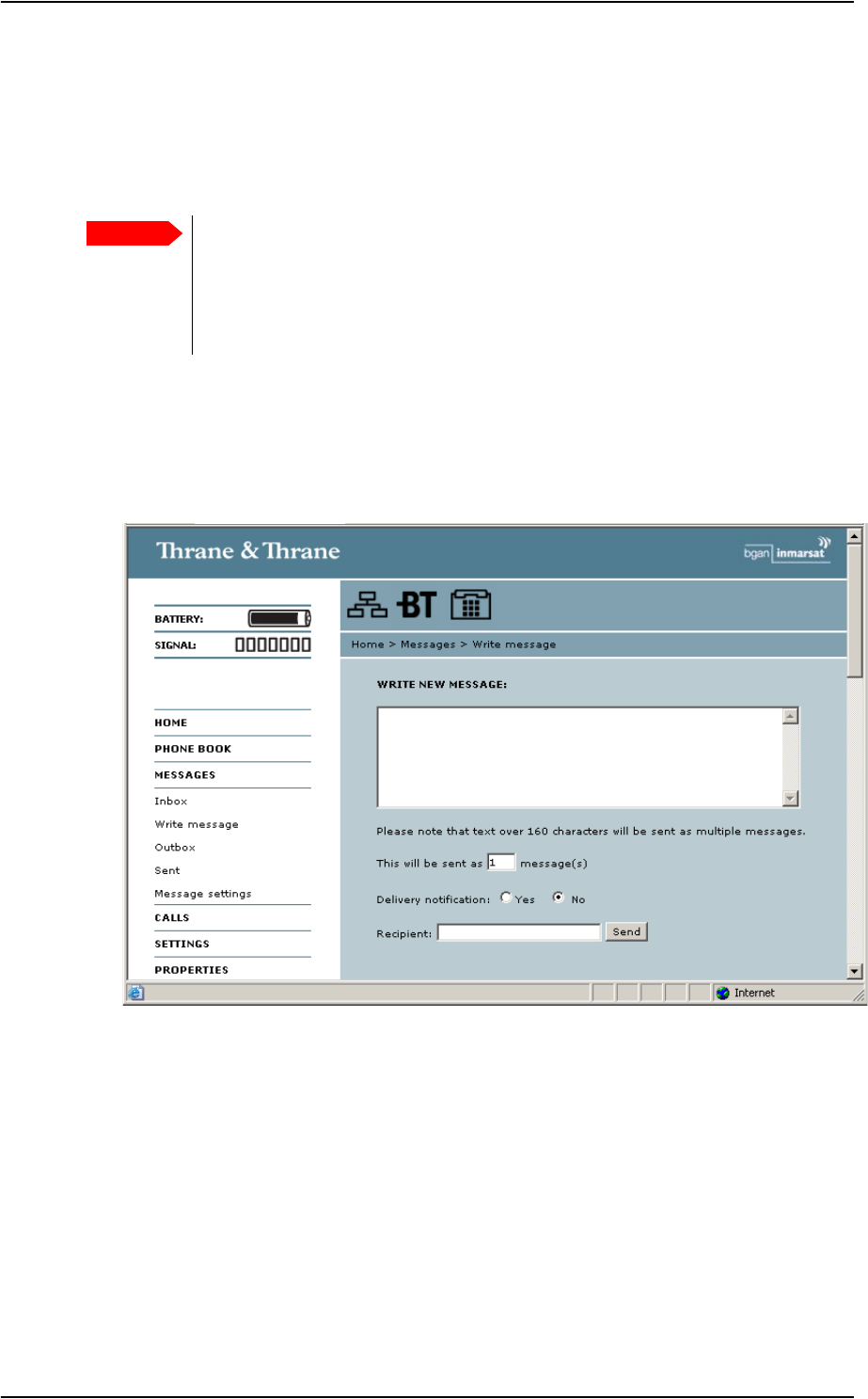
Chapter 5: Using the web interface
TT 98-123571-DraftA Handling messages 79
Handling messages
Sending an SMS message from the EXPLORER™ 300
To send an SMS message from the EXPLORER™ 300, do as follows:
1. Click MESSAGES from the left navigation pane.
This window contains new incoming messages.
2. In the left navigation pane, click Write message.
3. Type in the message in the WRITE NEW MESSAGE field.
If the message text is too long for one SMS, the message is sent as two or more SMS
messages. The field below the message field shows the number of SMS messages used to
send the message.
4. Type in the phone number in the Recipient field.
Remember 00 and country code
(e.g. 00 45 to call Denmark or 00 1 to call USA).
5. Select whether or not you want Delivery notification for this SMS message.
Important If the EXPLORER™ 300 is not online when you attempt to send a message, the
message is moved to the Outbox in stead of the Sent folder. Messages in the Outbox
are not automatically sent when the EXPLORER™ 300 goes online. For further
information on the Outbox, see the next section, Options for messages in the Outbox.
To make sure a message has been sent, check that it is in the Sent folder.

Chapter 5: Using the web interface
TT 98-123571-DraftA Handling messages 80
If you click Yes, the Status column in the Sent folder will show the status of your message
when it has been sent.
You can set up delivery notification generally for all SMS messages. This setting is used by
default when you send a message. For further information, see Configuring message settings
on page 83.
6. Click Send.
If the EXPLORER™ 300 is online, the message is now sent and moved to the Sent folder.
Options for messages in the Outbox
Messages in the Outbox are messages that have not been sent, e.g. because the EXPLORER™ 300
was not online when you attempted to send the messages.
To access the Outbox, click MESSAGES > Outbox from the navigation pane.
You have the following options for messages in the Outbox:
• When the EXPLORER™ 300 is online, click Resend next to the message you want to send.
When the Write message window opens, click Send.
The EXPLORER™ 300 now attempts to send the message again. To make sure the message
has been sent, look in the Sent folder.
• Click Delete next to a message to delete it.
• Click Delete all messages in Outbox to delete all the messages.
Options for messages in the Sent folder
The Sent folder contains SMS messages that have been sent.
To access the Sent folder, select MESSAGES > Sent from the navigation pane.
The Status column shows the status of each message, if you have selected Delivery notification
when sending the message.
From the Sent folder you have the following options:
• Click Resend next to a message you want to send again.
When the Write message window opens, click Send.
The EXPLORER™ 300 now attempts to send the message again. To make sure the message
has been sent, look in the Sent folder. There should now be two copies of the sent message.
• Click Forward next to a message you want to forward.
When the Write message window opens, type in the phone number of the new recipient and
click Send.
The EXPLORER™ 300 now attempts to send the message to the new recipient. To make sure
the message has been sent, look in the Sent folder.
• Click Delete next to a message to delete it.
• Click Delete all sent messages to delete all the messages.
Note The original message remains in the Outbox. When you have succeeded in sending
the message you may want to delete it from the Outbox.

Chapter 5: Using the web interface
TT 98-123571-DraftA Handling messages 81
Sending an SMS message to the EXPLORER™ 300
You can send an SMS message to the EXPLORER™ 300 e.g. from a mobile phone, using one of the
mobile subscriber numbers for voice. Dial
+870 <Mobile subscriber number>
To see the voice numbers of your EXPLORER™ 300, select PROPERTIES from the web interface or
from the display menu system and view Mobile subscriber numbers. Note, however, that these
numbers are only listed if they are available on the SIM card. Otherwise, refer to the information
included with your airtime subscription.
Receiving a message
If a message has arrived, the icon bar at the top of the web interface shows an unopened
envelope. Click the envelope to see the new message(s).
Otherwise, to see new messages, click MESSAGES from the left navigation pane.
The window shows new incoming messages.
If the message is not an SMS message but information of voice mail, call your voice mail service
number to hear the voice mail.
To find your voice mail service number, select MESSAGES > Message settings from the left
navigation pane and locate the Voice mail service number.
Note that the voice mail number is only shown if it is available on the SIM card. Otherwise, refer to
the information included with your Airtime subscription.
Note The EXPLORER™ 300 does not accept more than 100 incoming messages (including read
and unread messages). If you have received 100 messages, you have to delete some of
them in order to free space for new messages. Otherwise, the new messages are
rejected.

Chapter 5: Using the web interface
TT 98-123571-DraftA Handling messages 82
Options for new SMS messages
To see new messages, click MESSAGES from the left navigation pane.
Besides viewing the new messages, you have a number of options for what to do with each
message:
• Click Read to move it to your Inbox containing read messages.
• Click Reply to reply to a message.
Then type in your reply and click Send.
For information on how to include the original message in your reply, see Setting up the
default message options on page 83.
• Click Forward to forward a message to someone.
Then type in the phone number in the Recipient field and click Send.
• If you want to move all the new messages, click Move all new messages to Inbox.
Options for SMS messages in the Inbox
The messages in the Inbox are the incoming messages that have been read and moved from the
list of new messages (refer to the previous section).
From the Inbox, you have the following options:
• Click Reply to reply to a message.
Then type in your reply and click Send.
For information on how to include the original message in your reply, see Setting up the
default message options on page 83.
• Click Forward to forward a message to someone.
Then type in the phone number in the Recipient field and click Send.
• Click Delete to delete the message.
• Click Delete all messages in Inbox to delete all read messages in the Inbox.
Note New messages cannot be deleted until they have been moved to the Inbox.
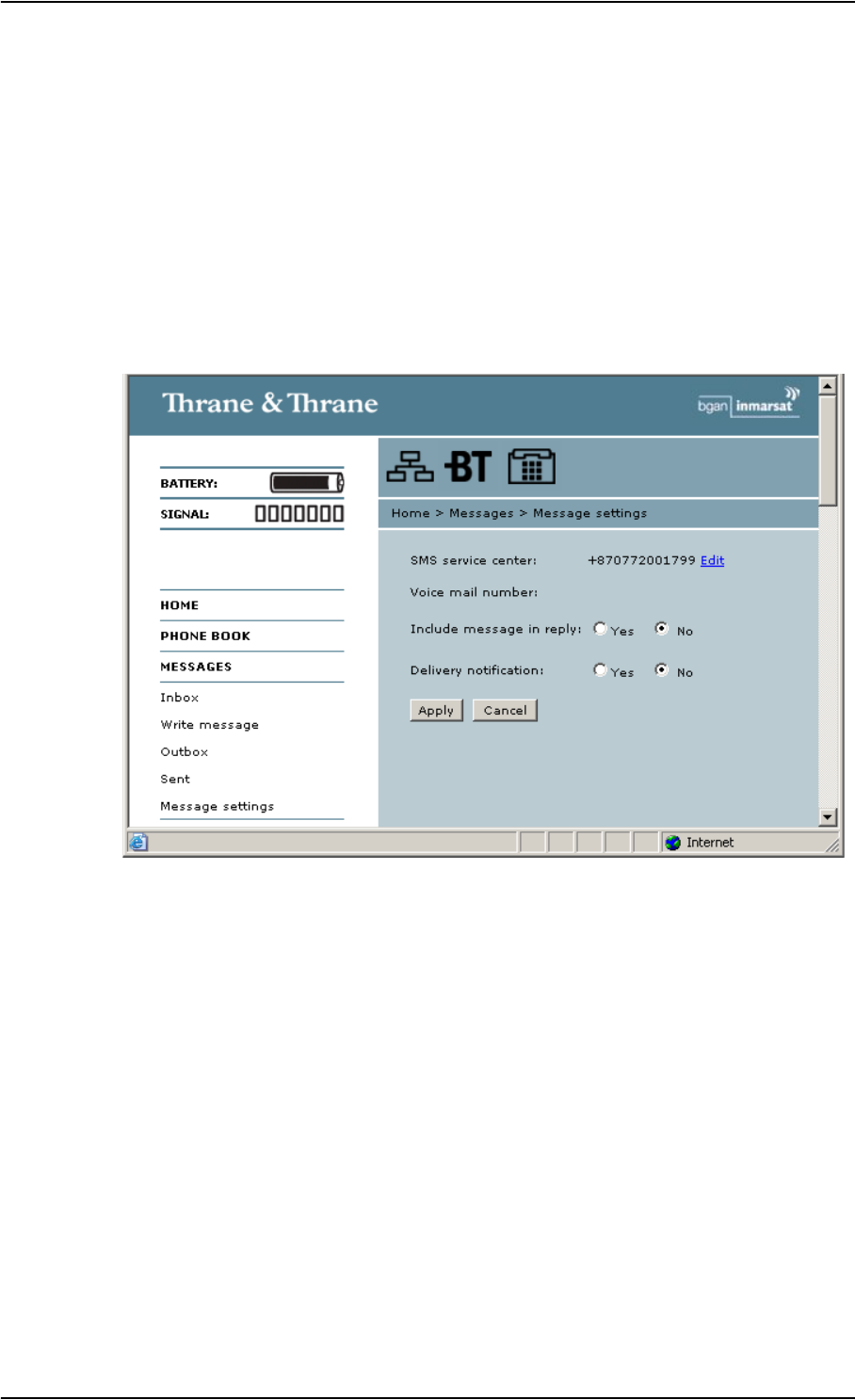
Chapter 5: Using the web interface
TT 98-123571-DraftA Handling messages 83
Configuring message settings
Setting up the default message options
You can set up general options for your outgoing messages. These settings apply by default to all
your outgoing messages. Note, however, that you can change the Delivery notification setting for
an individual message. For further information, see Sending an SMS message from the
EXPLORER™ 300 on page 79.
Do as follows:
1. Select MESSAGES > Message settings from the left navigation pane.
2. If you want to include the original message when you reply, select Yes next to Include
message in reply.
3. Select whether or not you want Delivery notification for SMS messages.
If you click Yes, the Status column in the Sent folder will show the status of your message
when it has been sent.
4. Click Apply.

Chapter 5: Using the web interface
TT 98-123571-DraftA Handling messages 84
Viewing or changing SMS service center number
The SMS service center number identifies the SMS service center used when sending and
receiving SMS messages. The SMS service center number is stored on the SIM card.
• To see the SMS service center number, select
MESSAGES > Message settings from the left navigation pane.
• To change the number, click Edit next to SMS service center, change the number and click
Save. Then click Apply to apply all changes in the window.
The SMS service center number is provided from your Airtime Provider.
Viewing the Voice mail number
The Voice mail number is the number you call to hear your incoming voice mails.
To see the Voice mail number, select
MESSAGES > Message settings from the left navigation pane.
Note The Voice mail number is only listed if it is available on the SIM card. Otherwise, refer to
the information included with your Airtime subscription.
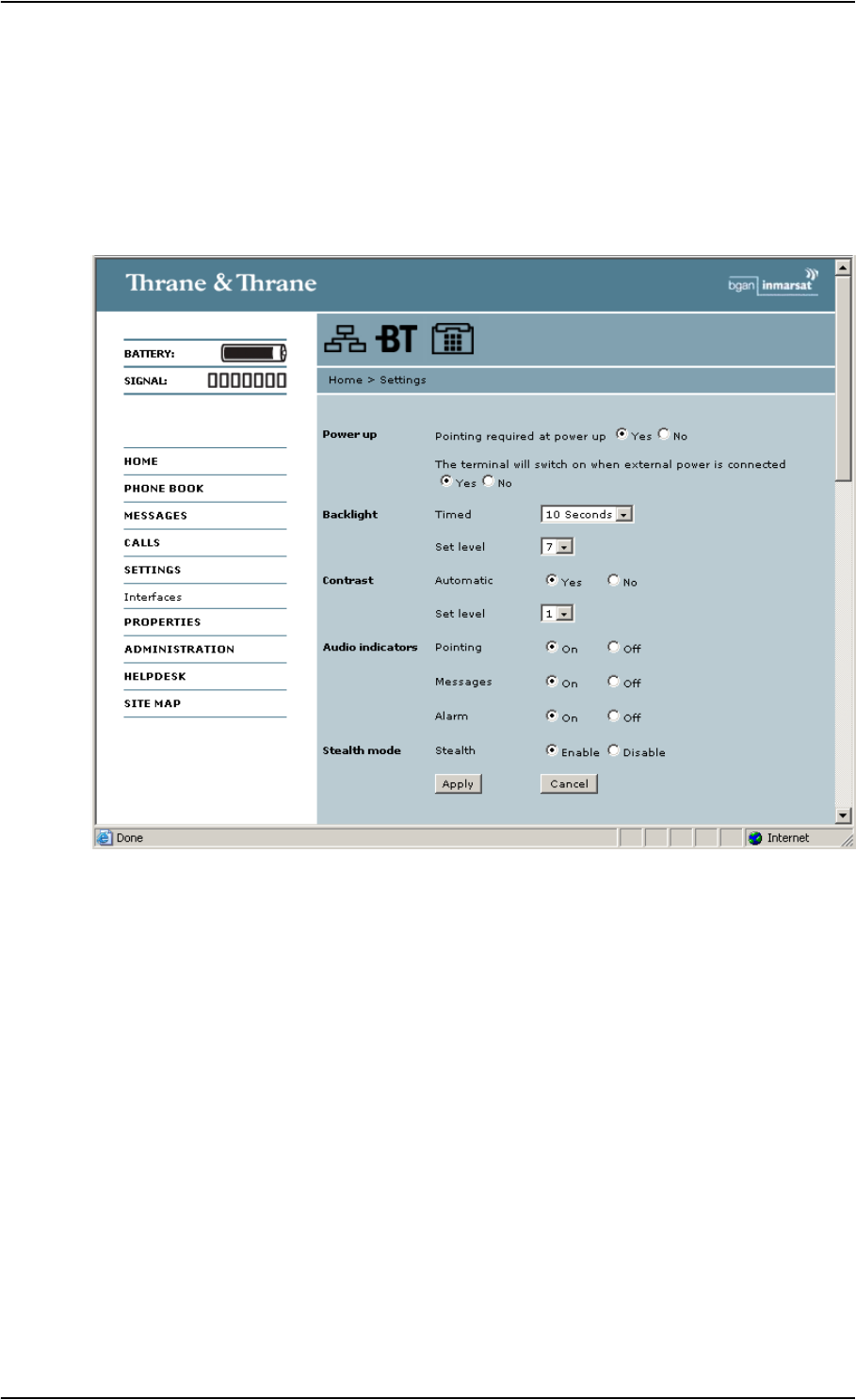
Chapter 5: Using the web interface
TT 98-123571-DraftA EXPLORER™ 300 settings 85
EXPLORER™ 300 settings
Accessing the EXPLORER™ 300 settings
Select SETTINGS from the left navigation pane. The SETTINGS window contains the local settings of
the EXPLORER™ 300. The next sections describe these settings.
Power up behavior
Pointing at power up
If the EXPLORER™ 300 is placed in a fixed position it may not be necessary to go through the
pointing process every time the EXPLORER™ 300 is powered. You can set up the EXPLORER™ 300
to automatically establish a connection to the BGAN network, if you know that the signal strength
is sufficient.
1. In the Power up section of the SETTINGS window, select whether or not pointing is required at
power up.
• To go through the pointing process every time the EXPLORER™ 300 is powered, select Yes.
• To have the EXPLORER™ 300 automatically register itself on the network every time the
EXPLORER™ 300 is powered, select No.

Chapter 5: Using the web interface
TT 98-123571-DraftA EXPLORER™ 300 settings 86
2. Click Apply.
If you have selected that pointing is not required at power up, the start up procedure will be as
follows:
1. Power up.
2. Enter the PIN. After the PIN is accepted, the EXPLORER™ 300 immediately tries to connect to
and register on the BGAN network.
Automatic power up
1. In the Power up section of the SETTINGS window, select whether or not the EXPLORER™ 300
should switch on automatically when external power is applied.
• To have the EXPLORER™ 300 switch on automatically when external power is applied,
select Yes.
• To have the EXPLORER™ 300 switch on only when the Power button is pressed, click No.
2. Click Apply.
Setting the display backlight and contrast
To set the display backlight and contrast, do as follows:
1. In the Backlight section of the SETTINGS window, set the timing.
The Timed period is the period of time the light will stay on after the last key is pressed.
2. Set the level of the backlight with the Set level scroll bar.
3. In the Contrast section, click Yes next to Automatic if you want the contrast to be adjusted
automatically according to the temperature.
The contrast of the display changes with the temperature. The EXPLORER™ 300 can
automatically adjust the contrast to compensate for these variations.
4. If you want to set the contrast manually, set the contrast level with the Set level scroll bar.
5. Click Apply.

Chapter 5: Using the web interface
TT 98-123571-DraftA EXPLORER™ 300 settings 87
Turning audio indicators on or off
The EXPLORER™ 300 has audio indicators for different events or situations.
To enable or disable these audio indicators, do as follows:
1. In the Audio indicators section of the SETTINGS window, turn the audio indicators on or off
using the radio buttons. Each audio indicator is explained below.
2. Click Apply.
The EXPLORER™ 300 has audio indicators for the following events:
•Pointing.
The Pointing sound is used during the pointing process. The frequency increases with the
signal strength, to help you find the maximum signal strength when pointing the antenna.
This setting is a default setting. When the EXPLORER™ 300 is in pointing mode, you can
toggle pointing sound on/off for the current pointing process using S or Ton the keypad of
the EXPLORER™ 300. However, the default setting applies at the next pointing process.
•Messages.
The Message indicator is a sound indicating that a message has arrived.
•Alarm.
The Alarm indicator is a sound indicating that an alarm is issued.
An alarm is issued if the EXPLORER™ 300 detects an error that requires your action.
Enabling activation of stealth mode
In Stealth mode, the EXPLORER™ 300 operates with no sounds nor lights. However, it is still
possible to operate the EXPLORER™ 300 and the display text is, in most cases, readable.
To enable the use of Stealth mode for the EXPLORER™ 300, do as follows:
1. Select SETTINGS from the left navigation pane.
2. In the Stealth mode section, click Enable.
If you click Disable, the Stealth mode function cannot be activated.
3. Click Apply.
Important Only enable activation of Stealth mode if you are going to use it. If Stealth mode is
activated by mistake, it may be difficult to operate the EXPLORER™ 300.
Note This setting does not activate Stealth mode, it only enables the use of Stealth mode.
To activate Stealth mode, press C+OK on the keypad.
To deactivate Stealth mode and return to normal function, press C+OK again.
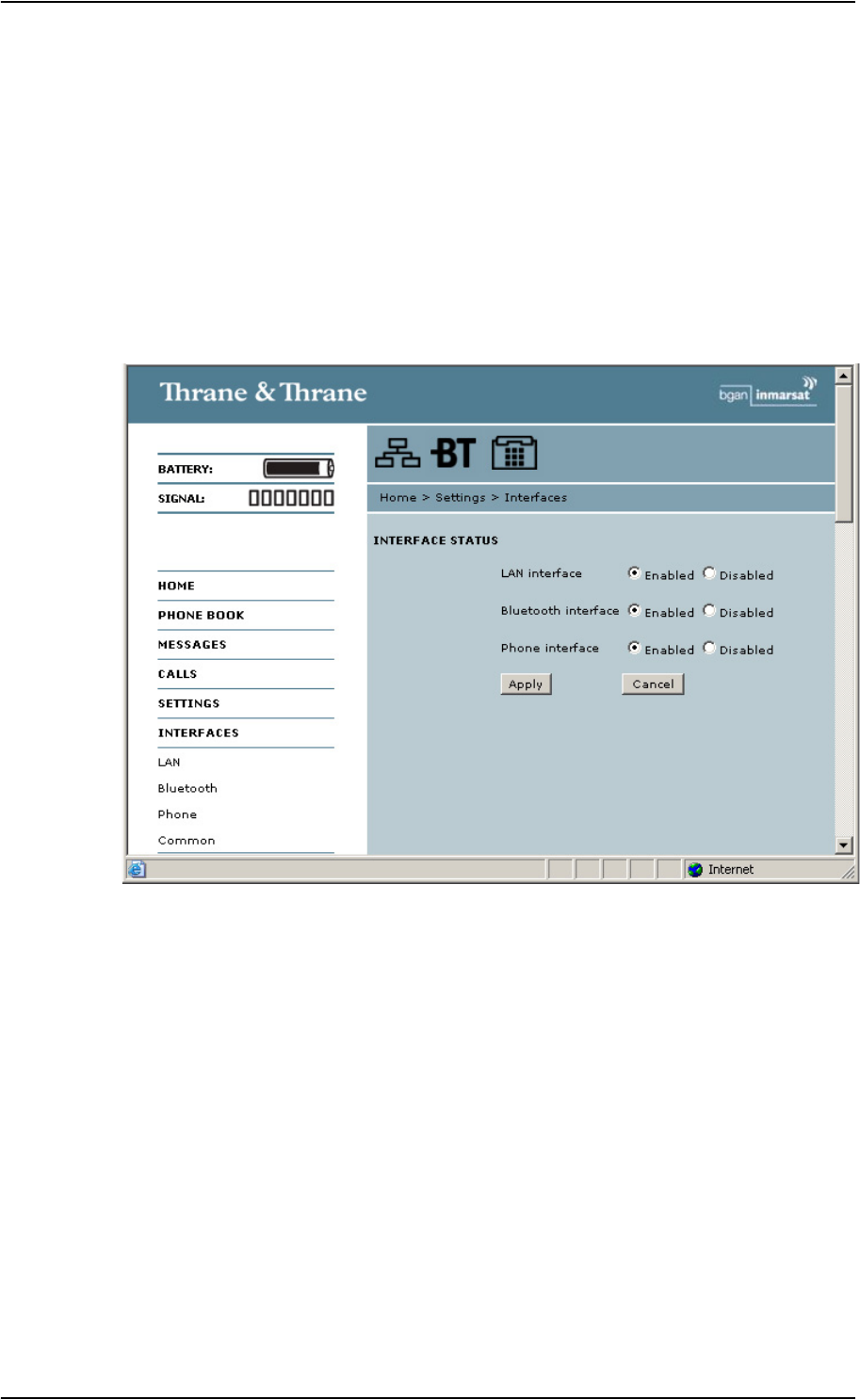
Chapter 5: Using the web interface
TT 98-123571-DraftA Setting up the interfaces 88
Setting up the interfaces
Enabling/disabling interfaces
By default, all interfaces are enabled. However, you can disable the LAN interface, the Bluetooth
interface and/or the Phone interface in order to minimize power consumption.
The icons in the Icon bar at the top of the web interface shows interfaces that are enabled. Clicking
an icon brings you to the window where you can set up the interface or enable/disable it.
1. Select SETTINGS > Interfaces from the left navigation pane.
2. In the Interfaces window, select Enabled or Disabled next to the interface you want to
enable/disable.
3. Click Apply.

Chapter 5: Using the web interface
TT 98-123571-DraftA Setting up the interfaces 89
Description of data settings
Introduction
There are several data parameters that can be set up in the web interface. This section gives an
overview of these parameters.
APN (Access Point Name)
The APN is used by the EXPLORER™ 300 user to establish the connection to the required
destination network. This means that the EXPLORER™ 300 must know the APN in order to be able
to connect to the destination network.
APNs are provided from the Airtime Provider. They may also be defined on the SIM card.
Header compression
The Header of a data packet contains control information belonging to that packet. The
information in the Header can take up a considerable amount of bandwidth. In order to save
bandwidth, you can use Header Compression, meaning you compress the header information,
leaving some of the information out.
You can select whether or not to use Header Compression for your data transmission.
•Header Compression enabled: Recommended for low-noise applications.
If you select Header Compression enabled, you will be using less bandwidth on header
information, leaving more bandwidth for the actual payload.
However, if the environment is noisy, the system will have to retransmit information, and you
may end up using more bandwidth than without Header Compression.
•Header Compression disabled: Recommended in noisy environments.
If Header Compression is disabled, the system will be less sensitive to noise.
Primary and secondary Profiles
A Profile is a collection of Quality of Service (QoS) settings and other settings defining the mode in
which data is transmitted on an interface. For example, a Profile is used to define whether a
connection should be a Standard or Streaming connection.
You can select between a number of predefined Profiles or define your own Profiles for your data
transmission.
In the EXPLORER™ 300, you need an Administrator password to define Profiles and Traffic Flow
Templates.
Note If you have selected more than one Profile (one primary and one or more secondary
Profiles) for an interface, you must define a Traffic Flow Template before you can
establish a valid connection.
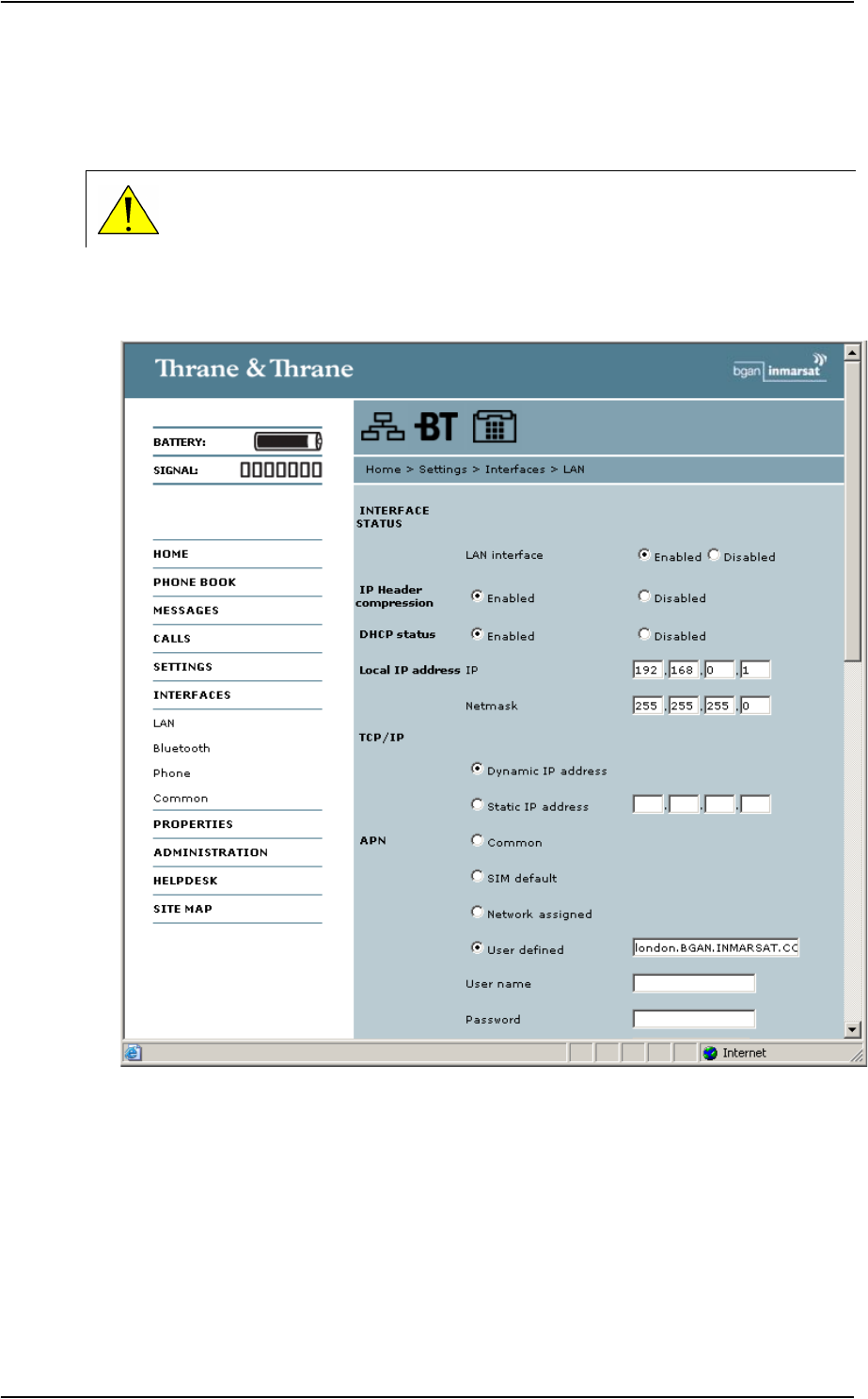
Chapter 5: Using the web interface
TT 98-123571-DraftA Setting up the interfaces 90
Configuring the LAN interface
For an explanation of each of the data settings, see Description of data settings on page 89.
To configure the LAN interface, do as follows:
1. Select SETTINGS > Interfaces > LAN.
2. Select whether the LAN interface should be Enabled or Disabled.
3. Under IP Header compression, select Enabled or Disabled. For information on this setting, see
Header compression on page 89.
4. Under DHCP status, enable or disable DHCP.
If you select Enabled, the internal DHCP server in the EXPLORER™ 300 is enabled.
CAUTION! If you are connected using LAN while changing the settings below, your
changes may affect your current connection.

Chapter 5: Using the web interface
TT 98-123571-DraftA Setting up the interfaces 91
5. Under Local IP address, type in the IP address and netmask for your EXPLORER™ 300.
This is the local IP address for your EXPLORER™ 300 when it is in Router mode.
6. Under TCP/IP, select whether your computer uses a Dynamic IP address or a Static IP address.
If you are using a static address, type in the address.
This is the IP address used externally on the satellite network.
To check this setting on your computer, see the TCP/IP properties of the LAN connection.
7. Select the source of the APN (Access Point Name).
There are four options for setting the APN. Unless you have special requirements, it is
recommended to use the SIM default, or to set the common APN to SIM default, and then
select Common here. You have the following options:
•Common. The APN is taken from the Common APN defined under
SETTINGS > Interfaces > Common. Refer to Setting a common APN on page 99.
•SIM default. The APN is taken from the SIM card.
•Network assigned. The APN is assigned from the network.
•User defined. Type in the APN. APNs are provided from the Airtime Provider.
8. If your APN uses a password, type in the user name and password provided from the Airtime
Provider.
9. Select the Primary Profile.
Select a Profile from the Primary scroll list. This Profile is used by the LAN interface as a first
choice, when possible.

Chapter 5: Using the web interface
TT 98-123571-DraftA Setting up the interfaces 92
There are 3 predefined Profiles: Standard, Streaming 32 kbps and Streaming 64 kbps.
Additionally, you can define your own custom Profiles.
For further information on Profiles and Traffic Flow Templates, see Using Profiles on page 106
and Using a Traffic Flow Template on page 109.
10. Select the Secondary Profile.
To select more than one secondary Profile, press and hold Ctrl or Shift while selecting.
The Context Identifiers (CIDs) for the selected primary and secondary Profiles are listed under
Profile CIDs.
11. Click Apply.
Your LAN settings are applied. Note that changes to your Profiles are not activated until you
click Activate.
12. Click Activate if you want to activate the changes to your Profiles.
Important If you have selected a Streaming connection as your Primary Profile, the LAN
interface will be running a Streaming connection until you select another
Profile or disconnect the interface. However, if you select one or more
Secondary Profiles, you can set up your Traffic Flow Template so that it will only
use the Streaming Profile for certain types of traffic.
Note If you have selected both a Primary and one or more Secondary Profiles you
must define a Traffic Flow Template before you can establish a valid
connection.
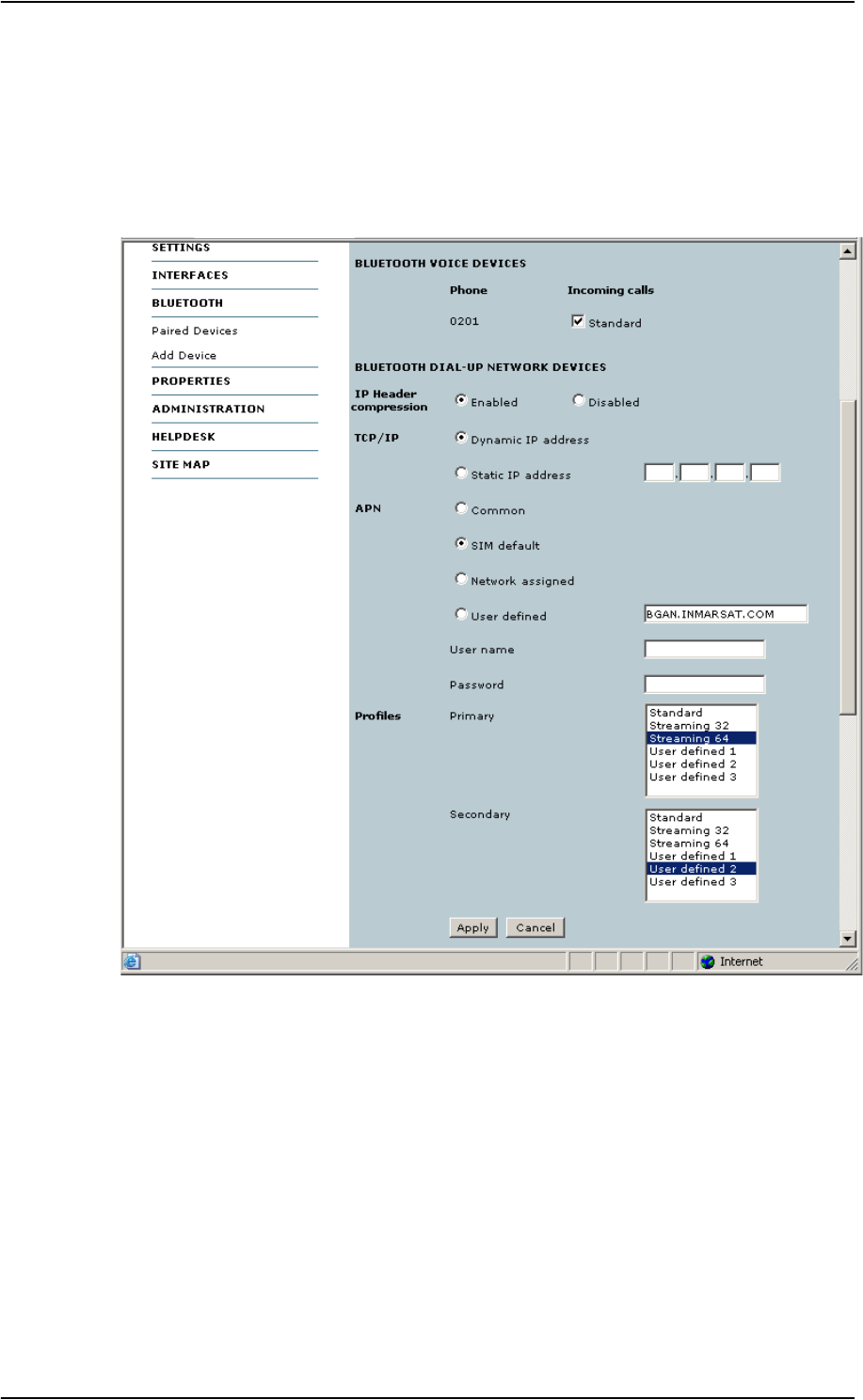
Chapter 5: Using the web interface
TT 98-123571-DraftA Setting up the interfaces 93
Configuring the Bluetooth interface
For an explanation of each of the data settings, see Description of data settings on page 89.
To configure the Bluetooth interface, do as follows:
1. Select SETTINGS > Interfaces > Bluetooth.
2. Under BLUETOOTH VOICE DEVICES, the voice devices paired with the EXPLORER™ 300 are
listed. For each voice device in the list, check Standard if you want to be able to receive calls
on that device.
Only calls with Standard call type are accepted.
3. Under DIAL-UP NETWORK DEVICES, the settings for paired data devices are listed. The next
steps describe the settings that are available.
4. Under IP Header compression, select Enabled or Disabled.
For information on Header Compression, see Header compression on page 89.

Chapter 5: Using the web interface
TT 98-123571-DraftA Setting up the interfaces 94
5. Under TCP/IP, select whether your computer uses a Dynamic IP address or a Static IP address.
If you are using a static address, type in the address.
This is the IP address used externally on the satellite network.
To check this setting on your computer, see the TCP/IP properties of the Bluetooth connection.
6. Under APN, select the source of the APN (Access Point Name).
There are four options for setting the APN. Unless you have special requirements, it is
recommended to use the SIM default, or to set the common APN to SIM default, and then
select Common here. You have the following options:
•Common. The APN is taken from the Common APN defined under
SETTINGS > Interfaces > Common. Refer to Setting a common APN on page 99.
•SIM default. The APN is taken from the SIM card.
•Network assigned. The APN is assigned from the network.
•User defined. Type in the APN. APNs are provided from the Airtime Provider.
7. If your APN uses a password, type in the user name and password provided from the Airtime
Provider.
8. Select the Primary Profile.
Select a Profile from the scroll list. This Profile is used by the Bluetooth interface as a first
choice, when possible.
There are 3 predefined Profiles: Standard, Streaming 32 kbps and Streaming 64 kbps.
Additionally, you can define your own custom Profiles.
For further information on Profiles and Traffic Flow Templates, see Using Profiles on page 106
and Using a Traffic Flow Template on page 109.
9. Select the Secondary Profile.
10. Click Apply.
Important If you have selected a Streaming connection as your Primary Profile, the
Bluetooth interface will be running a Streaming connection until you select
another Profile or turn off the interface. However, you can set up your Traffic
Flow Template so that it will only use this Profile for certain types of traffic.
Note If you have selected both a Primary and one or more Secondary Profiles you must
define a Traffic Flow Template before you can establish a valid connection.
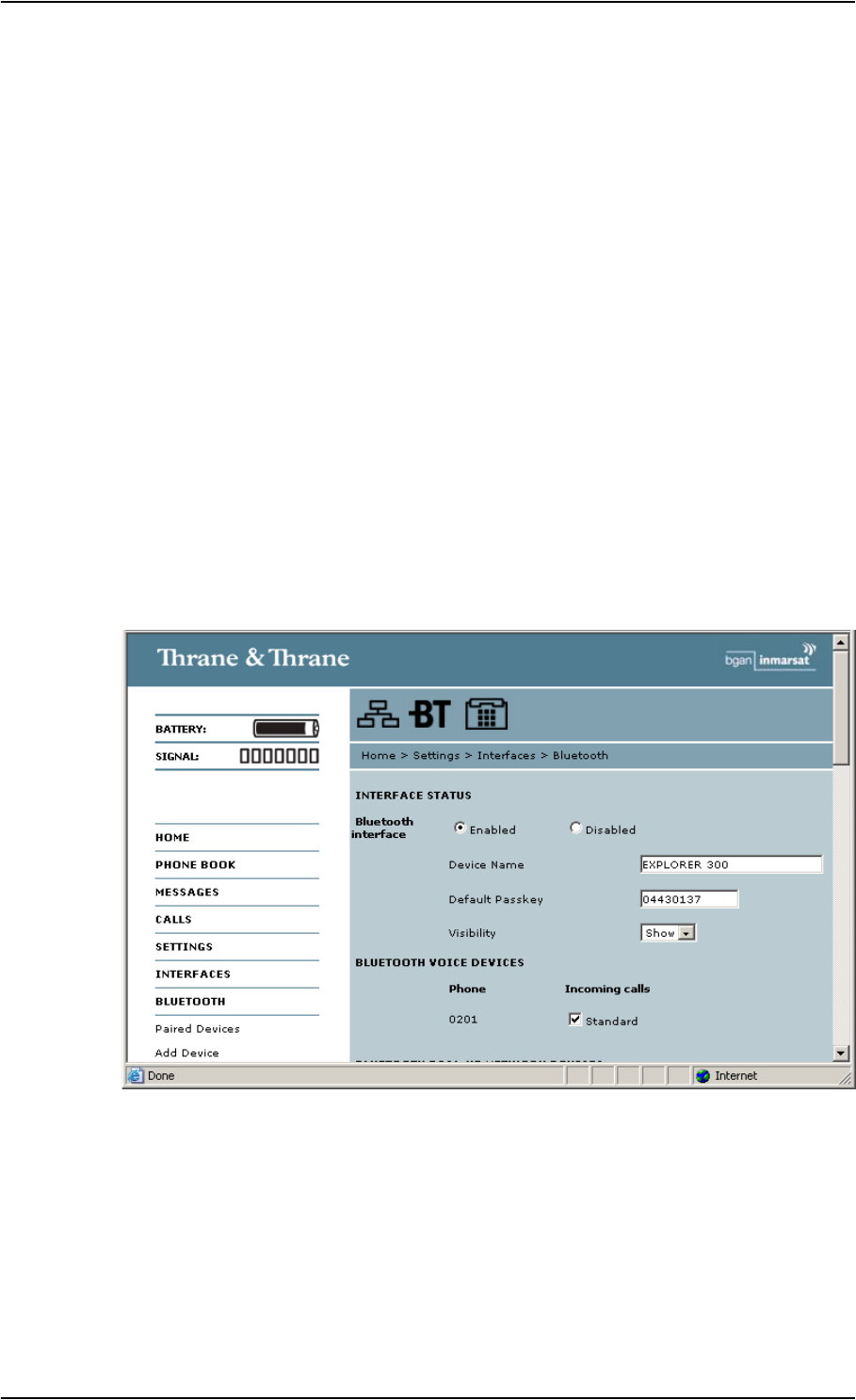
Chapter 5: Using the web interface
TT 98-123571-DraftA Setting up the interfaces 95
Pairing Bluetooth devices from the web interface
What is pairing?
Bluetooth Pairing happens when two Bluetooth enabled devices agree to communicate with one
another. When this happens, the two devices exchange passkeys and join a pair. The pairing
process only takes place the first time the two devices are connected. Once the two devices have
established a pair, they automatically accept communication when one device recognizes the
other device.
Preparing the EXPLORER™ 300 for Bluetooth pairing
To prepare the Bluetooth interface on the EXPLORER™ 300, do as follows:
1. Connect a computer to the EXPLORER™ 300, e.g. using the LAN interface.
2. Access the web interface from your connected computer.
Refer to The web interface on page 67.
3. In the web interface, select SETTINGS > Interfaces > Bluetooth and make sure that Bluetooth
is Enabled.
4. Use the predefined Device name or type in a new name for your EXPLORER™ 300.
The Device name is shown to other Bluetooth devices, if the EXPLORER™ 300 is configured to
be shown (refer to step 6. below).
5. Use the predefined Default passkey or type in a new one.
This passkey is used by default when pairing devices with the EXPLORER™ 300.
6. Next to Visibility, select Show or Hide.

Chapter 5: Using the web interface
TT 98-123571-DraftA Setting up the interfaces 96
• If you select Show, the device name of the EXPLORER™ 300 is shown to other Bluetooth
devices that are searching for devices.
• If you select Hide, other Bluetooth devices will not see the EXPLORER™ 300.
7. Click Apply at the bottom of the window.
Pairing from your Bluetooth device
For information on how to pair devices from your Bluetooth device, see Pairing devices in which
you can enter a passkey on page 50.
Pairing devices with a fixed passkey
Some Bluetooth devices, such as headsets, do not provide the possibility to enter a passkey for
connecting to another device. These devices have a fixed passkey which must be entered on the
other device. This section describes how to pair such devices with the EXPLORER™ 300.
Do as follows to pair the devices:
1. Connect a computer to the EXPLORER™ 300, e.g. using the LAN interface.
2. Start up the EXPLORER™ 300.
Refer to Getting started on page 11.
3. Turn on Bluetooth on your Bluetooth device and place it close to the EXPLORER™ 300.
4. Access the web interface from your connected computer.
For further information, see The web interface on page 67.
5. Select SETTINGS > Interfaces > Bluetooth and make sure that Bluetooth is Enabled.
6. From the left menu of the Bluetooth window, select Add device.
Note that you can pair maximum 2 devices. If you have already paired 2 devices, you have to
unpair a device before you can pair a new one. For information on how to unpair devices, see
Unpairing devices on page 97.
7. Click Search.
The EXPLORER™ 300 now searches for Bluetooth devices.
8. Click Update.
9. When the device you want to pair appears in the list, click Pair next to the device.
10. Enter the passkey of your Bluetooth device.
Note The method for pairing devices may vary depending on your Bluetooth device. Consult
your Bluetooth device documentation for information.
Note The search procedure can take up to 2-3 minutes. The list is not updated
dynamically. Click Update to see new found devices.

Chapter 5: Using the web interface
TT 98-123571-DraftA Setting up the interfaces 97
The default passkey for a Bluetooth headset is often 0000. Otherwise, refer to the manual for
your Bluetooth device.
11. When you are prompted from the Bluetooth device, usually by a tone, press the button on the
device to accept pairing.
The new device should now be paired with the EXPLORER™ 300 and added to the list of Paired
devices. This list is accessed from the left menu of the Bluetooth window in the web interface.
As long as the Bluetooth device is in the list of Paired devices, you can always reconnect the
device to the EXPLORER™ 300 without further setup.
Viewing paired devices
To see a list of devices that are paired with the EXPLORER™ 300, do as follows:
1. Access the web interface.
Refer to The web interface on page 67.
2. Select SETTINGS > Interfaces > Bluetooth > Paired devices.
The list shows devices that are paired with the EXPLORER™ 300. You can see the name, Class of
Device, status (whether or not a device is currently connected) and local phone number.
You can also see paired devices in the display. Select PROPERTIES > BLUETOOTH
DEVICES in the display menu system to see a list of all paired devices.
Unpairing devices
To remove a device from the list of Paired devices, do as follows:
1. Access the web interface and select
SETTINGS > Interfaces > Bluetooth > Paired devices.
2. In the Paired devices list, click Unpair next to the device you want to remove.
When the device is removed from the list, you have to pair it with the EXPLORER™ 300 again to
make a connection.
Note If you need to unpair an EXPLORER™ Bluetooth Handset, make sure the handset is
connected to the EXPLORER™ 300 while you unpair it.
If you select Unpair while the handset is not connected, it will automatically be
paired again when it approaches the EXPLORER™ 300.
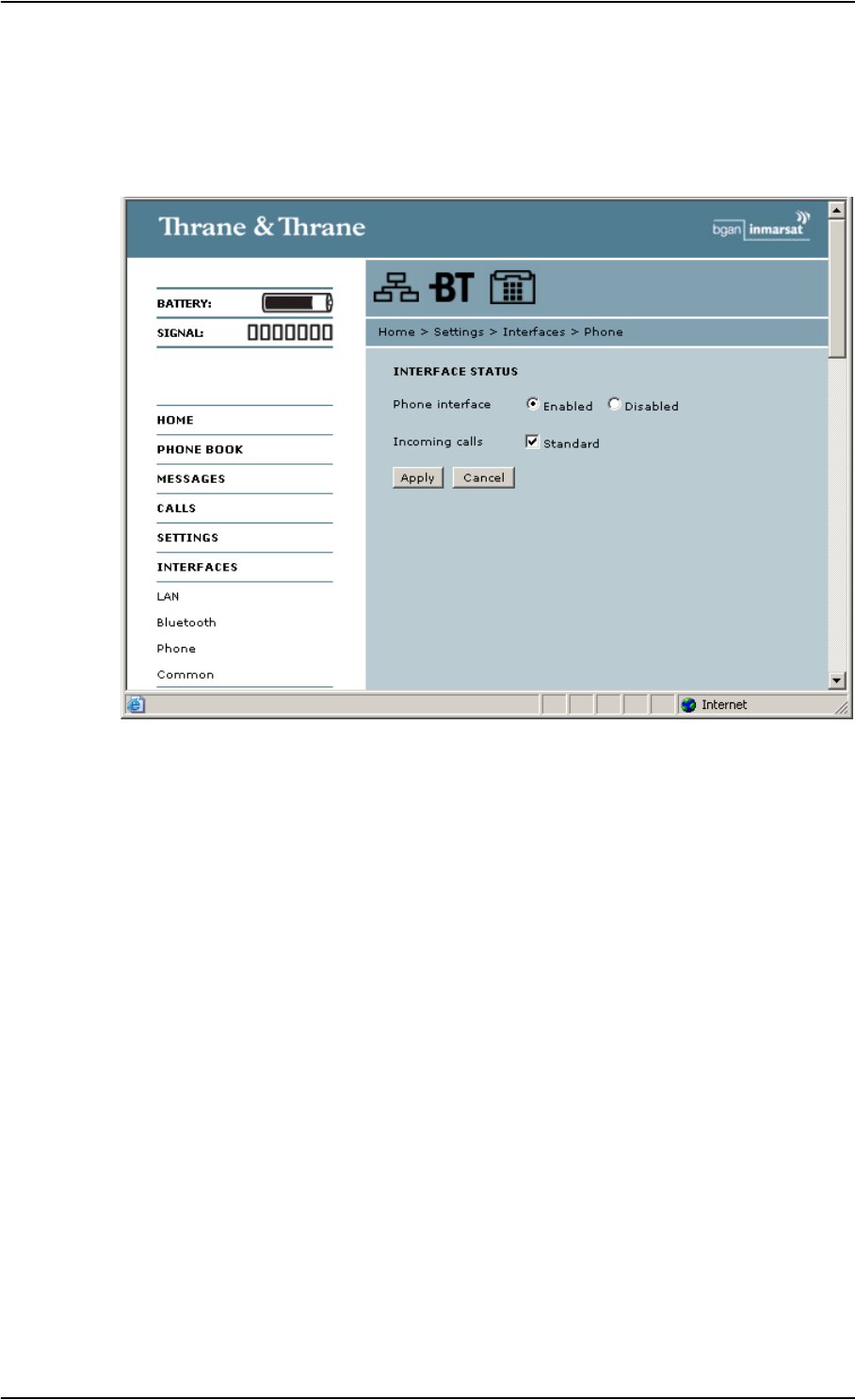
Chapter 5: Using the web interface
TT 98-123571-DraftA Setting up the interfaces 98
Configuring the Phone interface
Do as follows:
1. Select SETTINGS > Interfaces > Phone from the left navigation pane.
2. Select Enabled or Disabled to enable/disable the Phone interface.
3. Check Standard if you want to be able to receive calls through the Phone interface.
Only calls with Standard call type are accepted.
4. Click Apply.

Chapter 5: Using the web interface
TT 98-123571-DraftA Setting up the interfaces 99
Setting a common APN
Setting the common APN
The common APN setting is defined here and can be selected for each interface. If you are using
the same APN for the Bluetooth and LAN interfaces, it is easier to define it once, and then simply
select it for the relevant interfaces. Also, if you change the common APN at a later stage, it is
automatically updated for all interfaces where the Common setting is selected.
To set a common APN, do as follows:
1. Select SETTINGS > Interfaces > Common.
2. Select the APN. You have the following options:
•SIM default. The APN is taken from the SIM card. This is the recommended option, unless
you have special requirements.
•Network assigned. The APN is assigned from the network.
•User defined. Type in the APN. APNs are provided from the Airtime Provider.
3. If your APN uses a password, type in the user name and password provided from the Airtime
Provider.
4. Click Apply.
How to use the common APN
When you configure your individual interface, select Common to use the setting from this window.
Where Common is selected in the individual interface settings, the setting will automatically be
updated when the Common APN is changed.

Chapter 5: Using the web interface
TT 98-123571-DraftA Properties, software upload and alarm list 100
Properties, software upload and alarm list
Viewing the properties of the EXPLORER™ 300
To view the properties of the EXPLORER™ 300, select PROPERTIES from the left menu.
The PROPERTIES window shows:
•Local IP address. The local IP address of the EXPLORER™ 300.
•IMEI number. The IMEI number (International Mobile Equipment Identity) of the
EXPLORER™ 300. This is a unique number that identifies your EXPLORER™ 300. The IMEI
number is also printed on the serial number label at the back of the terminal.
•SMS service center. A number used to identify the SMS service center used by your
EXPLORER™ 300 to send and receive SMS messages.
•Mobile subscriber numbers (if available on SIM card). The numbers to use when calling the
EXPLORER™ 300.
•Software version. The version of the software embedded in the EXPLORER™ 300.
•Unit serial number. The serial number of the total unit.
•PCB numbers. The numbers of the PCBs in the EXPLORER™ 300.
•MAC address of the EXPLORER™ 300.
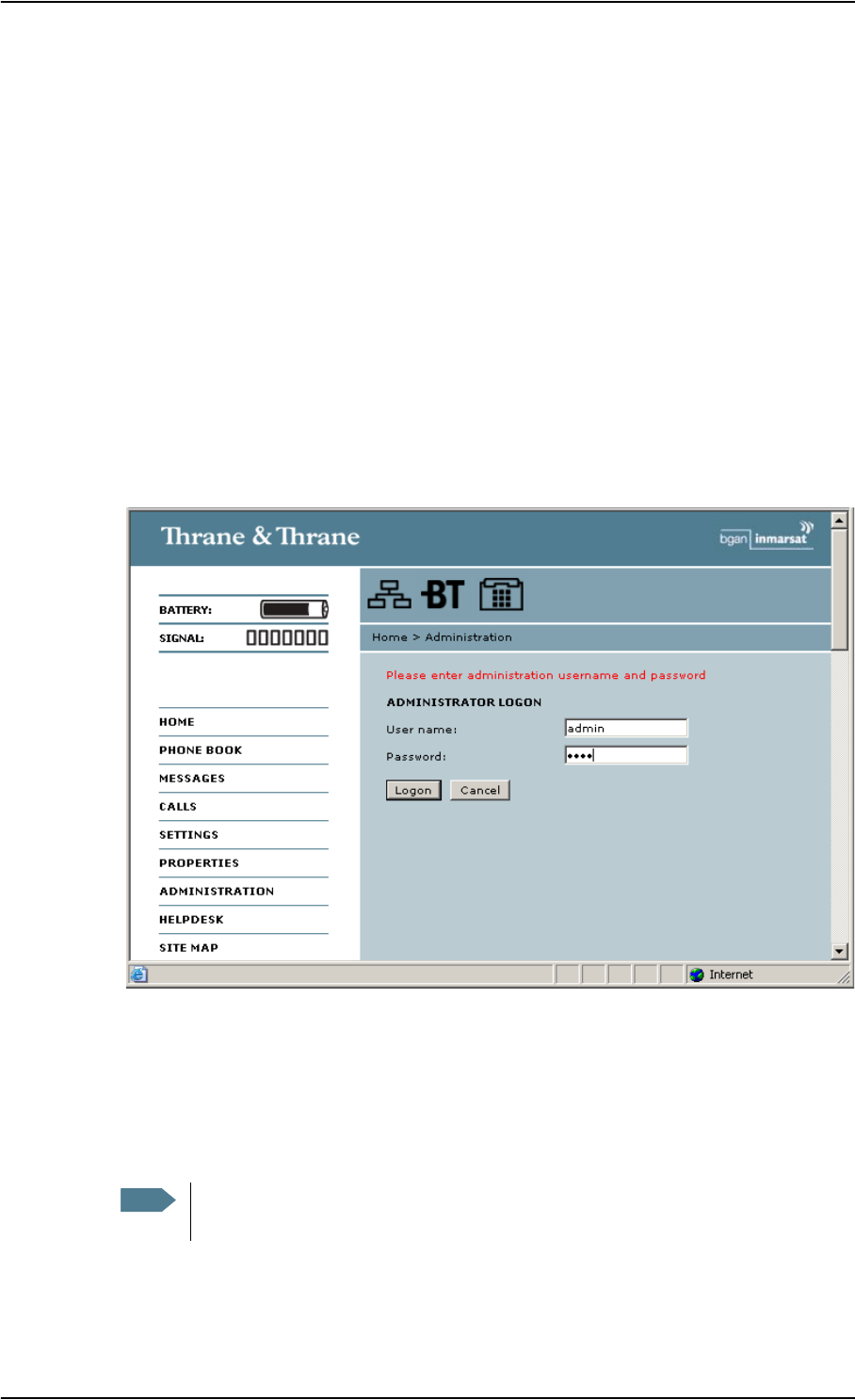
Chapter 5: Using the web interface
TT 98-123571-DraftA Properties, software upload and alarm list 101
Uploading software
You can upload software to the EXPLORER™ 300 without entering the PIN. However, if the PIN is
not entered, you must enter the Administration user name and password.
To upload software to the EXPLORER™ 300, do as follows:
1. Acquire the new software version from Thrane & Thrane and save it on your computer.
2. In the web interface, select PROPERTIES from the left navigation pane.
The Software version field shows the current software version.
3. Click Upload from the left navigation pane.
If you have not entered the PIN at start-up, you are prompted for an Administration user
name and password.
4. If required, type in the Administration user name and password and click Logon.
The default user name is admin and the default password is 1234.
5. Click Browse...
6. Browse to the new software version and accept it.
7. Click the Upload button.
Note that the upload procedure takes a couple of minutes.
Note When upload is done, your EXPLORER™ 300 automatically restarts with the new
software.
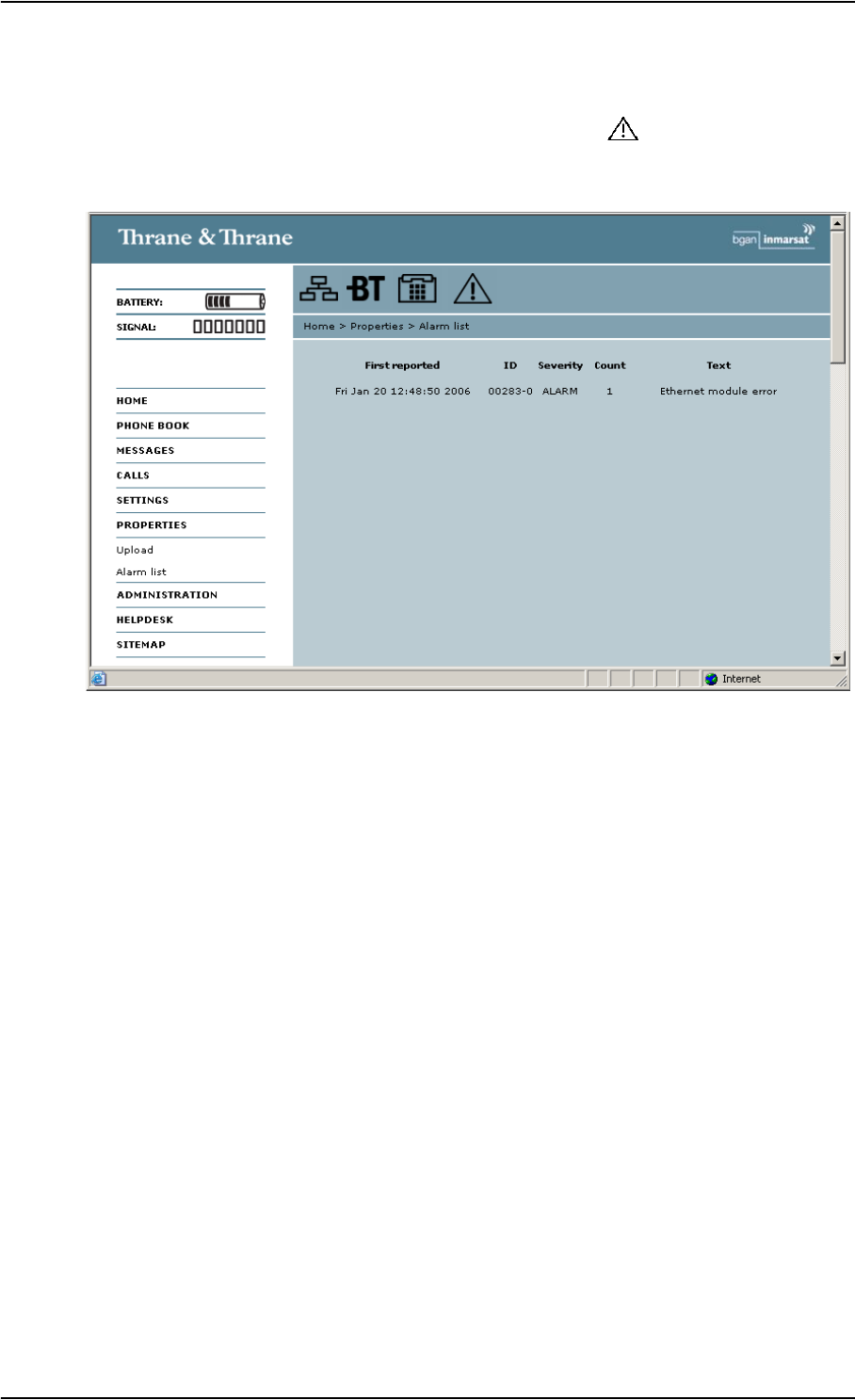
Chapter 5: Using the web interface
TT 98-123571-DraftA Properties, software upload and alarm list 102
Viewing the Alarm List
When an alarm is issued, the web interface shows an alarm icon in the icon bar.
To view the Alarm list, click the alarm icon from the icon bar at the top of the web interface or
select Properties > Alarm list from the left navigation pane.
The Alarm list window shows a detailed list of active alarms including the time of the first
occurrence, ID and severity of the alarm message, number of occurrences and a short text
describing the error. For more information on the alarm messages, refer to Alarm messages on
page 122.
If you need to report the alarms for service purposes, make sure you include the complete ID
number. This number is used by service personnel to uniquely identify an alarm.
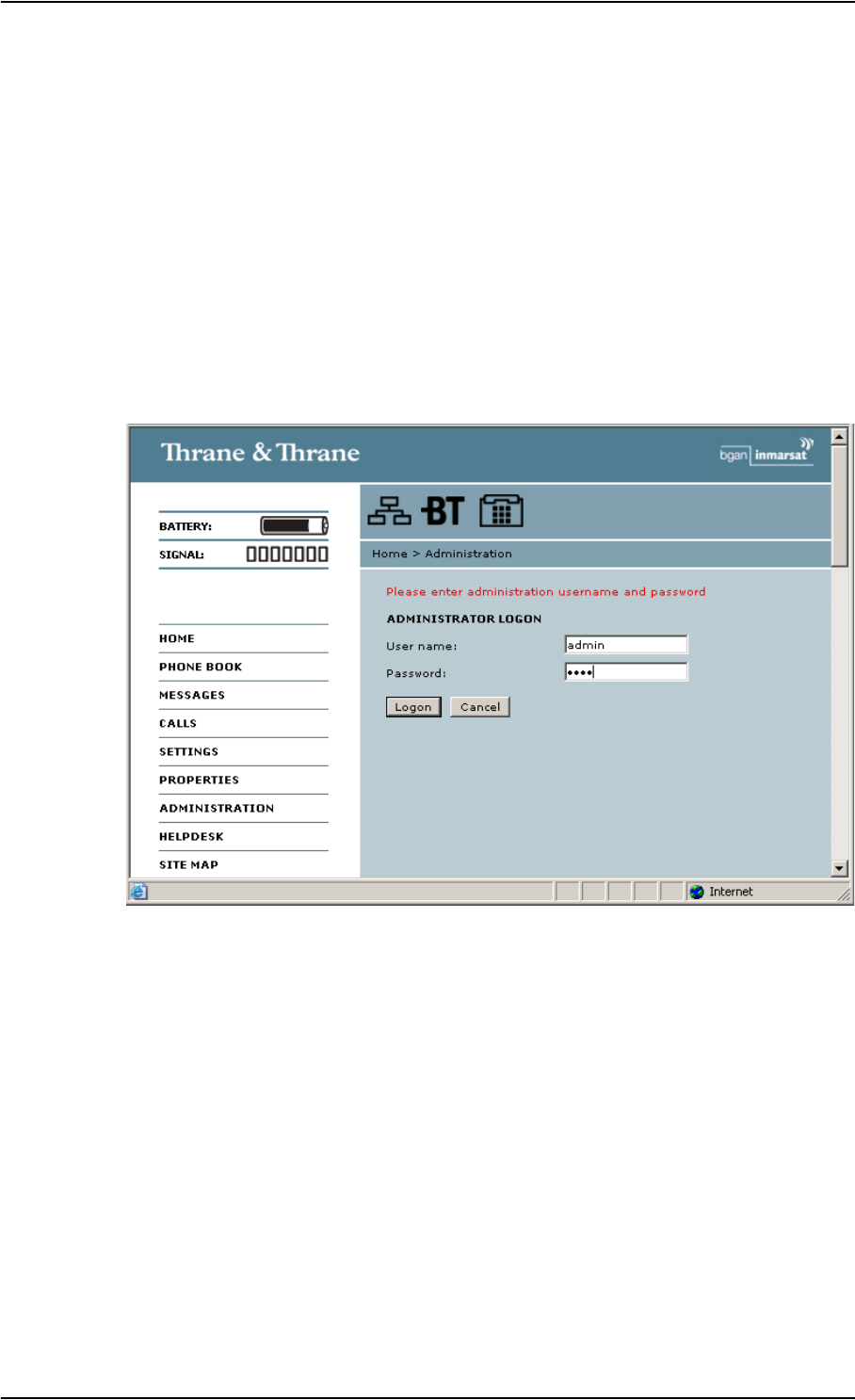
Chapter 5: Using the web interface
TT 98-123571-DraftA Administration 103
Administration
Accessing the administration settings
Logging on
The Administration settings require an Administration user name and password.
1. Select ADMINISTRATION from the left navigation pane.
2. Enter the Administration user name and password.
The default user name is admin and the default password is 1234.
The next section explains how to change the user name and password.
3. Click Logon.
The Administration window is now updated to let you change the user name and password,
Save/load a configuration or log off Administration.
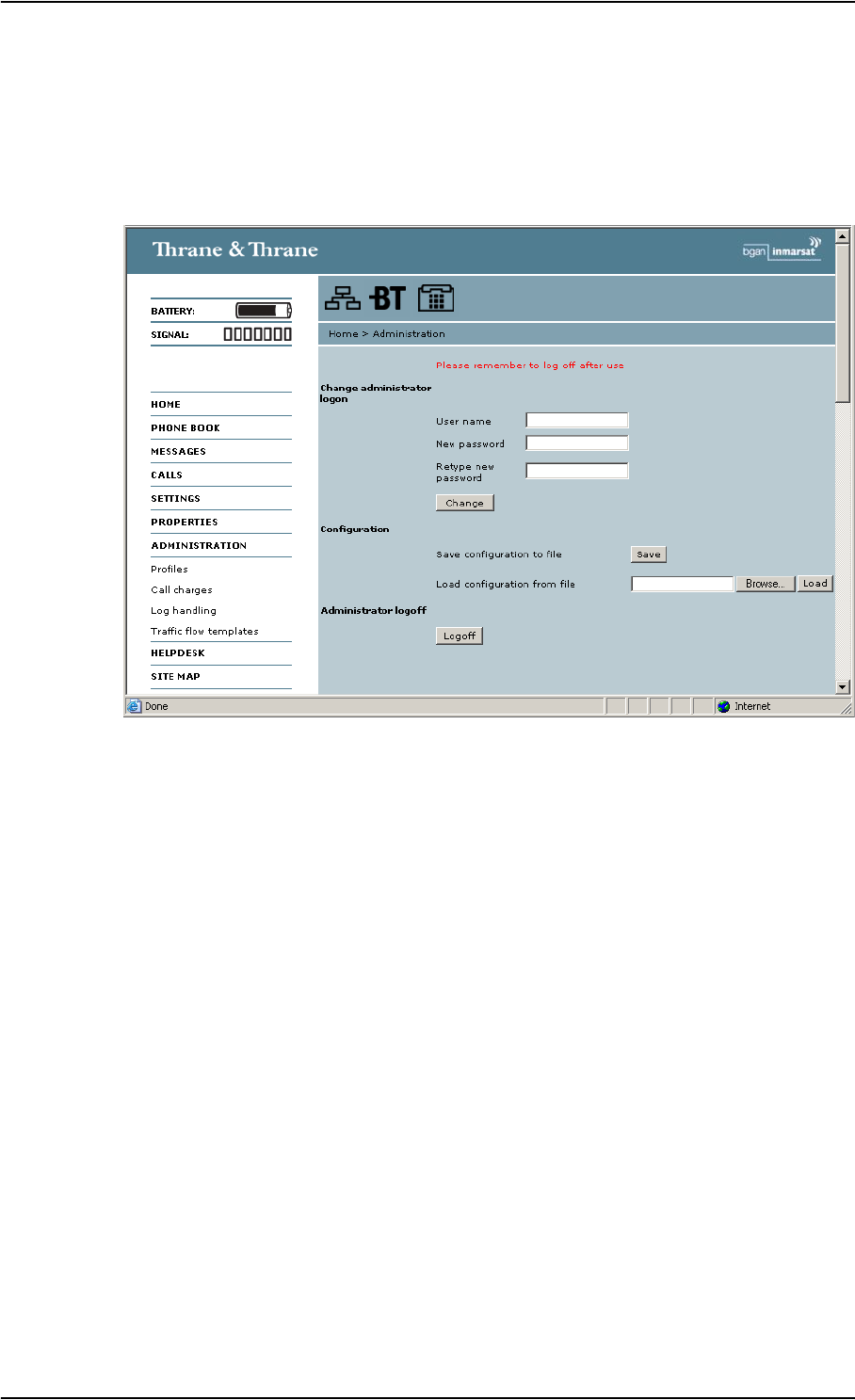
Chapter 5: Using the web interface
TT 98-123571-DraftA Administration 104
Changing the administration password
Do as follows:
1. After entering the Administration user name and password in the ADMINISTRATION window,
locate the section Change administrator logon.
2. Type in the existing user name.
3. Type in the new password twice.
4. Click Change.
At the next logon the new password is required.
Saving a configuration to a file
If you need to reuse a configuration in another EXPLORER™ 300, you can save your current
configuration to a file, which can then be loaded into the other EXPLORER™ 300.
Do as follows:
1. In the ADMINISTRATION window, under Configuration, click Save.
2. Accept the default destination file name or type in the destination file name and location.
3. Click OK.
The configuration is now saved to a file. This file is used to load the configuration into another
EXPLORER™ 300. See the next section.

Chapter 5: Using the web interface
TT 98-123571-DraftA Administration 105
Loading a configuration from a file
1. In the ADMINISTRATION window, under Configuration, click Load.
2. Click Browse... to browse to the file you want to import. Then click Open.
3. Click Load.
The new configuration is now loaded into your EXPLORER™ 300.
Logging off administration
If you have not entered anything for 30 minutes under ADMINISTRATION, you are logged off
automatically.
To log off manually, click Logoff under Administrator logoff in the ADMINISTRATION window.
Call charges
If you know the tariff for your subscribed services, you can enter these tariffs in the web interface
and automatically calculate the charges for your calls and data sessions.
Do as follows:
1. From the left navigation pane, select
ADMINISTRATION > Call Charges.
2. Select the currency from the Currency drop-down list.
3. Enter the tariff for each of the services.
4. Click Apply.
The entered tariffs are used for estimating the charges for calls and data sessions. The
estimated charge is listed for each call or data session in the call log. For further information,
see Viewing the lists of calls on page 78.
Log handling
1. From the left navigation pane in the ADMINISTRATION window, select Log Handling.
2. To clear the Call log, click OK next to Clear call log?.
3. To clear the total counters, click OK next to Clear total counter?.
This will reset the Time connected counters on the Calls page.
Note Thrane & Thrane does not take responsibility for the correctness of the estimated
charges. This calculation is only a rough estimate of the charge, based on the tariff
entered by the user. Also, the Airtime Provider may have different methods of calculating
the charge.

Chapter 5: Using the web interface
TT 98-123571-DraftA Administration 106
Using Profiles
What is a Profile?
A Profile is a collection of Quality of Service (QoS) settings and other settings defining the mode in
which data is transmitted on an interface. For example, a Profile is used to define whether the
connection is a Streaming connection or a Standard connection.
You can select between a number of predefined Profiles or define your own Profiles for your data
transmission.
If no Traffic Flow Template (TFT) is defined, the Primary Profile for an interface is used for all traffic
on that interface. See What is a Traffic Flow Template? in the next section.
For further information on Profiles, refer to the 3GPP standard TS 23.107.
Selecting the Profiles for an interface
When you set up your interface, you select the Profiles to use for that interface. You select a
Primary Profile and optionally one or more Secondary Profiles.
For further information on how to select the Profiles, see the “Configuring...” sections for the
individual interfaces in this chapter.
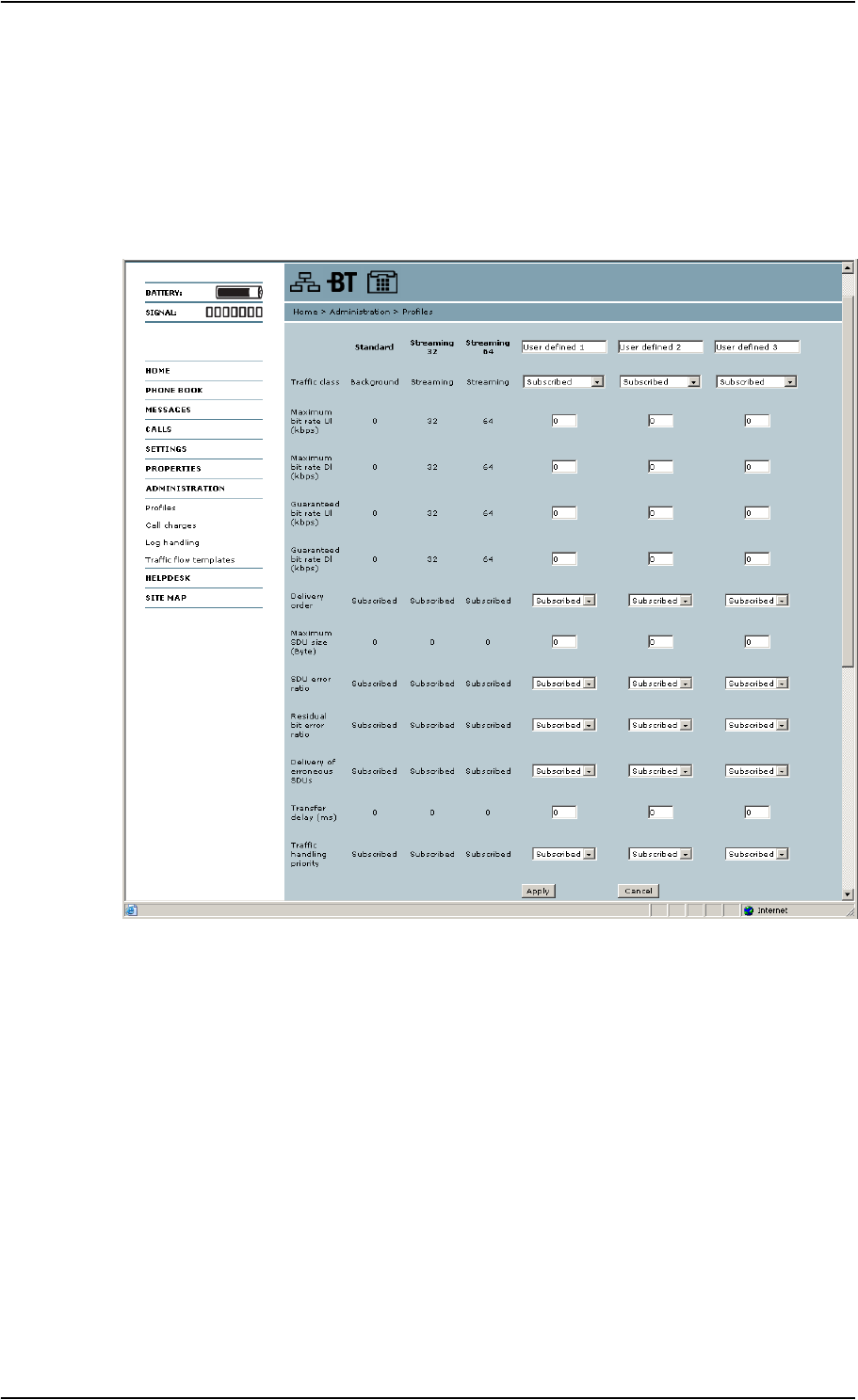
Chapter 5: Using the web interface
TT 98-123571-DraftA Administration 107
Defining new Profiles
When you define your Profiles you can select Subscribed for many of the settings. If you select
Subscribed, the value given in your Airtime subscription will automatically be used.
To define a new Profile, do as follows:
1. From the left navigation pane, select ADMINISTRATION > Profiles.
2. In one of the User defined columns, fill in the top field with the name of your Profile.
3. In the Traffic class row of your new Profile, select a class from the drop-down list.
You may select one of the following:
•Conversational is real-time two-way conversation. It is primarily used for voice over IP and
video conferencing.
•Streaming is real-time one-way communication. It is primarily used for video and audio.
•Interactive is two-way communication (not real-time). It is used for communication that is
not very delay-sensitive, such as web browsing, data base retrieval and server access.
Examples of machines interaction with remote equipment are: polling for measurement
records and automatic data base enquiries (tele-machines).
•Background is used for data which is not delay-sensitive, such as E-mails, SMS, download
of databases and reception of measurement records.

Chapter 5: Using the web interface
TT 98-123571-DraftA Administration 108
4. Type in the bit rates in kbps in the following rows:
•Maximum bit rate ul (kbps) is the maximum upload bit rate allowed for this Profile.
•Maximum bit rate dl (kbps) is the maximum download bit rate allowed for this Profile.
•Guaranteed bit rate ul (kbps) is the guaranteed upload bit rate needed for this Profile.
•Guaranteed bit rate dl (kbps) is the guaranteed download bit rate needed for this Profile.
5. In the Delivery order row, select from the scroll list whether or not data should be delivered in
the same order it was sent. Yes means the data packets are delivered in the same order they
were sent.
6. In the Maximum SDU size (byte) row, type in the maximum allowed packet size in Bytes
(rounded off to nearest 10). The maximum packet size possible is 1520.
7. In the Delivery of erroneous SDUs row, select one of the following from the list:
•Yes means packets are allowed to contain errors. This setting is suitable for delay-sensitive
transmission, because the need for retransmission is limited. The SDU Error settings in step
8. and step 9. will apply.
•No means packets are not allowed to contain errors, and the SDU Error setting in step 8.
will not be applied. This setting is suitable where error-free transmission is important and
delays are accepted.
•No detect means that errors will not be detected, and the SDU Error setting in step 8. will
not be applied.
8. If you selected Yes in step 7., select from the SDU error ratio drop-down list the fraction of a
packet allowed to be lost or erroneous.
9. Select from the Residual bit error ratio drop-down list the undetected bit error ratio of a
packet. If no error detection is requested, Residual bit error ratio indicates the bit error ratio
in the delivered packets.
10. In the Transfer delay (ms) row, type in the delay in ms. This is the delay from data is received
in the EXPLORER™ 300 until it arrives at the receiving end.
11. In the Traffic handling priority row, select from the drop-down list which priority this
connection should have.
12. Click Apply.
The new Profile is now added, and can be selected from the lists of primary and secondary
Profiles when you set up your interfaces.
Important For best performance, choose the right traffic class for your application. In
general, Standard data (Background) is best suited for TCP/IP applications, and
Streaming data is best suited for UDP traffic, e.g. live video or audio.
Note When you click Apply, the bit rate values you typed in may be rounded off because
only certain values are allowed.

Chapter 5: Using the web interface
TT 98-123571-DraftA Administration 109
Using a Traffic Flow Template
What is a Traffic Flow Template?
A Traffic Flow Template (TFT) is a packet filter list allowing the Core network and the
EXPLORER™ 300 to classify packets received from the external network into the proper PDP
(Packet Data Protocol) context.
A TFT consists of from one and up to eight packet filters, each identified by a unique packet filter
identifier. A packet filter also has an evaluation precedence index that is unique within all TFTs
associated with the PDP contexts that share the same PDP address.
Information of source, destination, type of service etc. is combined in each packet filter in the TFT.
Purpose of the Traffic Flow Template
The purpose of the TFT is to assign different priorities to different types of traffic, in order to
optimize performance.
Example: When you are browsing the Internet, a Standard data connection will normally be
sufficient. However, if you need to have a video conference, you may need to use a
Streaming connection, in order to obtain a direct connection without interruptions. Your
Traffic Flow Template can define these priorities, so that your connection automatically
switches to Streaming e.g. when you have a video conference.
Defining the Traffic Flow Template
To define a new template, do as follows:
1. From the left navigation pane, select
ADMINISTRATION > Traffic Flow Templates.
2. Select which filters should apply to which Profiles.
The filters are defined in the Traffic flow filters list. Refer to the next section
3. Click Apply.
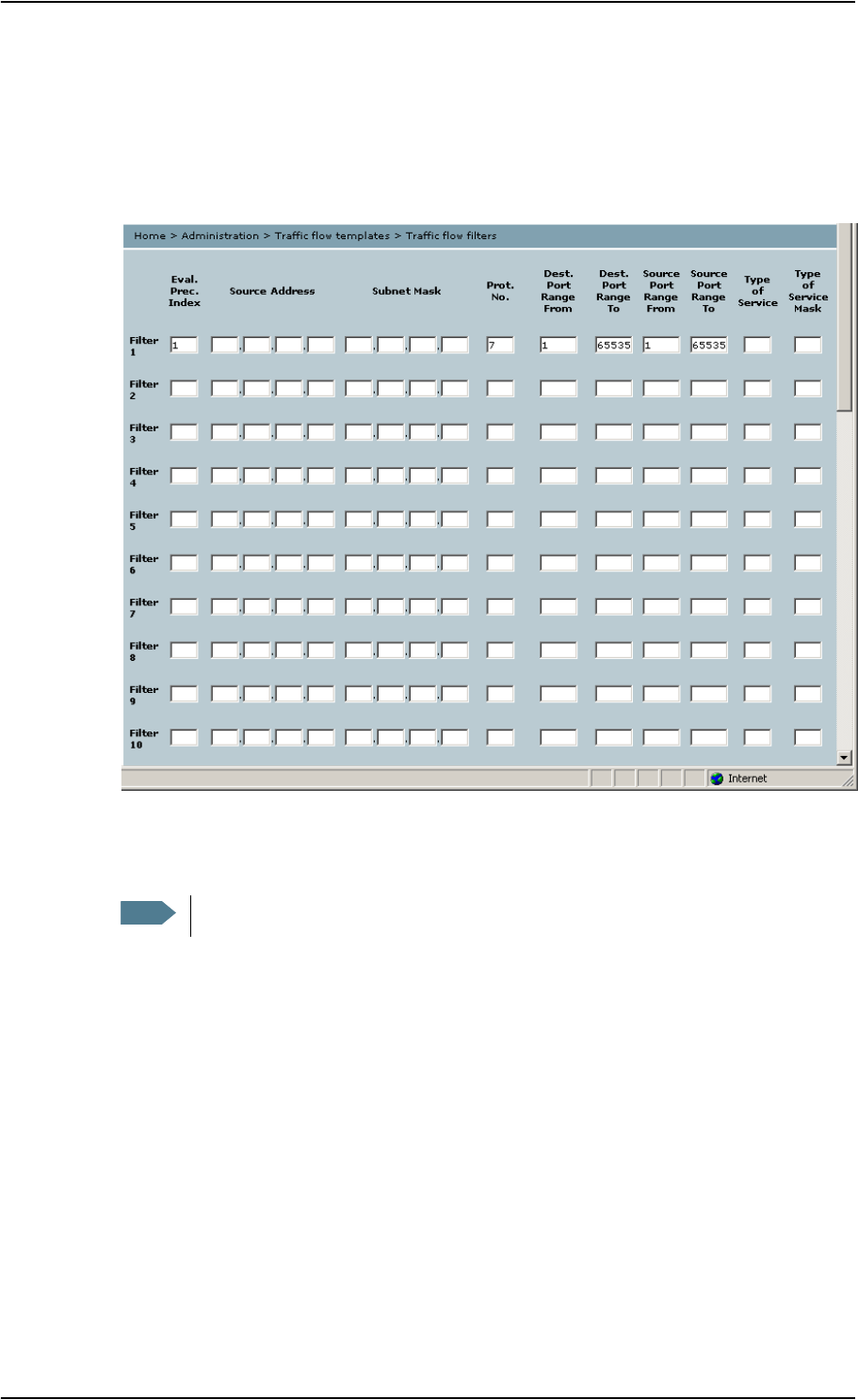
Chapter 5: Using the web interface
TT 98-123571-DraftA Administration 110
Defining filters for the Traffic Flow Template
To define the filters used in the Traffic flow template, do as follows:
1. From the left navigation pane, select
ADMINISTRATION > Traffic Flow Templates > Traffic flow filters.
Then fill in the details for each traffic flow filter as described below.
2. Type in an Evaluation Precedence Index in the Eval.Prec. Index column.
3. Fill in one or more of the following fields to define the filter.
The allowed ranges appear in hover text when you pass the mouse over the fields.
•Source address + Subnet mask.
•Protocol number.
•Destination port range (From and To).Note that Source and Destination are relative the core
network. This means that Destination is your EXPLORER™ 300 terminal.
•Source port range (From and To).
•Type of Service + Type of Service mask.
For further information on the principles and parameters of the Traffic Flow Template, refer to
the 3GPP standards TS27.007 V4.2.0 and TS 23.060 V4.7.0.
4. Click Apply at the bottom of the window.
The new settings are included if you select the filter in the Traffic flow template window.
Note This field is mandatory. Each filter must have a different index.

Chapter 5: Using the web interface
TT 98-123571-DraftA Help desk and diagnostic report 111
Help desk and diagnostic report
Accessing the Help desk
If you need help with airtime-related issues you may call the Help desk. By default, the Help desk
is the phone number for your Airtime Provider, if it is available on the SIM card.
Select HELP DESK from the left navigation pane.
If the Help desk number is available on the SIM card, the number is displayed as a link. To change
the number, click the link, change the number and click Apply.
If you need help with EXPLORER™ 300 issues you should call your local distributor.
Generating a diagnostic report
If you want to generate a diagnostic report, do as follows:
1. Click Generate report from the HELP DESK window.
In some browsers the file may open directly in your browser. If it does, choose File > Save As
to save the file.
2. Choose a location for the file and save it.
The diagnostic report contains relevant information for troubleshooting. Please enclose this file
when you are reporting an error.
What’s next?
This chapter has explained how to use the web interface for setup and use of the EXPLORER™ 300.
You should now be able to set up the EXPLORER™ 300, pair Bluetooth devices, check status, read
and send SMS messages, use the phone book and much more.
The following chapter, Maintenance and troubleshooting, provides guidelines for troubleshooting
and for general maintenance.

TT 98-123571-DraftA 112
Chapter 6
Maintenance and troubleshooting 6
In this chapter
This chapter gives guidelines for troubleshooting and for general maintenance. It also provides an
overview of the different means of status signaling,
Getting support
Overview
If this manual does not provide the information required to solve your problem, you may want to
contact your Airtime Provider or your local distributor.
Airtime support
If you need assistance from your Airtime Provider, please call the help desk.
To see the help desk number, enter the display menu system or the web interface of your
EXPLORER™ 300 and select HELP DESK. This help desk number is either taken from the SIM card
or entered manually. If no number is available under HELP DESK, check your Airtime subscription
for a contact number.
EXPLORER™ 300 support
If you need assistance with problems caused by the EXPLORER™ 300, please call a distributor in
your area.
Click this link to see a list of Thrane & Thrane distributors.
Note The list of distributors is located on the EXPLORER™ 300 CD-ROM delivered with your
EXPLORER™ 300, so it may not always be up to date.
An updated list is available on Thrane & Thrane’s web site: www.thrane.com.
Click Land Mobile and select Distributors from the top menu bar.

Chapter 6: Maintenance and troubleshooting
TT 98-123571-DraftA 113
Uploading software
Viewing software version status
To view the version of the embedded software in the EXPLORER™ 300, select PROPERTIES in the
web interface or in the display menus and see Software information.
Uploading software using the web interface
You can upload software from the PROPERTIES > Upload window in the web interface.
If you have an Administrator user name and password you do not need to insert a SIM card nor to
enter the PIN to be able to upload software.
For further information, see Uploading software on page 101.
Maintenance
Normal use of the battery
It is recommended not to partially charge/discharge the battery several times in a row. Partial
charging/discharging affects the accuracy of the capacity measurement.
Never leave the battery fully discharged for a longer period of time. If the battery is not to be used
for a shorter period of time (1 month), charge the battery to minimum 20 to 30% and remove it
from the EXPLORER™ 300. If the Battery is stored for more than a month, see Storage at the end of
this section.
Recharging the battery
To recharge the battery, insert it into the EXPLORER™ 300 and connect the EXPLORER™ 300 to
power.
The indicator left to the display is constantly green as long as the battery is charging. When the
battery is fully recharged, the green indicator is turned off. If the EXPLORER™ 300 is switched on,
the green indicator will be flashing shortly every 2 seconds.
If a charging error occurs, the green indicator on the EXPLORER™ 300 flashes rapidly. See the
Troubleshooting Guide on page 116.
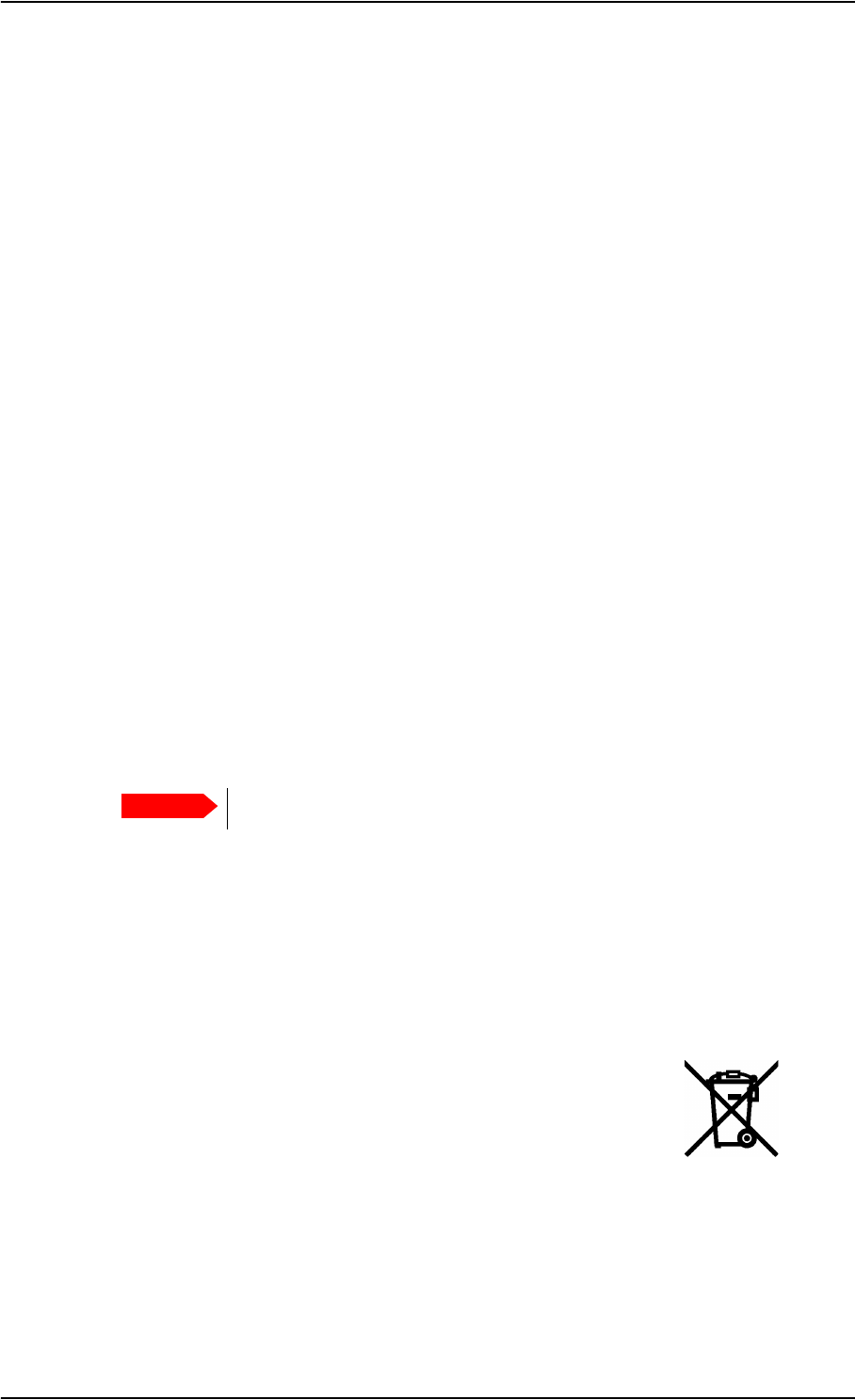
Chapter 6: Maintenance and troubleshooting
TT 98-123571-DraftA 114
Accurate display of the battery capacity
To ensure accurate display of the battery capacity, it is recommended to run a “learning cycle” for
every 100 recharge/discharge and at first time use. The learning cycle must be performed at 20°C-
30°C.
A learning cycle is performed as follows:
1. Fully charge the battery.
2. Remove external power and fully discharge the battery:
Use the EXPLORER™ 300 and/or leave it on until it turns off automatically.
This way the EXPLORER™ 300 “learns” the complete capacity of the battery.
Note that it may take up to 36 hours to discharge the battery if it is not in use.
3. Recharge the battery.
Storage
Do not leave the battery inserted in the EXPLORER™ 300 during storage.
If the battery is not to be used for a longer period of time, do as follows:
1. Fully charge the battery.
2. Remove external power. Then use the EXPLORER™ 300 or leave it on until the display shows a
battery capacity of approximately 50%.
3. Switch off the EXPLORER™ 300.
4. Remove the battery and store it.
In this condition the battery can be stored for approximately 1 year at 20°C to 30°C. After 1 year you
must recharge the battery. For further information on storage temperature, see Battery on
page 129.
Disposal of the EXPLORER™ 300
Old electrical and electronic equipment marked with this symbol can
contain substances hazardous to human beings and the environment.
Never dispose these items together with unsorted municipal waste
(household waste).
In order to protect the environment and ensure the correct recycling of old equipment as well as
the re-utilization of individual components, use either public collection or private collection by the
local distributor of old electrical and electronic equipment marked with this symbol.
Contact the local distributor for information about what type of return system to use.
Important Switch off the EXPLORER™ 300 before removing the battery!
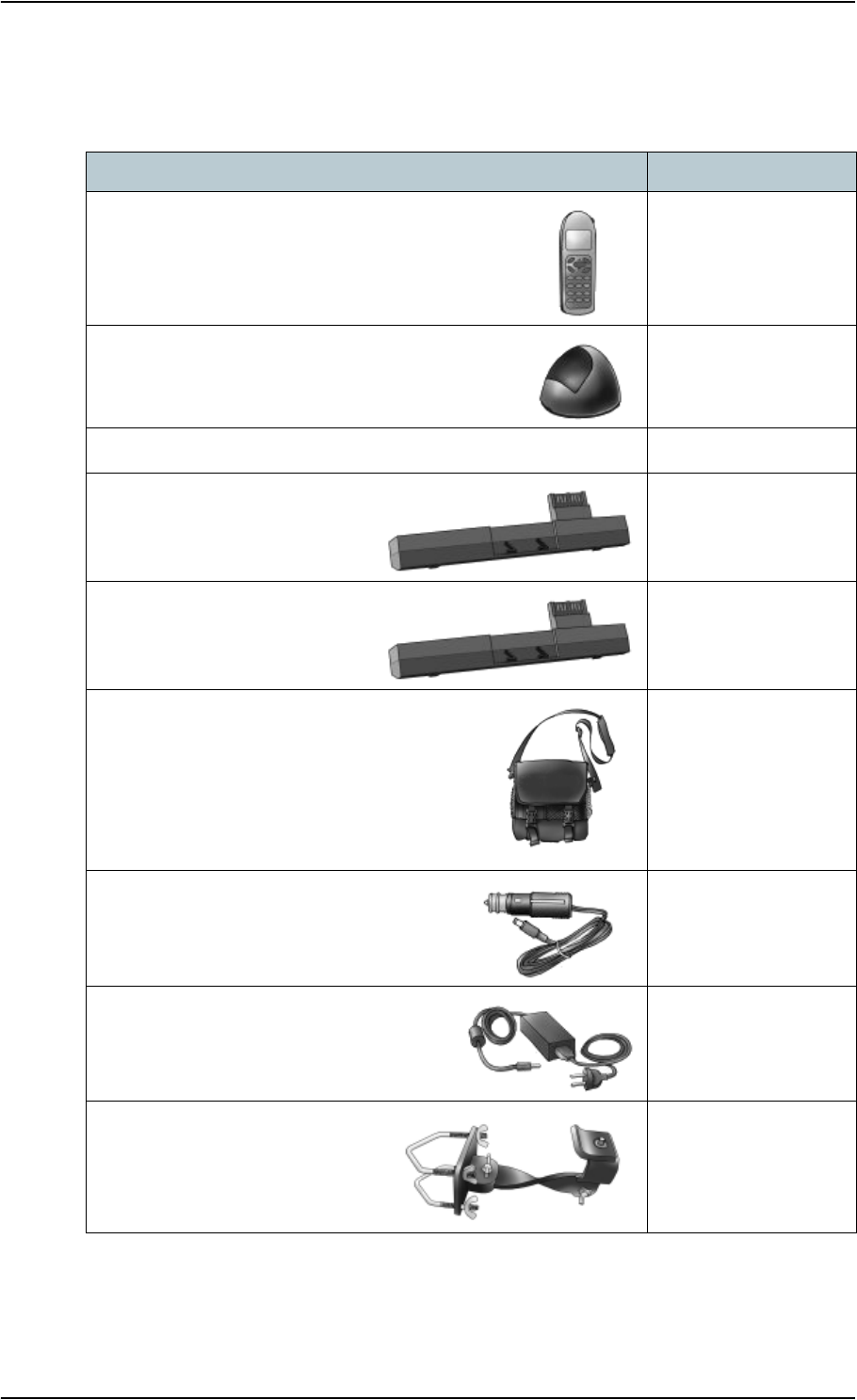
Chapter 6: Maintenance and troubleshooting
TT 98-123571-DraftA 115
Options and accessories
The following options and accessories are available from Thrane & Thrane:
Item Number
EXPLORER™ Bluetooth Handset + charger cable
TT-3625A
Desktop charger cradle for EXPLORER™ Bluetooth
Handset + power supply
TT-3625A, Opt. 003
EXPLORER™ 2-wire phone + cable TT-3625B
EXPLORER™ 300 Battery
TT-3686L
EXPLORER™ 300 Dummy Battery TT-3686F
EXPLORER™ 300 Softbag
TT-3650A, Opt. 202
EXPLORER™ 300 Car charger cable
TT-3650A, Opt. 009
EXPLORER™ 300 AC/DC adapter
TT-3682L
UP0501Q-15P
Pole mount kit for EXPLORER™ 300 TT-3650A, Opt. 922

Chapter 6: Maintenance and troubleshooting
TT 98-123571-DraftA 116
Troubleshooting guide
The below table provides information on some of the problems that might occur, including
possible causes and remedies to solve the problems.
Problem Possible Cause Remedy
The EXPLORER™ 300
cannot be switched
on, or does not stay
on when powered by
the battery.
The battery needs
recharging.
Recharge the battery. Check the battery
indicator in the display.
The battery is not inserted
properly.
Remove the battery and re-insert it.
Make sure the battery is inserted
properly and that the latch is locked.
The battery contacts are
dirty or damaged.
Clean the battery contacts if necessary.
If the contacts are damaged, replace the
battery.
There is no light in
the power indicator
nor in the display
when the
EXPLORER™ 300 is
switched on.
The EXPLORER™ 300 may
be in Stealth Mode (all
lights and sounds are off).
Press C+OK on the display keypad. This
will toggle Stealth Mode on/off.
The EXPLORER™ 300
cannot be switched
off.
The Power button was not
pressed long enough.
When you switch off the
EXPLORER™ 300, hold the Power
button until the display shows
“Switching off”.
In rare cases, it may take up to 10
seconds to switch off the
EXPLORER™ 300.
Charging error -
The green Power
indicator flashes
rapidly while the
battery is being
recharged.
The temperature is below
0°C or above 45°C.
Only charge the battery when the
temperature is within the range 0°C to
45°C.
The charging voltage is
less than 9 V.
Wait until charging begins (the green
Power indicator lights constantly).
If the battery is completely discharged,
and it has been out of use for a long
time, the charging process may take a
long time to start. If charging does not
begin within 2-3 hours, contact your
local distributor, or purchase a new
battery.

Chapter 6: Maintenance and troubleshooting
TT 98-123571-DraftA 117
The display shows
INSERT SIM.
The SIM card is not
present.
Remove the battery and insert the SIM
card in the SIM slot according to the
instructions in the section Inserting the
SIM card on page 12.
The SIM card is not
inserted properly.
Remove the SIM card and re-insert it
according to the instructions in the
section Inserting the SIM card on
page 12.
The display shows
NO GPS.
The EXPLORER™ 300 is
unable to register on the
network, because the GPS
position is unknown.
Make sure the view to the GPS satellites
is not blocked.
To obtain GPS fix, the EXPLORER™ 300
should be placed flat on an even
surface pointing straight upwards, with
a clear view to as much of the sky as
possible. When the EXPLORER™ 300
has obtained GPS fix, you can point the
antenna towards the BGAN satellite.
To see the GPS status, enter the menu
system and select PROPERTIES >
GPS STATUS.
The display shows
EMERGENCY
ONLY.
The BGAN network is only
available for emergency
calls.
The reason may be one of
the following:
1) You have pressed C on
the EXPLORER™ 300
instead of entering the PIN.
2) Your Airtime
subscription has expired.
3) You are using the wrong
SIM card.
1) If the display reads “ENTER PIN?”
and/or you cannot enter the display
menu system, you may have pressed C
instead of entering the PIN. Unless the
use of PIN is disabled, e.g. from the
BGAN LaunchPad, you must enter the
PIN before you are allowed make calls.
2) Check your subscription with the
Airtime Provider.
3) Check that your SIM card is valid for
communication on the BGAN network.
The display shows
NOT
REGISTERED.
The EXPLORER™ 300
cannot register on the
BGAN network.
Check that your SIM card is valid for
communication on the BGAN network.
Check your subscription with the
Airtime Provider.
Problem Possible Cause Remedy

Chapter 6: Maintenance and troubleshooting
TT 98-123571-DraftA 118
The EXPLORER™ 300
cannot obtain its
position using GPS.
There is no GPS signal, or
the signal is weak.
If the EXPLORER™ 300 has
not been used recently
within the same location, it
can take up to 10 minutes
to obtain the GPS position.
Check the GPS status in the display or
the web interface.
To help the EXPLORER™ 300 obtain GPS
fix, it should be placed flat on an even
surface pointing straight upwards, with
a clear view to as much of the sky as
possible.
When the EXPLORER™ 300 has
obtained GPS fix, you can point the
antenna towards the BGAN satellite.
No signal or weak
signal from the BGAN
satellite.
The view to the satellite is
blocked.
Make sure the EXPLORER™ 300 has a
clear view to the satellite. Be aware that
window glass, trees, or even rain may
reduce the signal level.
The antenna is pointed in
the wrong direction.
Check that the antenna is pointed
according to the position data.
Adjust the position to the highest
possible signal strength.
Connection to the
Internet cannot be
established.
The signal strength is too
low.
Check that the antenna is pointed
according to the position data.
Adjust the position to the highest signal
strength you can obtain.
As a rule of thumb, you should have a a
signal strength of 41 dBHz or more to be
able to make a call or data session.
Your connection is defined
as a dial-up connection,
but you have not opened
the dial-up connection.
You need to open the dial-up
connection before you can connect to
the Internet.
Your connection is a dial-
up connection, but you
have not entered the
phone number *98# to
indicate a connection to
the Internet.
Change the phone number in the dial-
up connection to *98# and open the
dial-up connection before accessing the
Internet.
Problem Possible Cause Remedy

Chapter 6: Maintenance and troubleshooting
TT 98-123571-DraftA 119
The web interface
cannot be accessed.
The browser is configured
to use a proxy server.
For Microsoft Internet Explorer, select
Tools > Internet Options > Connections >
LAN Settings and uncheck Use a proxy
server for your LAN.
You have entered a wrong
IP address.
Check the IP address and re-enter it.
Your connection is defined
as a dial-up connection,
but you have not opened
the dial-up connection.
You need to open the dial-up
connection before you can connect to
the Web server.
Your connection is a dial-
up connection, but you
have not entered the
phone number *98# or
*99# to indicate
connection to the Internet
and/or the web interface.
Change the phone number in the dial-
up connection to *98# or *99# and
open the dial-up connection before
accessing the web interface.
A Phone connection
cannot be
established.
The interface is disabled in
the EXPLORER™ 300.
Enable the interface by entering the
display menu system and selecting
SETTINGS > INTERFACES >
PHONE > ON, or
by accessing the web interface and
selecting SETTINGS > interfaces >
Phone > Enabled
The cable is not properly
connected.
Connect the cable.
The cable type or
connector type is not
correct.
For information on the correct type of
connector and cable, refer to Phone
interface on page 131.
Incoming calls: The voice
quality used for the call is
not selected in the web
interface.
Make sure the voice quality used for
calls to the EXPLORER™ 300 is selected
in the web interface. Access the web
interface and select SETTINGS>
Interfaces > Phone. Then select the
voice quality for incoming calls.
Problem Possible Cause Remedy

Chapter 6: Maintenance and troubleshooting
TT 98-123571-DraftA 120
A Bluetooth handset
connection cannot be
established.
The interface is disabled in
the EXPLORER™ 300.
Enable the interface by entering the
display menu system and selecting
SETTINGS > INTERFACES >
BLUETOOTH > ON, or
by accessing the web interface and
selecting SETTINGS > interfaces >
Bluetooth > Enabled
The Bluetooth handset is
placed too far away from
the EXPLORER™ 300.
Bring the handset closer to the
EXPLORER™ 300.
Note that the specified maximum
distance is only valid under ideal
conditions.
The handset is not yet
paired with the
EXPLORER™ 300.
Pair the devices. Refer to Making a call
to the EXPLORER™ 300 on page 55.
Incoming calls: The voice
quality used for the call is
not selected in the web
interface.
Make sure the voice quality used for
calls to the EXPLORER™ 300 is selected
in the web interface. Access the web
interface and select SETTINGS >
Interfaces > Bluetooth. Under
BLUETOOTH VOICE DEVICES locate the
relevant handset and select the right
voice quality for incoming calls.
A LAN connection
cannot be
established.
The interface is off in the
EXPLORER™ 300.
Enable the interface by entering the
display menu system and selecting
SETTINGS > INTERFACES > LAN >
ON, or
by accessing the web interface and
selecting SETTINGS > interfaces > LAN >
Enabled
The cable is not properly
connected.
Connect the cable.
The cable type or
connector type is not
correct.
For information on the correct type of
connector and cable, refer to LAN
interface on page 132.
Problem Possible Cause Remedy

Chapter 6: Maintenance and troubleshooting
TT 98-123571-DraftA 121
A Bluetooth data
connection cannot be
established.
The interface is off in the
EXPLORER™ 300.
Enable the interface by entering the
display menu system and selecting
SETTINGS > INTERFACES >
BLUETOOTH > ON, or
by accessing the web interface and
selecting SETTINGS > interfaces >
Bluetooth > Enabled.
The computer is placed too
far away from the
EXPLORER™ 300.
Bring the computer closer to the
EXPLORER™ 300.
Note that the specified maximum
distance is only valid under ideal
conditions.
The computer is not yet
paired with the
EXPLORER™ 300.
Pair the devices. Refer to Making a call
to the EXPLORER™ 300 on page 55.
The requested Bluetooth
profile is not supported, or
is not activated on the
computer.
Check the Bluetooth installation on your
computer to see if the profile is
supported and activated.
Problem Possible Cause Remedy
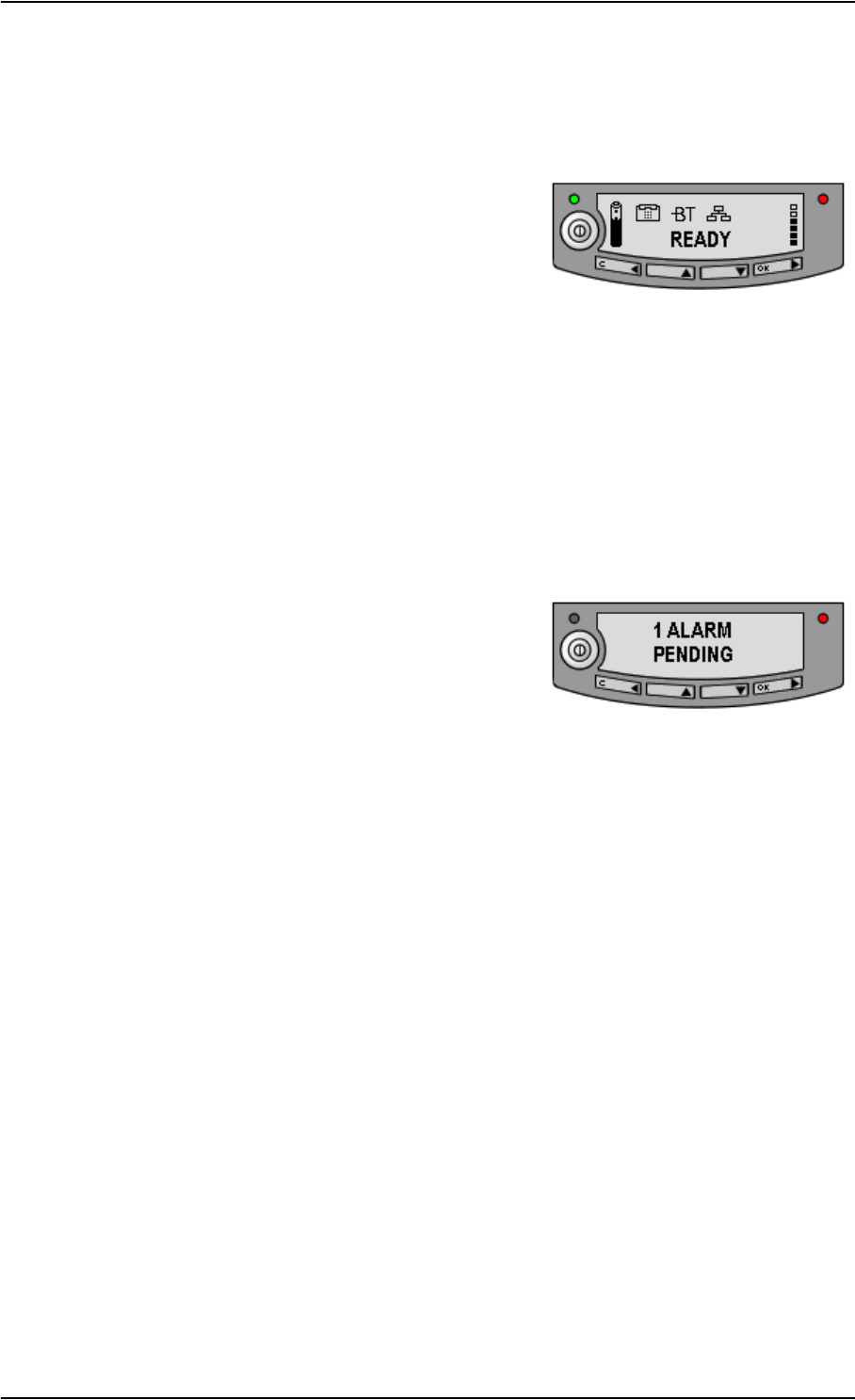
Chapter 6: Maintenance and troubleshooting
TT 98-123571-DraftA 122
Status signaling
There are many ways of troubleshooting if an error occurs. The EXPLORER™ 300 has different
means of status signaling, to help you find the cause of a problem:
•Indicators.
The function of the light indicators next to the
display is described in Light indicators on page 8.
•Alarm messages.
•Log files.
Alarm messages and log files are described in the following sections.
Alarm messages
Display of alarm messages
The EXPLORER™ 300 can detect errors during POST (Power On Self Test) or CM (Continuous
Monitoring). When the EXPLORER™ 300 detects an error that requires your action, it issues an
alarm.
When alarms are issued in your EXPLORER™ 300, the
display indicates the number of new alarms, and the
red message indicator is flashing.
You now have the following options:
•Press C to ignore the alarm message and continue from where you were before the alarm was
issued.
•Press OK to enter the alarm list showing all active alarms. The alarms are listed with their ID
numbers.
To see the name and time stamp of the alarm, press OK again.
Use S and T to scroll through the name, ID and time stamp. If the text is too long, press OK
(X) to scroll through the rest of the text.
As long as the cause of an alarm is still present, the Main screen shows VIEW ALARM LIST?
If you press OK, the list of currently active alarms appears.
Explanations for the alarms and remedies to solve the problems are listed in the next section.
All alarms are logged in the alarm log. For information on the alarm log, see Alarm log on
page 127.

Chapter 6: Maintenance and troubleshooting
TT 98-123571-DraftA 123
List of alarms
The following list explains the alarms that may show in the display and in the web interface of the
EXPLORER™ 300.
Note In the display and in the web interface the ID includes a hyphen followed by a control-
digit at the end. This digit is used to make sure the ID is not misinterpreted when passed
on, e.g. to service personnel. Make sure you include the entire number when contacting
your distributor.
ID Alarm Text Explanation Remedy
00100 to
00199
System Data
Damaged
Important system data is
damaged
Do not use the
EXPLORER™ 300. Contact
your distributor.
00200 to
00209
Battery Error Error during
communication with the
battery
Only use the
EXPLORER™ 300 with
external power supply.
Contact your distributor.
00210 to
00219
SIM Module
Error
The SIM interface on the
EXPLORER™ 300 cannot be
used.
Contact your distributor.
00230 to
00239
Temperature
Sensor FATAL
The system is in danger of
overheating.
Do not use the
EXPLORER™ 300. Contact
your distributor.
00240 to
00249
Temperature
Sensor Error
Automatic adjustment of
the display contrast does
not work.
Contact your distributor.
00250 to
00259
Bluetooth
Module Error
Bluetooth cannot be used. Contact your distributor.
00260 to
00269
System Error The EXPLORER™ 300
cannot communicate on the
satellite network.
Contact your distributor.
00270 to
00279
Voice Module
Error
Voice services cannot be
accessed by the
EXPLORER™ 300
Contact your distributor.
00280 to
00289
Ethernet
Module Error
The Ethernet interface on
the EXPLORER™ 300
cannot be used.
Contact your distributor.

Chapter 6: Maintenance and troubleshooting
TT 98-123571-DraftA 124
00290 to
00299
Power Supply
Error
Power on/off, charging
and/or LED control may be
out of function.
Contact your distributor.
00300 to
00309
GPS Module
Error
The GPS module is out of
function. The
EXPLORER™ 300 cannot
obtain a valid GPS position.
Contact your distributor.
01000 to
01009
Temperature
Too Low
Low ambient temperature is
causing the performance of
the EXPLORER™ 300 to be
degraded or halted.
Move the EXPLORER™ 300
to a warmer location.
For information on
temperature limits, see
General specifications on
page 128.
01100 to
01109
Temperature
Too High
High ambient temperature
is causing the performance
of the EXPLORER™ 300 to
be degraded or halted.
Move the EXPLORER™ 300
to a cooler location.
For information on
temperature limits, see
General specifications on
page 128.
01200 to
01209
Battery Level
Low
The battery is running out
of power.
Recharge the battery or
replace it with a new one.
01300 to
01309
No GPS Fix The GPS receiver has not
yet achieved position fix.
Make sure the view to the
GPS satellites is not
blocked.
To help the
EXPLORER™ 300 obtain
GPS fix, it should be placed
flat on a surface pointing
straight upwards, with a
clear view to as much of the
sky as possible.
Note that in some cases it
may take up to 10 minutes
to obtain GPS fix.
ID Alarm Text Explanation Remedy

Chapter 6: Maintenance and troubleshooting
TT 98-123571-DraftA 125
01400 to
01409
Satellite
Signal Lost
The EXPLORER™ 300 no
longer receives a signal
from the satellite.
Make sure the
EXPLORER™ 300 has a
clear view to the satellite.
Check that the antenna is
pointed according to the
position data. Adjust the
position to the highest
possible signal strength.
01500 to
01509
SIM Card
Missing
No SIM card is detected in
the SIM slot.
Insert SIM card.
If the SIM card is already
inserted, try removing and
reinserting it.
01600 to
01609
SOS Calls Only The SIM card is not
accepted by the network.
Only emergency calls are
allowed.
Enter the PIN and wait for
network approval. If the
problem persists, contact
your Airtime Provider.
01700 to
01709
Registration
For Voice
Failed
The EXPLORER™ 300 has
not yet been allowed to
register for voice services
(Circuit Switched).
If the problem persists,
contact your Airtime
Provider.
01800 to
01809
Registration
For Data
Failed
The EXPLORER™ 300 has
not yet been allowed
register for data services
(Packet Switched).
If the problem persists,
contact your Airtime
Provider.
01900 to
01909
Temperature
Too Low For
Charging
The temperature is too low
for the battery charger to
operate.
If charging is needed, move
the EXPLORER™ 300 to a
warmer location. The
temperature must be above
0°C/+32°F for the battery
charger to operate.
02000 to
02009
Satellite
Signal Weak
The signal from the satellite
is weak.
Check the line of sight to
the satellite. Be aware that
window glass may reduce
the signal level.
Check that the antenna is
pointed according to the
position data. Adjust the
position to the highest
possible signal strength.
ID Alarm Text Explanation Remedy

Chapter 6: Maintenance and troubleshooting
TT 98-123571-DraftA 126
02100 to
02109
Ciphering Off The network has turned
ciphering off.
Do not transmit data that
requires ciphering.
02200 to
02209
Ethernet
Connection
Failed
Ethernet data session could
not be established.
See the display call log for
the cause of the error. Refer
to Calls menu on page 38.
If the problem persists,
contact your distributor.
02400 to
02409
Invalid
Battery
The EXPLORER™ 300 is not
able to detect the battery
type.
The reason may be one of
the following:
• You are not using an
original Thrane &
Thrane battery
•The battery is defective
The EXPLORER™ 300
requires an original Thrane
& Thrane battery.
If you are already using an
original Thrane & Thrane
battery when you see this
alarm, contact your
distributor for support.
02800 to
02809
Antenna
Failure
The EXPLORER™ 300 is not
able to detect the state of
the antenna relay.
Do not use the terminal.
Contact your distributor.
02900 to
02909
Bluetooth
Device
Database Full
The list of paired Bluetooth
devices is full. The
EXPLORER™ 300 does not
allow more than 2 paired
devices.
Unpair a paired device to
make room for a new one.
For information on how to
unpair devices, see
Unpairing devices on
page 97.
02400 to
02409
Network failed
authentication
The EXPLORER™ 300 does
not accept the network as a
valid BGAN network.
Restart the
EXPLORER™ 300.
If the problem persists,
contact your distributor.
ID Alarm Text Explanation Remedy

Chapter 6: Maintenance and troubleshooting
TT 98-123571-DraftA 127
Log files
Note
When contacting Thrane & Thrane for support, please include a diagnostic report.
The diagnostic report contains information relevant for the service personnel during
troubleshooting.
To generate the diagnostic report, access the web interface and select Help Desk. Then click
Generate report.
Alarm log
The alarm log holds information of all alarms issued by the EXPLORER™ 300.
The log includes the time of the error, a short description, location of the error etc. This
information can help troubleshooting errors in the EXPLORER™ 300. The Alarm log is not
accessible from the user interface, but is included when you generate a diagnostic report. For
information, see Help desk and diagnostic report on page 111.
Call log
The call log holds information of up to 100 calls and data sessions to/from the EXPLORER™ 300.
The call log contains detailed information such as date, time, phone numbers, duration, Mb
transferred etc., for each call or data session.
Date and time is UTC time, received from the satellite.
For information on how to view the call log in the display, see Calls menu on page 38.
For information on how to view the call log in the web interface, see Viewing the lists of calls on
page 78.
Note The call log in the display shows information on voice calls but not on data sessions.

TT 98-123571-DraftA 128
Appendix A
Technical specifications A
In this appendix
This appendix contains technical specifications for the EXPLORER™ 300 and information on
Conformity.
General specifications
The EXPLORER™ 300 meets or exceeds current and proposed Inmarsat specifications for operation
on the Inmarsat Broadband Global Area Network.
Item Specification
Type EXPLORER™ 300, BGAN Class 3 Terminal
Max. data ratea
Downlink
Uplink
Streaming IP
a. Performance depends on a wide range of factors and actual usage.
384 kbps (shared)
240 kbps (shared)
32, 64 kbps
Physical dimensions 168 mm x 217 mm x 52 mm/
6.6” x 8.5” x 2.0”
Weight (including Battery) 1.4 kg/3.1 lbs
Environmental conditions
Operating temperature
Powered by external DC
Powered from battery
Storage temperature
Without battery
With battery
Relative humidity
Water & Dust
Max. wind-load
-25°C to +55°C/-13°F to +131°F
0°C to +55°C/+32°F to +131°F
-40°C to +80°C/-40°F to +176°F
-20°C to +60°C/-4°F to +140°F
95% non-condensing at +40°C/+104°F
IP-54 (dust and spray proof in all directions)
18 m/s or 59 ft/s (Operational)
Robustness 0.5 m/1.64 ft drop on concrete (Operational, 95% survival)
Supported web browsers
(Other browsers may be
supported as well, but only
these have been tested.)
Microsoft Internet Explorer 6.0
Mozilla Firefox 1.0
Apple Safari 2.0

Appendix A: Technical specifications
TT 98-123571-DraftA 129
Battery
Specifications
Item Specification
Battery type Lithium ion, rechargeable
Voltage 11.1 V
Capacity 2.2 Ah
Time between recharging
Standby timea
Tx time, max
Rx time, max
Standard callb
a. Performance depends on a wide range of factors and actual usage.
b. With either Bluetooth or Phone interface.
36 hours
1 hour 20 min. @ 96kbps, 0°C to +55°C/+32°F to +131°F
3 hours 30 min. @ 64kbps, 0°C to +55°C/+32°F to +131°F
3 hours, 0°C to +55°C/+32°F to +131°F
Charge timeaLess than 3 hours
(when the EXPLORER™ 300 is switched off)
Charge temperature 0°C to +45°C/+32°F to +113°F Ambient
Min. charge cycles 300
Storage temperature
1Month
3Months
1Year
-20°C to +60°C/-4°F to +140°F Ambient
-20°C to +45°C/-4°F to +113°F Ambient
-20°C to +20°C/-4°F to +68°F Ambient
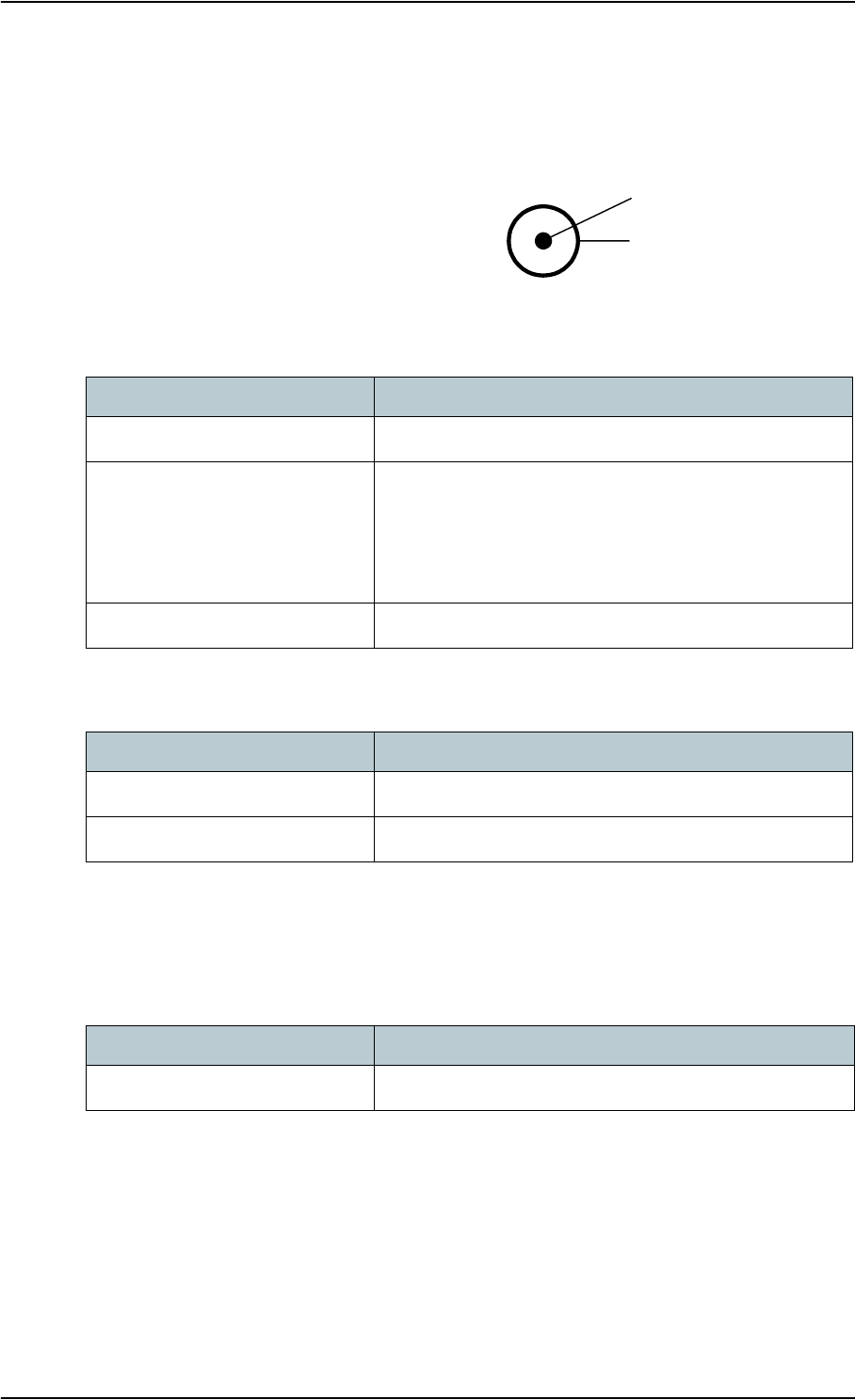
Appendix A: Technical specifications
TT 98-123571-DraftA 130
Power input
Connector pin-out
This drawing shows the pin-out for the DC Power
connector.
Specifications
AC/DC adapter,
SIM interface
Specifications
+
GND
Item Specification
DC input range +10 to +16 V DC
Power consumptiona
Standby mode
Transmit mode
During charging
a. Performance depends on a wide range of factors and actual usage.
0.8 W (Typical)
14 W (Typical)
38 W max.
Connector type 2.5mm EIAJ RC-5320-IV
Item Specification
AC input range 100 to 240 V AC, 47 to 63 Hz
DC output 15 V DC, 50 W
Item Specification
Slot type Standard SIM card holder
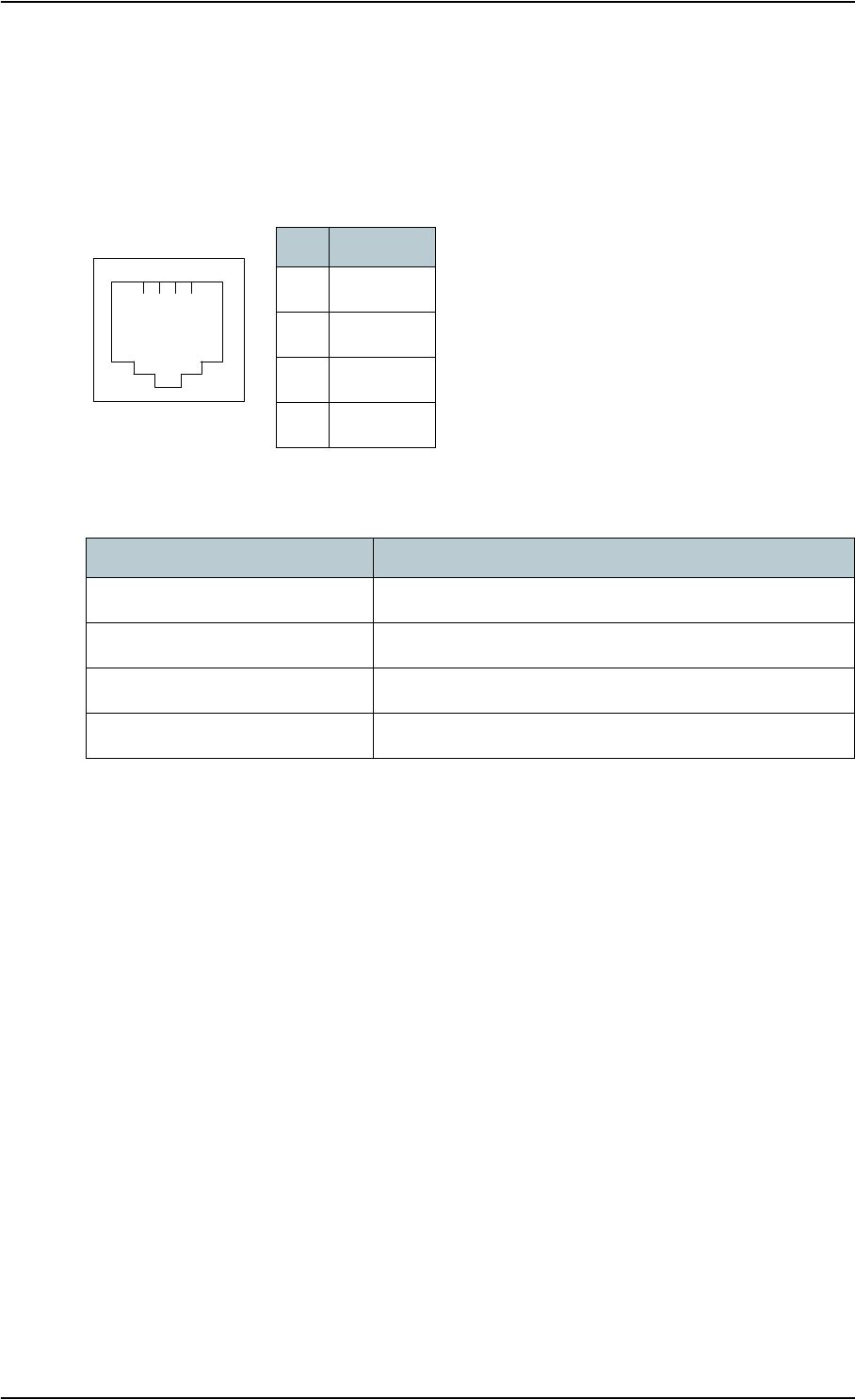
Appendix A: Technical specifications
TT 98-123571-DraftA 131
Phone interface
Connector pin-out
The pin-out for the Phone connector is as follows:
Specifications
Pin Function
1NC
2Tip
3Ring
4NC
1234
RJ-11 Connector
Female (Receptacle)
Item Specification
Connector type RJ-11, female
Impedance 180 Ω + 750 Ω/150nF
Max. cable length 100 m/80 Ω
Max. units connected One unit
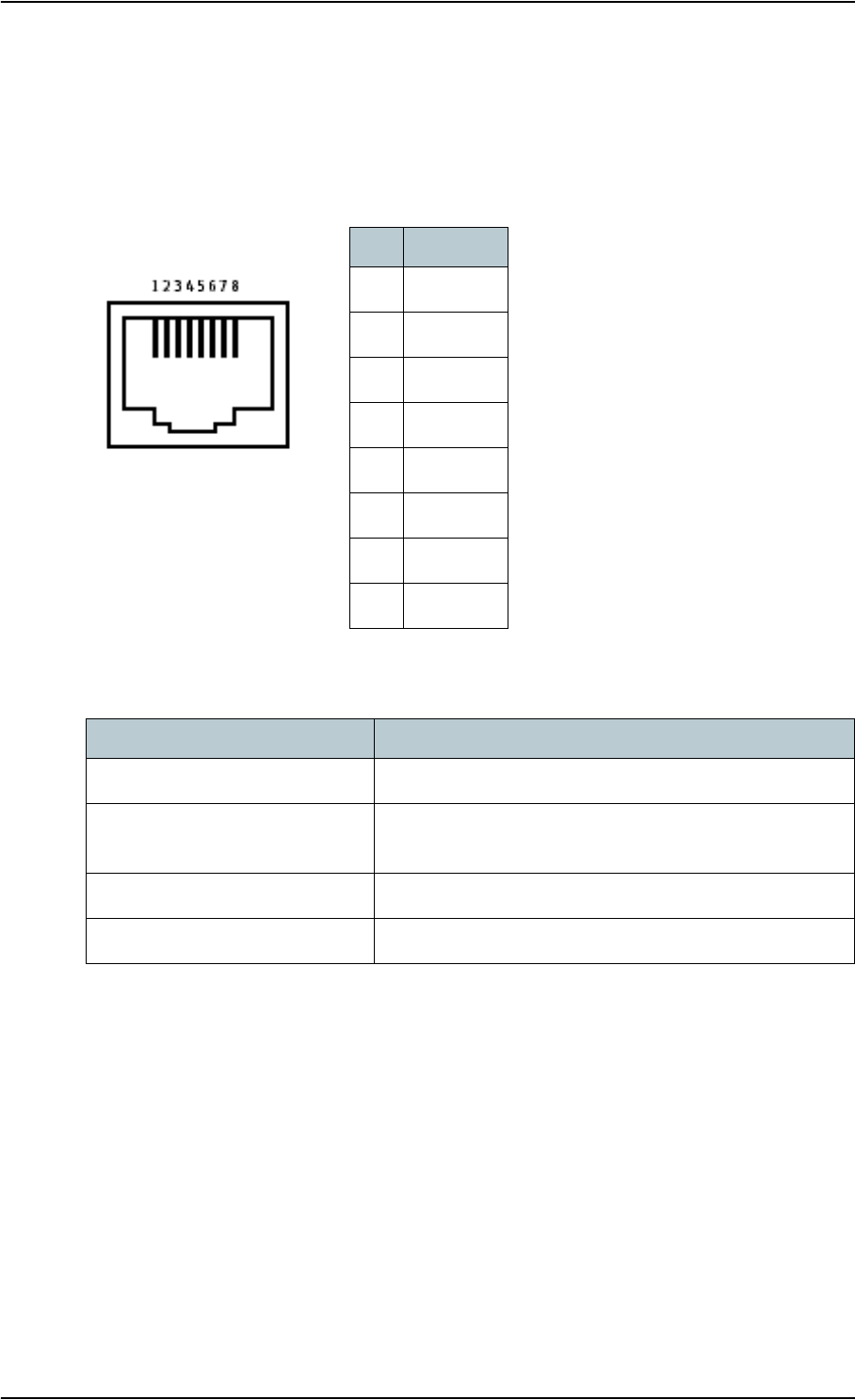
Appendix A: Technical specifications
TT 98-123571-DraftA 132
LAN interface
Connector pin-out
The pin-out for the LAN connector is as follows:
Specifications
Pin Function
1Rx +
2Rx -
3Tx +
4NC
5NC
6Tx -
7NC
8NC
RJ-45 Connector
Female (Receptacle)
Item Specification
Connector type RJ-45, female, MDI-X (IEEE 802.3 10/100BaseT)
Standard ISO/IEC 8877:1992 and
IEEE 802.3 1998 Edition
Max. data rate 10/100 Mbps
Max. cable length 100 m/328 ft with Cat5 UTP

Appendix A: Technical specifications
TT 98-123571-DraftA 133
Bluetooth interface
Specifications
Item Specification
Version 1.2
Standard Power Class 1. (reduced range: 25 m)
The Class 1 interface also supports Class 2 and Class 3
peripherals if they support RSSI (Received Signal Strength
Indicator).
Antenna Integrated in transceiver unit
Physical media Frequency-Hopping Spread Spectrum RF
Max. data rate 721 kbps + 57.6 kbps
Frequency 2400 to 2483.5 MHz
Max. coverage outdoora
a. Performance depends on a wide range of factors and actual usage.
25 m/82 ft
Max. number of devices
connected
1 handset and/or one PC/PDA
Profiles supported Cordless Telephony Profile (CTP)
Service Discovery Application
Serial Port Profiles (SPP):
• Dial-up Networking (DUN)
• Headset Profile (HSP)

Appendix A: Technical specifications
TT 98-123571-DraftA 134
Built-in antenna
Specifications
Item Specification
Type Directional patch array, manually adjustable
Polarization RHCP
Frequencies
Inmarsat
Transmit
Receive
Bearer bandwidth
GPS
Bluetooth
1626.5 to 1660.5 MHz
1525.0 to 1559.0 MHz
200 kHz
1575.42 MHz
2400.0 to 2483.5 MHz
EIRP 10 dBW ±1 dB
Power steps 0 to 6 dB in 1 dB steps

Appendix A: Technical specifications
TT 98-123571-DraftA 135
EXPLORER™ Bluetooth Handset charger interface
Connector pin-out
This drawing shows the connector for the EXPLORER™
Bluetooth Handset charging interface.
The connector is placed at the back of the
EXPLORER™ 300. Pin 1 is the pin closest to the coding
projection on the plastic insert.
Specifications
Pin 1Pin 2
Item Specification
Connector type Proprietary
Output 6.4 V/350 mA

Appendix A: Technical specifications
TT 98-123571-DraftA 136
Serial number label
The following label is placed on the EXPLORER™ 300.
“Xes” are replaced by the relevant numbers for the specific terminal.

Appendix A: Technical specifications
TT 98-123571-DraftA 137
Conformity
CE (R&TTE)
The EXPLORER™ 300 is CE certified (R&TTE directive) as stated in “Declaration of Conformity with
R&TTE Directive”, enclosed in electronic copy on the next page.
Use of Bluetooth:
Thrane & Thrane have sent notification to all countries in the EU for use of the Bluetooth interface.
Individual license may be required in some countries outside the EU and USA.
For use in the EU, the following restrictions apply:
• France: Outdoor use must be limited to 10 mW EIRP within the frequency band 2454 MHz to
2483.5 MHz.
• Italy: Outdoor use outside own premises require general authorization.
FCC
This device complies with part 15 of the FCC Rules. Operation is subject to the following two
conditions:
1) This device may not cause harmful interference, and
2) this device must accept any interference received, including interference that may cause
undesired operation.
Part 15.21
Changes or modifications not expressly approved by the party responsible for compliance could
void the user's authority to operate the equipment.
GMPCS
The EXPLORER™ 300 has obtained the GMPCS-MoU mark.
Note The manufacturer is not responsible for any radio or TV interference caused by
unauthorized modifications to this equipment. Such modifications could void the user's
authority to operate the equipment.
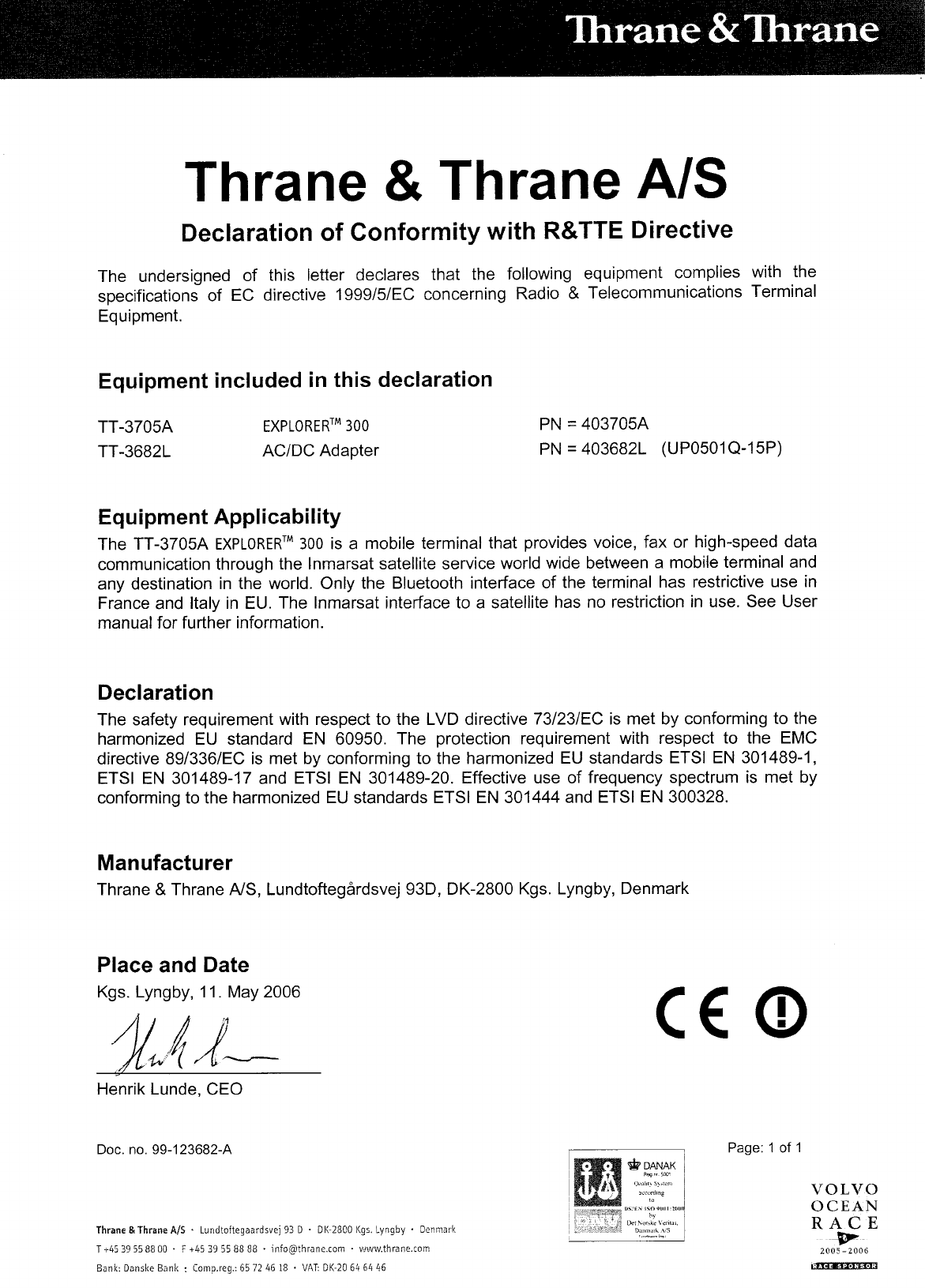

TT 98-123571-DraftA 139
Appendix B
AT commands B
In this appendix
This appendix contains a list of AT Commands for the EXPLORER™ 300.
Starting up an AT command session
Set up your computer to use the Bluetooth interface. For further information, see Using a
computer with Bluetooth on page 63.
Connect your computer to the Bluetooth interface of the EXPLORER™ 300 and launch your
terminal program.
The following section contains a list of commands that can be used with the EXPLORER™ 300. For
further information on the AT commands, refer to the following standards:
•ITU V.250 Serial asynchronous automatic dialing and control
•3GPP TS 27.005 ver. 4.2.0, Use of Data Terminal Equipment - Data Circuit terminating
Equipment (DTE-DCE) interface for Short Message Service (SMS) and Cell Broadcast Service
(CBS)
•3GPP TS 27.007 ver. 4.6.0, AT command set for User Equipment (UE)
3GGP standards are found on www.3gpp.org
ITU standards are found on www.itu.int

Appendix B: AT commands
TT 98-123571-DraftA 140
List of supported AT commands
Command Function
ATA Answer
ATD Dial
ATE Command echo
ATH Hang up
ATI Request identification information
ATL Monitor speaker loudness
ATM Monitor speaker mode
ATN Automode control
ATP Select pulse dialing (command)
ATQ Result code suppression
ATS Set register
ATT Select tone dialing (command)
ATV DCE response format
ATX Result code selection and call progress monitoring control
ATZ Reset to default configuration
AT&C Circuit 109 (Received line signal detector) behavior
AT&D Circuit 108 (Data terminal ready) behavior
AT&F Set to factory defined configuration
AT&V Display active and stored profile
AT&W Store profile
AT+CACM Accumulated call meter
AT+CAEMLPP eMLPP priority registration and interrogation
AT+CALM Alert sound mode
AT+CAMM Accumulated call meter
AT+CAOC Advice of charge

Appendix B: AT commands
TT 98-123571-DraftA 141
AT+CBC Battery charge
AT+CBST Select bearer service type
AT+CCFC Call forwarding number and conditions
AT+CCLK Clock
AT+CCUG Closed user group
AT+CCWA Call waiting
AT+CCWE Call meter maximum event
AT+CDIP Called line identification presentation
AT+CEER Extended error report
AT+CFCS Fast call setup conditions
AT+CFUN Set phone functionality
AT+CGACT PDP context activate or deactivate
AT+CGATT PS attach or detach
AT+CGCLASS GPRS mobile station class
AT+CGCMOD PDP context modify
AT+CGDATA Enter data state
AT+CGDCONT Define PDP context
AT+CGDSCONT Define secondary PDP context
AT+CGEQMIN 3G quality of service profile (minimum acceptable)
AT+CGEQNEG 3G quality of service profile (negotiated)
AT+CGEQREQ 3G quality of service profile (requested)
AT+CGEREP Packet domain event reporting
AT+CGMI Request manufacturer identification
AT+CGMM Request model identification
AT+CGMR Request revision identification
AT+CGPADDR Show PDP address
Command Function

Appendix B: AT commands
TT 98-123571-DraftA 142
AT+CGQMIN Quality of service profile (minimum acceptable)
AT+CGQREQ Quality of service profile (requested)
AT+CGREG GPRS network registration status
AT+CGSMS Select service for MO SMS messages
AT+CGSN Request product serial number identification
AT+CGTFT Traffic flow template
AT+CHLD Call related supplementary services
AT+CHUP Hang-up call
AT+CIMI Request International Mobile Subscriber Identity
AT+CIND Indicator control
AT+CLAC List all available AT commands
AT+CLCC List current calls
AT+CLCK Facility lock
AT+CLIP Calling line identification presentation
AT+CLIR Calling line identification restriction
AT+CMAR Master reset
AT+CMEC Mobile equipment control mode
AT+CMEE Report mobile equipment error
AT+CMER Mobile equipment event reporting
AT+CMGC Send command
AT+CMGD Delete message
AT+CMGF Message format
AT+CMGL List messages
AT+CMGR Read messages
AT+CMGS Send message
AT+CMGW Write message to memory
Command Function

Appendix B: AT commands
TT 98-123571-DraftA 143
AT+CMOD Call mode
AT+CMSS Send message from storage
AT+CNMI New message indication to TE
AT+CNUM Subscriber number
AT+COLP Connected line identification presentation
AT+COPN Read operator names
AT+COPS PLMN selection
AT+CPAS Phone activity status
AT+CPBF Find phone book entries
AT+CPBR Read phone book entries
AT+CPBS Select phone book memory storage
AT+CPBW Write phone book entry
AT+CPIN Enter PIN
AT+CPLS Selection of preferred PLMN list
AT+CPMS Preferred message storage
AT+CPOL Preferred PLMN list
AT+CPPS eMLPP subscriptions
AT+CPUC Price per unit and currency table
AT+CPWD Change password
AT+CR Service reporting control
AT+CRC Cellular result codes
AT+CREG Network registration
AT+CRSM Restricted SIM Access
AT+CSCA Service center address
AT+CSCS Select TE character set
AT+CSDF Settings date format
Command Function

Appendix B: AT commands
TT 98-123571-DraftA 144
AT+CSIL Silence command
AT+CSMS Select message service
AT+CSQ Signal quality
AT+CSSN Supplementary service notifications
AT+CSTA Select type of address
AT+CSTF Settings time format
AT+CSVM Set voice mail number
AT+CUSD Unstructured supplementary service data
AT+CAAP Automatic answer for eMLPP Service
AT+FCLASS Select mode
AT+GCAP Request complete capabilities list
AT+GCI Country of Installation
AT+GMI Request manufacturer identification
AT+GMM Request model identification
AT+GMR Request revision identification
AT+GSN Request product serial number identification
AT+ICF DTE DCE character framing
AT+IFC DTE-DCE local flow control
AT+ILRR DTE-DCE local rate reporting
AT+IPR Fixed DTE rate
AT+WS46 PCCA STD-101 [17] select wireless network
AT_IBLTH Bluetooth management
AT_IBNOTIFY Control the sending of unsolicited result codes
AT_IBTIF Bluetooth configuration
AT_IBTINQ Bluetooth inquiry management
AT_IGPS GPS location information
Command Function

Appendix B: AT commands
TT 98-123571-DraftA 145
AT_ILOG Retrieve log file from the EXPLORER™ 300
AT_IMETER Call metering
AT_INIS Network interface status
AT_IPOINT Antenna pointing
AT_ISIG Signal quality indication
AT_ITCSI Configure incoming voice quality
AT_ITCSO Configure outgoing voice quality
AT_ITEMP Temperature in the EXPLORER™ 300
Command Function

TT 98-123571-DraftA 146
Glossary
Glossary
A
APN Access Point Name. The Access Point Name is used by the EXPLORER™ 300 user to establish
the connection to the required destination network.
B
BGAN Broadband Global Area Network. A satellite network based on geostationary satellites,
delivering data rates of up to 492 kbps to virtually any part of the earth, with full UMTS (3G)
compatibility.
C
CE Conformitée Européenne. This term signifies that a CE certified product conforms to European
health, environmental, and safety regulations. In short, it makes the product legal to be sold
in the European Union.
CID Context IDentifier
D
DHCP Dynamic Host Configuration Protocol. A protocol for assigning dynamic IP addresses to
devices on a network. With dynamic addressing, a device can have a different IP address
every time it connects to the network.
F
FCC Federal Communications Commission. An independent United States government agency,
directly responsible to Congress. FCC certification is normally required to make a product
legal to be sold in the United States.
G
Geostationary Placed in a fixed position relative to a point on the surface of the earth.
GMPCS Global Mobile Personal Communications by Satellite. GMPCS is a personal communication
system providing transnational, regional or global coverage from satellites.

Glossary
TT 98-123571-DraftA 147
GMPCS-MoU A framework signed by Member States, GMPCS System Operators, Terminal Manufacturers
and Service Providers. The GMPCS-MoU mark allows GMPCS subscribers to take terminals
anywhere and use them in countries where they are licensed.
GPRS General Packet Radio Service. A standard for wireless communications which runs at speeds
up to 115 kbps, compared with current GSM (Global System for Mobile Communications)
systems’ 9.6 kbps.
GPS Global Positioning System. A system of satellites, computers, and receivers that is able to
determine the latitude and longitude of a receiver on Earth by calculating the time difference
for signals from different satellites to reach the receiver.
I
IMEI International Mobile Equipment Identity. A unique number given to every single piece of
mobile phone equipment. IMEI numbers are stored in a database containing all valid mobile
phone equipment.
IMSO International Maritime Satellite Organisation. An intergovernmental body established to
ensure that Inmarsat continues to meet its public service obligations, including obligations
relating to the GMDSS.
K
kbps kilobits per second
L
LAN Local Area Network. A system that links together electronic office equipment such as
computers and word processors, and forms a network within an office or building.
LaunchPad LaunchPad is a PC application used to control terminals in the BGAN system. LaunchPad is
provided on the Inmarsat CD-ROM supplied with your EXPLORER™ 300. Use of the
LaunchPad is described in the user guide on the CD-ROM.
M
MAC Media Access Control address. A hardware address that uniquely identifies each node of a
network.
MDI-X Medium Dependent Interface. An MDI-X (for MDI crossover) is a version of MDI that enables
connection between like devices. MDI ports connect to MDI-X ports via straight-through
cabling. MDI-to-MDI and MDIX-to-MDIX connections use crossover cabling.

Glossary
TT 98-123571-DraftA 148
N
NC Not Connected
P
Pairing Bluetooth Pairing happens when two Bluetooth enabled devices agree to communicate. The
two devices exchange passkeys and join what is called a trusted pair. In a trusted pair, the
two devices automatically accept communication with each other.
Passkey A unique code or password used when pairing Bluetooth devices.
PCB Printed Circuit Board
PDA Personal Digital Assistant. A lightweight, hand-held, usually pen-based computer used as a
personal organizer.
PDP Packet Data Protocol. A network protocol used by external packet data networks that
communicate with a GPRS network.
PIN Personal Identification Number. A code number used to provide access to a system that has
restricted access.
PUK PIN Unblocking Key. An eight-digit code used to unblock a SIM card after three incorrect PINs
have been entered. The PUK code is supplied with the SIM card.
R
RSSI Received Signal Strength Indicator
S
SAS Satellite Access Station. The gateway between the satellites and the worldwide networks such
as Internet, telephone network, cellular network etc.
SDU Service Data Unit. Also known as a data packet.
SIM Subscriber Identity Module.The SIM provides secure storing of the key identifying a mobile
phone service subscriber but also subscription information, preferences and storage of text
messages.
Streaming A technique for transferring data - such as audio or video clips - so that it is processed as a
continuous stream. With a Streaming connection you are charged by the minute, like for a
telephone connection.

Glossary
TT 98-123571-DraftA 149
T
TFT Traffic Flow Template. A packet filter list allowing the Core network and the EXPLORER™ 300
to classify packets received from the external network into the proper PDP context.
V
VPN Virtual Private Network. A network that is constructed by using public wires to connect nodes.
You can create networks using the Internet for transporting data, using security mechanisms
so that only authorized users can access the network.

TT 98-123571-DraftA 150
Index
Index
Numerics
2-wire interface
connecting, 51
specifications, 131
A
accessories available, 115
administration settings, 103
advanced configuration
Bluetooth, 93
LAN, 90
network settings, 99
alarms
in display, 45, 122
list of active, 44, 102
antenna
for Bluetooth, 133
pointing, 23
repointing, 39, 74
specifications, 134
APN
setting for all interfaces, 99
setting for Bluetooth, 93
setting for LAN, 90
applications overview, 6
AT commands, 139
audio indicators, 40, 87
automatic power up, 41, 86
Azimuth, 21
B
backlight in display, 39, 86
battery
charging, 113
guidelines for use, 113
inserting, 12
removing, 13
specifications, 129
BGAN
coverage, 2
services, 4
system overview, 3
Bluetooth devices
pairing, 50, 95
unpairing, 97
viewing list of paired, 97
Bluetooth handset
charging interface, 66, 135
connecting, 52
making a call, 54
Bluetooth interface
connecting a computer, 63
connecting a handset, 52
setting up, 93
setting voice quality, 93
specifications, 133
browser settings
for web interface, 68
C
call log, 38, 85
calls
holding, 58
local, 57
making or receiving, 54
missed, received, outgoing, 38, 78
redial, 56
view ongoing, 73
waiting indication, 57
CE compliance, 137
certification, 137
clearing logs, 105
clearing usage counter, 105
common network settings, 99
compliance, 137
configuration
Bluetooth, 93
exporting to file, 104
import from file, 105
LAN, 90
conformity, 137
connectors
Bluetooth handset charging, 135
LAN, 132
overview, 15
Phone, 131
Power, 130
contact information, 112

Index
TT 98-123571-DraftA 151
contrast in display, 39, 86
coverage
Inmarsat BGAN system, 2
D
dashboard, 72
data
advanced configuration, 99
Profiles, 106
Traffic Flow Templates, 109
data sessions
view ongoing, 73
delivery
items included, 11
DHCP
enable or disable for LAN, 90
display
backlight, 39, 86
contrast, 39, 86
menu drawing, 31
navigating, 34
overview of menus, 30
short-cuts, 34
symbols, 33
disposal, 114
distributors, 112
E
Elevation, 21
Ethernet interface
connecting, 61
setting up, 90
specifications, 132
EXPLORER™ 300
type number, ii
export configuration, 104
F
FCC compliance, 137
features, 5
G
general specifications, 128
GMPCS compliance, 137
GPS
antenna, 9
frequency, 134
obtaining GPS fix, 22
position, 42
troubleshooting, 118
view status, 42
H
hardware
view version, 72, 100
Header compression
enable or disable for Bluetooth, 93
enable or disable for LAN, 90
help desk number, 44, 111
changing with web interface, 111
I
IMEI number, 43, 72, 100
import configuration, 105
Inbox for SMS messages
replying, forwarding or deleting, 82
indicators
function, 8
interfaces
turning on or off, 40, 49
interfaces and services
combinations, 10
internal calls, 57
IP address, 43, 72, 100
items included in delivery, 11
L
LAN interface
connecting, 61
setting up, 90
specifications, 132
LaunchPad, 47
LEDs
function, 8
light and sound
disabling, 40, 87
light indicators
function, 8
local phone call, 57

Index
TT 98-123571-DraftA 152
logs
clearing, 105
M
MAC address, 43, 72, 100
matrix of services and interfaces, 10
messages
configuring outgoing, 83
deleting in display, 36
forwarding, 82
opening in display, 36
opening in web interface, 82
receiving in display, 45
receiving in web interface, 81
replying, 82
sending, 81
view list in display, 36
mobile subscriber numbers
viewing, 43, 72, 100
N
navigation
display and keypad, 34
web interface, 70
number of EXPLORER™ 300 terminal, ii
O
off-line
working with EXPLORER™ 300, 19
options available, 115
Outbox for SMS messages
resending or deleting messages, 80
P
paired Bluetooth devices
view list, 97
pairing Bluetooth devices, 50, 95
phone
local call, 57
making calls, 54
phone book, 75
add number, 76
delete all entries, 76
delete entry, 76
modify entry, 76
Phone interface
connecting, 51
specifications, 131
PIN
administration PIN, 103
entering in display, 20
entering in web interface, 71
entering with a phone, 53
pointing, 23
help, 21
position data, 21
repoint the antenna, 39
sound on/off, 40, 87
pole mount, 25, 115
POTS interface
connecting, 51
specifications, 131
power, 17
automatic, 41, 86
connecting, 15
specifications, 130
power up mode, 41, 86
Profiles
for data transmission, 106
selecting for Bluetooth, 93
selecting for LAN, 90
properties
view, 43, 72, 100
Proxy server
disabling, 68
PUK code, 20, 53, 71
Q
Quick dial, 54
R
redial, 56
restoring settings, 41
S
safety summary, iii

Index
TT 98-123571-DraftA 153
semi-fixed installation, 25
sent messages
resending, forwarding or deleting, 80
viewing status, 80
serial number, 43, 72, 100
services
supported by BGAN, 4
services and interfaces
combinations, 10
settings
restore, 41
Short dial, 54
SIM card
inserting, 12
removing, 14
specifications, 130
SMS in display
opening or deleting, 36
receiving, 45
view list, 36
SMS in web interface
forwarding, 82
opening, 82
receiving, 81
replying to, 82
sending, 81
SMS service number, 72, 84, 100
software
uploading, 101
view version, 72, 100
sound
alarm, 40, 87
message, 40, 87
when pointing, 40, 87
sound and light
disabling, 40, 87
specifications
antenna, 134
Bluetooth handset charging interface, 135
Bluetooth interface, 133
Ethernet interface, 132
general, 128
LAN interface, 132
Phone interface, 131
Power, 130
SIM card, 130
Standard data, 60
start-up
options, 18
status
methods for signaling, 122
viewing, 46, 72
stealth mode
activating, 34
enabling, 40, 87
Streaming data, 60
activating, 37, 60
defining Profiles for, 106
support
contact information, 112
T
telephone interface
connecting, 51
specifications, 131
total usage
viewing, 73, 77
Traffic Flow Templates, 109
troubleshooting guide, 116
type number of EXPLORER™ 300 terminal, ii
typography used in this manual, v
U
unpairing Bluetooth devices, 97
uploading software, 101
usage counter, 73, 77
clearing, 105
V
version
hardware, 43, 72, 100
software, 43, 72, 100
voice mail number
viewing, 43, 84
W
web interface
accessing, 67
browser settings, 68
definition, 67
navigating, 70